
|
|
The Classic Super Tigre Engines
The need for an English-language article such as this is underscored by the fact that there’s a certain amount of misinformation out there with respect to the early models designed by Garofali. As is unfortunately so often the case, a major offender is Mike Clanford, whose very interesting “Pictorial A-Z of Vintage and Classic Model Airplane Engines” frequently proves to contain incorrect or misleading information. The early Super Tigres which appear on page 179 are either incorrectly/incompletely identified or wrongly dated (or, in one case, all three!). I’ve said many times that Mike Clanford deserves great credit for putting together this always-engaging and frequently useful book, but the correction of the errors which it contains is an ongoing task.
First and foremost among these is Salvi Angeloni of Lodi, Italy. Salvi published a most informative summary of the early years at Super Tigre in Issue 121 (February 1996) of the indispensable “Engine Collectors Journal” which was edited by my late valued friend Tim Dannels. I freely acknowledge my indebtedness to Salvi for much of the background information to follow. My task was also greatly facilitated by the fact that the very positive reputation which the Super Tigre engines quickly secured for themselves beyond the borders of Italy ensured that the international modelling media took a close interest in the range as it developed. From the early 1950’s onwards, the design revisions and all-new models which continually appeared from this very prolific manufacturer were regularly covered in the English-language modelling press, as were the competition results achieved. This of course did much to inform my first-hand research for this article. That said, I have to apologise for the poor quality of some of the images that I was forced to use. Not having direct access to examples of many of the engines discussed in what follows, I’ve had to cull images as and where I could do so. A number of them are scans of 60-70 year old faded and low-resolution magazine images which appeared in magazine articles or advertisements. I’ve used such images where no alternative presented itself, the theory being that some kind of image is surely far better than none at all when illustrating a discussion point. Finally, I must point out that the sheer scope and scale of the output of this extremely prolific manufacturer is such that a detailed review of each and every model would require numerous articles of this length. Not having the time to prepare such a mass of material, I have chosen instead to present nothing more than a referenced illustrated overview of the range. The intent here is primarily to provide basic information on the various models and on the dates and context of their respective appearances. At some future date, I may get around to running a few tests on specific models for which no published data appears to exist or for which available data are inconclusive. However, that will be for later. It was of course necessary to establish a boundary for this article - life's simply too short to cover the entire Super Tigre range from its beginnings up to the present day. I have chose to restrict this article to coverage of the entire series of engines which were designated by the initial G (for Garofali) and the number of each particular model in the design sequence, as opposed to a number representing the engine's displacement. This period covers the range from the very beginning up to the early 1960's, when the last engine to be so identified, the Super Tigre G.33, made its appearance. The rest of the Super Tigre story remains for others to tell. To assist readers who may be in a hurry to date their engines, I've included an Appendix at the end of this article which lists all the models discussed here along with their introductory dates and most notable features. Now, before getting down to the task at hand I’ll take some time to summarize the background to the very early post-WW2 appearance of the engines designed and manufactured by Jaures Garofali. Background The concept of the model compression ignition (aka somewhat incorrectly “diesel”) engine goes back way further than many of today’s model engine enthusiasts seem to realize. In the past, it has often been claimed that the Swiss Dyno 2 cc model of 1941 was the “first” commercial model diesel. While that may be true in terms of widespread acceptance and design influence, the concept actually dates back to December 17th, 1928, when the first patent for a model compression ignition engine was granted to one Ernst Thalheim, a resident of Switzerland.
The ETHA engines were bulky, heavy and cumbersome. However, they were reportedly very competently constructed and ran well, thus proving the concept for all to see. This being the case, it was inevitable that others would follow Thalheim’s lead. The previously-mentioned Dyno 2 cc model manufactured in Alfligen, Switzerland by Klemenz-Schenk (whose primary business was the manufacture of bicycle lighting generators, hence the engine’s name) was one of the earliest spin-off products, being developed in 1940 and making its market debut in 1941. It was a considerable step forward from the ETHA designs, being both smaller and lighter as well as having a higher specific power output. As time went on, the Dyno became one of the most influential and widely-imitated early model diesel designs of them all.
Italy thus became one of the first nations after Switzerland in which the development of the model diesel concept was seriously pursued. However, the fact that this pioneering activity took place at a time of international conflict prevented any details of the Italian developments in this field from becoming widely known outside of Italy. Among those involved with model engine development during the wartime period was Jaures Garofali, a native of Bologna who had been born in 1920. In 1937 after leaving school, the 17 year old Garofali teamed up with his friends Valerio Ciampolini and a certain Signor Betuzzi to found a company called OSAM, which stood for Officina Sperimentale Apparecchi Motori (Aircraft and Engines Experimental Workshop). From the outset, Jaures Garofali took the lead in the engine design field. It appears that the The OSAM team soon began to put this rudimentary equipment to use in producing the first model engine designs to emerge from Garofali’s drawing board. The very first Garofali-designed engine was the OSAM G.1, a 3.5 cc spark ignition engine. Only four or five of these units are known to have been built. Mention of this engine’s model designation brings up the important matter of the model identification system applied throughout the “classic” era to the series of engines under discussion here. From the outset, Garofali used a sequential numbering system to designate his early designs. The engines all bore the letter G (standing of course for the designer’s initial) followed by a number representing the position of that model within Garofali's own design sequence. Hence this numbering system bore no relation whatsoever to the displacement of the engines. This was to cause considerable confusion in some market areas, eventually forcing its abandonment. The numbering protocol just described was to last for some 25 years right up to the appearance of the G.33 in 1964. Even before that date, however, the model identification system was in the process of being changed to include a number equal to the displacement in cubic inches, doubtless to facilitate sales in foreign markets such as America where the cubic inch displacement standard was generally followed. Returning now to the late nineteen-thirties, further designs soon flowed from Garofali’s drawing board, including the G.2, G.3, G.4, G.5, G.6, G.7 and G.8 models. Salvi Angeloni tells us that most of these designs never got beyond the drawing board stage, remaining in the realm of “though experiments” or paper exercises. However, a few engines were apparently built from time to time to test the effectiveness of specific design features. This was a period during which Garofali was refining his understanding of model engine design without as yet entering the commercial manufacturing field. Italy’s entry into WW2 on June 10th, 1940 caused a complete change in Jaures Garofali’s situation. Still only 20 years old at the time, his technical expertise was already such that he was excused military duty, instead being assigned to an Italian air force base, where he worked for the balance of 1940 and the whole of 1941 on research projects involving the use of the Aerodynamic Research Vertical Wind Tunnel which was located at the base. This facility was directed by Garofali’s OSAM colleague Valerio Ciampolini, with whom Garofali continued to work closely during this period. It appears that neither Garofali nor Ciampolini allowed their involvement in the Italian war effort to diminish their enthusiasm for models, since it was during this period, supposedly in his spare time, that Garofali built the first examples of his G.9 design, a spark ignition engine of 6.83 cc displacement. It’s abundantly clear that at the very least Ciampolini must have turned a directorial blind eye to this non-military activity! Only three or four engines were alleged to have been made at this time. One of them ended up in the hands of the prominent Italian modeller G. Ridenti, a leading figure in the Italian model competition field. In 1942, Garofali was transferred to the Forli Aeronautical Academy located about 80 km south-east of Bologna. Here he worked alongside Warrant Officer A. Pagliani and a certain Signor Zambianchi. Presumably with their knowledge and concurrence, if not their actual help, Garofali produced a number of additional examples of the G-9. Reportedly around eight more examples were produced during this period. Garofali also found time to draw up the designs of three further spark ignition models, the G.10, G.11 and G.12. However, these latter designs were destined to remain on paper only. We saw earlier that a few examples of the Swiss Dyno-1 diesel had somehow reached Italy despite the ongoing conflict of WW2. In early 1943, one of these examples came to the attention of Jaures Garofali, who was able to take a long hard look at it. Although all of Garofali’s model engine design experience up to this point had been with spark ignition motors, he was immediately intrigued by the compression ignition concept, instantly recognizing its advantages in terms of dispensing with the parasitic weight of the ignition support system as well as its inherently superior reliability given the effective absence of anything to go wrong.
It’s unclear how many, if any, examples of the G.13 were constructed at Forli. However, a return to Bologna in September 1943 following Italy’s formal surrender to the Allies changed Garofali’s employment situation to the point where further model engine building work had to be deferred in favour of economic survival. It was clear that any large-scale commercial ventures involving such products would have to wait until the whole of Italy was finally liberated from Benito Mussolini’s fascist regime and forced out of the war altogether. This did not take place overnight – although Italy formally surrendered to the Allies by signing the Armistice of Cassibile on September 3rd, 1943 following the Allied invasion of Sicily, the Germans immediately responded by occupying the country and attacking Italian forces at a number of locations. Moreover, Mussolini was still at large. The ensuing fighting was some of the most bitter of the war, with very heavy casualties on both sides. It was not until April 27th, 1945 that the City of Milan in Northern Italy was finally liberated, with the Italian campaign being formally ended a few days later by the April 29th signing of the instrument of surrender by the leadership of the German Army’s Group C. In the interim, Garofali found work with a Bologna company that produced espresso coffee machines, very popular in Italy. During his free time, he continued working on the OSAM G.13, managing to produce a few more examples of the engine. However, much of Italy had ceased to be directly involved in the conflict as of the liberation of Rome on June 4th, 1944. Thereafter the ongoing fighting was largely confined to the northern half of the country. This left a sizeable number of Italian citizens free to resume some of their pre-war activities. Among these were a surprising number of individuals who had ambitions to Among these early Italian diesels were the Alfa 1 of 1.86 cc displacement, developed by a certain Signor Mancini; the Antares 4 cc design; the Atomatic 1 cc and 4 cc models from Rome, developed by Uberto Travagli; the 2 cc P.O.2 diesel from Bergamo; the Giglio 2 cc model from Florence, developed by Signor Grazzini; the MOVO D-2 developed in Milan by Stelio Frati, Ermenegildo Preti and Gian-Luigi della Torre; and the Folgore LN 2 of 1.99 cc displacement from Cremona. Several additional models originated in Turin in the form of the Elia 4.2 cc unit and the Helium B.6 and C.6 designs of 6 cc displacement. Italy must accordingly be seen as a real hotbed of early model diesel development – all of these engines had appeared on the Italian market well before the first British commercial diesels made their debuts in mid 1946, as indeed did our subject Super Tigre range, albeit under a different name at this stage. The OSAM Era
Although Garofali was still living and working in his native Bologna, the G.13 was advertised and sold exclusively at this stage by Signor A. Castellani’s Aviomodelli company of 25 Via G. Grandi in Cremona, some 150 km north-west of Bologna. This company also marketed the Folgore LN 2. Interestingly enough, the OSAM G.13 was advertised with the Super Tigre name prominently attached from the outset despite the fact that the emergence of Super Tigre as an independent Bologna-based manufacturer did not come about until 1949, as we shall see in due course. One of the 24 examples of the G.13 somehow found its way to England, presumably in the hands of a British participant in the Italian campaigns of WW2. This engine may actually have reached England in the hands of Peter Chinn, who served in Italy in 1944-45 and later recalled bringing back a number of pioneering Italian engines at the end of the war.
In reality, the G.13 was a 5.28 cc unit, as noted earlier. According to Laidlaw-Dickson, this model was cited by its designer as being particularly well-suited to control-line applications. A claim of 10,500 RPM on the manufacturer’s specially designed control-line airscrew was cited – if true, pretty good going for an engine of this type and displacement. The most unusual feature of the G.13 was its unique mounting arrangement. The crankcase was equipped with two bolts on a vertical axis on each side, as clearly seen in the attached illustrations. These bolts supposedly allowed easier changing of down and side thrust settings, thus facilitating the trimming of a free-flight power model. Against that, the system certainly presented a few structural challenges for the model builder! Another out-of-the-rut feature by diesel standards was the use of a ringed light alloy piston, which may be clearly seen in the above cut-away advertising image.
Under the terms of Garofali’s agreement with Aviomodelli, the 1946 OSAM G.14, was produced and marketed by that company. Like its predecessor, the OSAM G.14 was advertised all along with the Super Tigre name prominently associated with it. At this point in time it would appear that the name Super Tigre was seen as a catchy and hence easily-remembered marque identifier rather than the official trade-name which it finally became in 1949. The OSAM G.14 was a 5.65 cc diesel which abandoned the sideport induction system used on the G.13 in favour of FRV induction. It did however retain the unique mounting system involving two bolts on a vertical axis on each side. A significant departure from contemporary standards was the new model’s use of short-stroke internal geometry. Bore and stroke dimensions were 20.0 and 18.0 mm respectively. Weight with matching airscrew was cited as 300 gm (10.58 ounces). The manufacturer stated that the engine would turn this matching airscrew at some 7,000 RPM, at which speed an output of 0.25 CV (around 0.246 BHP) was claimed. This claim has a ring of credibility to it.
From this time onwards, the new designs produced by the partnership carried the GB designation (Garofali-Boreani) preceding the sequential design number. The numerical design sequence was however continued unbroken. The partners established their own production facilities in Bologna, allowing them to manufacture all future models themselves. However, they remained on cordial terms with Aviomodelli, who continued to promote and market their products. Incidentally, this latter company was still producing kits and accessories for the model builder as late as 1996 and possibly longer.
In early 1947, OSAM produced an engine at the request of Aviomodelli which the store sold as a “house brand” under the name of “Uragano.” This engine had the same 6.28 cc displacement as the GB-15 and was broadly similar in overall appearance. However there were more than enough detail differences in the castings to readily distinguish between them. 1947 also saw the introduction of perhaps the most famous and popular engine ever to appear under the OSAM name, the OSAM GB.16. This was a very powerful 5.65 cc diesel which incorporated the first disc rear rotary valve (RRV) induction system to appear from this manufacturer. It also featured a single ball-race at the rear of the crankshaft journal. This engine was particularly well received by the Italian modelling community, who found engines from the USA to be prohibitively The OSAM GB.16 appeared in three distinct variants, with around 1000 engines being manufactured in total. The Mk. I variant featured a black crankcase, very small exhaust stacks, a rear induction system which screwed into the rear of the crankcase, a cylinder which was held in position by a screw-on head and a cutout bleed valve at the rear of the upper crankcase. Only around 50 examples of this version were built. The Mk. II variant as illustrated at the left was very similar to the Mk. I apart from having a natural finish on the crankcase and slightly larger exhaust stacks. The bleed valve at the rear can be clearly seen in this image. The Mk. III variant appeared in 1948. It represented the addition of a number of improvements to the previous models, sporting significantly larger exhaust stacks having a rectangular section, longer mounting beams and a more practical rear rotary valve assembly which was now attached to the case by three screws instead of being screwed in. A cutout valve was not supplied with the last examples of these engines, probably due to the increasing use of the GB.16 in control line stunt and speed models. Instead, the cutout mounting boss was blanked off with an appropriately-threaded screw-in plug.
The use of the engine was not confined to stunt competitions - at the 1948 Italian Nationals, the previously-mentioned G. Ridenti, who remained active as one of the father figures of Italian modelling, achieved the then-remarkable speed of 178 km/h (110.6 mph) with his GB.16 powered speed model using 60-foot lines. This constituted a noteworthy accomplishment for the time in question. Sparey’s comment about the worldwide popularity of the GB.16 is interesting insofar as the international model engine market had yet to open up at the time in question. Import and currency restrictions were in place in many countries as various economies struggled to recover from the effects of WW2. Accordingly, buyers outside of Italy must have gone to great lengths to acquire their examples. Sparey actually commented on this point in his published test of the G.19 and G.20 (see below), noting that imports to Britain required one to take out an Import License and pay taxes and duties amounting to as much as 50% Returning to our main thread, early 1948 also saw the appearance of the smaller OSAM GB.18, an RRV diesel of 2.82 cc and Garofali’s smallest design up to that point in time. For some obscure reason, the GB.18 was introduced to the market before the lower-numbered OSAM GB.17, of which the GB.18 was in effect a scaled down version. The GB.17 appeared slightly later in 1948. It was a very powerful 9.8 cc RRV diesel having a twin ball-race crankshaft. Its design layout generally followed that of the third variant of the GB.16 and the GB.18. Bore and stroke were 24 mm and 22 mm respectively. This design was highly unusual by contemporary diesel standards in that it continued to feature a lightweight two-ringed aluminium alloy piston. A peak output of 0.70 BHP @ 12,000 RPM was claimed by the manufacturer. During 1949, Jaures Garofali parted company with Mr. Boreani, who retained the OSAM name while Garofali retained control of the Super Tigre title. The OSAM company had a rather short life thereafter, producing only a few different engines. These were the OSAM 1700 “Lilliput” glow-plug engine of 1.7 cc displacement and a 2.5 cc OSAM 2500 model which appeared in both diesel and glow-plug versions. Jaures Garofali was not involved in the design of these models. Enter Super Tigre Having parted company with Signor Boreani, Garofali quickly established his own manufacturing facilities in Bologna and set about the further development of his model engine range. Since Boreani had retained the OSAM name, Garofali needed a new name for his company. He chose the soon-to-be-famous company title of Micromeccanica Saturno while continuing the use of the Super Tigre brand name to identify the products of his company. Hence "Super Tigre" is a brand name rather than that of the manufacturer. From this point onwards, the engines were marketed as members of the Super Tigre range, although they also bore the Micromeccanica Saturno company name.
Both variants of the G.19 were twin ball-race FRV designs which were built to the very high standard which Garofali had set himself to maintain. They continued the established Super Tigre design configuration of having twin exhaust stacks, one on each side. However, the two transfer ports were now located at the sides, being supplied through two large bypass passages located beneath the exhaust stacks. The four exhaust openings in the cylinder were arranged with one on each side of both transfer ports. Each of the four exhaust ports discharged through its own aperture in the exhaust stacks. The front end was a separate casting which was attached to the main crankcase by four screws. The backplate was cast integrally with the main crankcase.
Both variants of the G.19 were excellent engines which got the independent Super Tigre range off to a very good start. However, the next model to appear was the one which really put Super Tigre on the map. This was the G.20 glow-plug motor, which was destined to become one of the most famous and most widely-used Super Tigre engines of them all. In its various forms, the G.20 was flown by contest modellers all over the world for the next fifteen years, producing more than its fair share of contest wins in the process. The original version of the G.20 made its debut in 1950. This model had the distinction of being the first Garofali design to feature cross-flow loop scavenging. It utilized a sandcast crankcase with a square exhaust stack; a bolt-on front housing with provision for FRV induction; a single inboard ball bearing on the shaft; a finless head with the plug offset towards the bypass side; a conventional split thimble needle valve; and a light alloy baffle piston with two rings. Bore and stroke dimensions were 15 mm and 14 mm respectively, a combination of dimensions which was destined to become more or less a standard for Continental 2.5 cc motors. These dimensions yielded a displacement of 2.47 cc (0.151 cuin.). This early variant of the G.20 weighed in at a very modest 120 gm (4.25 ounces).
One weakness of the original G.20 that was never corrected prior to the 1957 introduction of the G.20 V version was its remarkably skimpy mounting lugs. The engine's layout was such that there was a greater than usual overhang between the prop and the lugs, which would give rise to elevated impact loadings during a crash (wot - me crash?!? Never....!!). The lugs did not take advantage of the full available length of the main crankcase casting, also being made relatively thin. These lugs would not do well in a hard crash. All such comments aside, by this time the reputation of the Super Tigre engines had travelled far beyond the borders of Italy. The resident model engine tester for “Aeromodeller” magazine, Lawrence H. Sparey, was sufficiently interested that, although Super Tigre engines were not generally available in Britain until several years later, he managed to gain access to examples of both diesel and glow-plug versions of the G.19 as well as an example of the early G.20 design. His test report on all three models appeared in the April 1951 issue of “Aeromodeller”. Sparey praised the robust construction of all three models (evidently overlooking the weak mounting lugs on the G.20!), also reporting them to be very easy to start. He found a peak output of 0.485 BHP @ 13,300 RPM for the glow-plug G.19 B model. While a little down on the manufacturer’s claimed figure of 0.56 BHP @ 15,500 RPM, this was still a highly respectable figure by 1949 standards. The difference was most likely due to Sparey's use of a low-nitro commercial fuel (Mercury no. 5) for his test - the factory doubtless used a more potent mixture to establish their figure. Sparey did not conduct a full test of the G.19 A diesel version, but voiced the unsubstantiated opinion that it should at least match the output of its glow-plug companion, albeit at a lower peaking speed. Sparey reported a peak output of 0.24 BHP @ 14,000 RPM for the G.20 glow-plug model, figures which closely approached the manufacturer’s claim of 0.25 BHP @ 15,500 RPM. He characterized these figures as “exceptional”, which they undoubtedly were by then-prevailing standards. Again, the difference between Sparey's figures and those of the factory are most likely down to fuel variations. At this juncture, our story arrives at a logical division point. From this time onwards, the design efforts of Jaures Garofali and his colleagues were divided between engines which were intended for all-out competition applications and those which were aimed at the less charismatic but far larger and hence potentially more lucrative “Sunday flier” sport market. It seems logical to embrace this split and to follow these two production sequences individually. I’ll begin with the classic Super Tigre competition models. The Classic Super Tigre Competition Engines We have already seen that Super Tigre’s first outright competition engines were the G.19 B and G.20 glow-plug models which first appeared in 1949 and 1950 respectively. The 5 cc G.19 B was soon replaced, as we shall see, but the 2.5 cc G.20 was subject to the incorporation of a long series of improvements scattered throughout an unusually lengthy production life. In what follows, I’ll attempt to place the design progression of this iconic engine in context. I'll also comment upon the companion 5 cc and 10 cc competition models where appropriate.
Both versions of the engine now featured pressure die-castings in place of the former sand-castings. Somehow the manufacturer managed to keep the weight of the "Speed" variant unchanged from that of its predecessor at just over 4 ounces. The head used on both models continued to be a plain unfinned component with the plug offset towards the bypass side of the cylinder. The flimsy mounting lugs were also carried over from the original sand-cast version. The 1952 "Speed" variant was tested by Ron Warring, whose report was published in the November 1952 issue of “Aeromodeller”. Despite some difficulties arising from a seemingly poor compression seal provided by the two piston rings (which presumably required some more bedding in), Warring found the engine to be an excellent runner once going. Using Mercury no. 7 fuel, he measured a peak output of 0.26 BHP @ 14,000 RPM, thus slightly exceeding the figure obtained the previous year by his predecessor Lawrence Sparey. It's highly probable that the use of the manufacturer's recommended fuel mixture containing 22% nitromethane would have improved these figures substantially. Althought at the time the 2.5 cc displacement category had yet to achieve World Championship status in the control line speed arena (see below), the engine did see service in international free flight power competition. At the 1952 World Free Flight Power Championships held at Dubendorf Aerodrome in Switzerland, contestants using this engine finished 3rd, 8th and 16th - a very good result.
A revised needle valve was also introduced at this time. The component used formerly had featured a conventional split thinble which was machined from hexagonal bar stock. This had evidently been found wanting, leading to the introduction of Garofali's highly individualistic thimble design having a large-diameter serrated barrel which was tensioned by a bronze leaf spring secured using one of the four front housing attachment screws. The thimble was internally threaded to match the spraybar, while the inner end of the barrel was recessed to clear the spraybar installation nut. Extremely neat, and it worked very well indeed. This assembly was used on both the G.20 and the companion G.21 glow-plug models for the next four years. The 1953 “Speed” variant of the G.20 was the subject of a test by Peter Chinn which appeared in the May 1953 issue of “Model Aircraft”. Chinn praised the quality of the engine’s construction very highly, characterizing the Chinn found the engine to be easy to start and adjust, with excellent running qualities. Using a fuel containing 25% nitromethane, he reported a peak output of 0.25 BHP @ 15,200 RPM, somewhat shy of the manufacturer’s claim of 0.29 BHP @ 16,500 RPM but certainly consistent with Ron Warring’s earlier findings. He summarized the engine as being “the fastest 2.5 cc engine yet tested”. To underscore this comment, Amato Prati of Bologna used one of these engines later in 1953 to establish a new Italian national 2.5 cc speed record of 161 km/hr (100.04 mph). In 1954, Jaures Garofali introduced a further modified version of the G.20 S which utilized a lapped cast iron baffle piston in place of the ringed light alloy component used up to that point. This was known as the Super Tigre G.20 S "Lappato". The result was a considerable performance improvement. Amato Prati used a stock example of the new lapped piston variant in his “Speed King” model to record a speed of 190.47 km/h (118.36 mph) at the 1954 Giornate Aeromodellistiche Ambrosiane meeting held in Milan, thus establishing a new FAI World Speed Record for the 2.5 cc class.
Having followed the development of the G.20 up to 1954, it’s now necessary to leave that model for a while and backtrack to 1951. The early success of the G.20 encouraged Garofali to develop what amounted to a 5 cc version of the same engine. This appeared in 1951 in the form of the Super Tigre G.21 glow-plug model, which replaced the old G.19 B design.
Unfortunately for Garofali, there was a significant difference in terms of the respective levels of competition which the G.20 and G.21 faced, at least at the outset. Until the mid 1950’s, the G.20 faced very little serious competition from other commercial producers of 2.5 cc competition engines. By contrast, the G.21 faced very stiff competition from the outset, having to compete with such established powerhouses as the Dooling and McCoy 29’s from America as well as the ever-improving ETA 29 from England. These were joined in 1954 by the excellent Micron 5 cc racing model from France. Despite this, the G.21 was a fine performer which achieved some notable results. In various forms, it was destined to continue in production for many years. The perceived importance of the 5 cc category at this time largely stemmed from the fact that this class was very prominent in the National competitions of many nations, including Italy, both in control-line and Open Power F/F categories. In addition, many International contests were still being run with a strong focus on this displacement class. The FAI had yet to adopt the 2.5 cc category as its standard for International competition. Indeed, the speed events at the prestigious International meeting held in 1950 at Knokke, Belgium had not even included a 2.5 cc category.
The 1952 World Championships were held at Brussels, again in Belgium. The same three classes were again offered, the winners being Britain’s Pete Wright in the 2.5 cc category at a speed of 158.590 km/hr (98.54 mph), using a modified example of the then relatively new E.D. 2.46 Mk. III “Racer” in glow-plug form, and Dr. Millet of France in the 5 cc class at a speed of 198.395 km/hr (123.28 mph), with Pete Wright a close second. Again, the Italians did not send an official team, although they were represented by a couple of individual entries in the 2.5 cc and 10 cc categories. Garlato of Italy finished fifth in the 2.5 cc class using his G.20 S to achieve a speed of 129.963 km/hr (80.76 mph), while Italy’s Guido Battistella of Venice won the 10 cc category outright with a speed of 233.766 km/hr (145.26 mph) using a Dooling 61, thus proving that Italy had some speed fliers of real talent. For 1953, a decision was taken that the control-line speed World Championships would be restricted to a single displacement category. Inexplicably, the 1953 Championship meeting which was held in Milan, Italy over the June 12th – 14th period was restricted to the least well-supported class, the 10 cc category. Consequently, only Britain, France and Sweden sent representatives to compete against the powerful Italian team.
However, the established engines still ruled the roost. Overall winner Battistella once again used his trusty Dooling 6l to achieve a winning speed of 250.000 km/hr (155.35 mph), narrowly beating Britain’s Ray Davenport‘s second-place mark of 244.897 km/hr (152.18 mph) using a Dooling-based Carter Special. Davenport evidently had an “off-day”, since he had previously recorded a speed of 255.412 km/hr (158.71 mph) at the 1953 British Nationals, which would have secured him a comfortable win at Milan. Enrico Fanoli finished third using a McCoy 60 Series 20, while Fiorini came in fourth with his G.24, returning a very creditable speed of 233.766 km/hr (145.26 mph) which equalled the previous year’s winning mark. Fiorini actually tied with third place Fanoli’s best speed but was relegated to fourth courtesy of a lower average for all attempts. Still, a very promising debut for the new model.
Since there was still some residual debate regarding the relative merits of glow-plug and spark ignition for large racing engines, the G.24 was made available in both forms. The illustration of the spark ignition version seen on page 179 of Mike Clanford’s previously-referenced book is incorrectly dated 1948. This engine was aimed squarely at the tether car, tethered hydroplane and control line speed fields, all of which were specialist markets which did not represent large sales potentials. The engine attracted a group of loyal adherents in Italy, hence remaining in limited production for some years, but it never had the opportunity to duplicate the fame and ongoing success of its smaller brother, the G.20, or even the 5 cc G.21. Consequently, it never achieved much prominence in the international marketplace. It is a very rare engine today.
However, an American contestant did show up this time, and to very good effect. The 5 cc World Championship class was won by Bob Lutker of Texas using a Dooling 29 to record a speed of 221.92 km/hr (137.90 mph). Pete Wright had to content himself with sixth place this time out with a speed of 200.03 km/hr (124.30 mph). He did however win the non-championship 2.5 cc class with a remarkable speed of 179.92 km/hr (111.80 mph), amazingly enough still using his well-tried E.D. 2.46 cc Mk. III Racer glow-plug powerplant. For context, this would have been just good enough to win the overall title at the following year's event in Paris (see below). Although not directly related to our main thread, it's worth mentioning that Bob Lutker also competed in the Control Line Stunt World Championship event at the same meeting, finishing second by only three points (1279-1276) behind the winner, Henri Stouffs of Belgium. A remarkable achievement by a great all-rounder! By the time 1955 came around, Signor Garofali had had enough of seeing his engines relegated to the sidelines while other makes dominated the winner's circle - he wanted to see Super Tigre sitting comfortably at the top of the heap! The FAI had finally decided that beginning in 1955 the World Championship for control-line speed would thenceforth be contested in the 2.5 cc displacement category. Here at last was a chance to show the world what the Super-Tigre G.20 S could do! Garofali set to work to improve the G.20 S as much as possible in anticipation of the forthcoming opportunity to display its merits to the modelling world.
The first World Championship event to be run under the new displacement rule took place on July 2nd - 3rd, 1955, at Croix-de-Berny, a few miles south of Paris, France. Garofali was instrumental in ensuring that a strong Italian team equipped with well-prepared examples of the latest Super Tigre G.20 S lapped-piston powerplants appeared at this meeting. Among other improvements, these 1955 engines featured revised cylinder heads (still retaining the offset plug location), along with a re-designed piston and rod. The new piston featured a large skirt port on the bypass side which registered at bottom dead centre with a matching port cut through the lower cylinder wall. This improved gas access to the bypass while also improving piston cooling and reducing reciprocating weight. The intake stub on the front housing now sported twin sets of transverse holes, one above the other, to allow for the fitting of either a conventional spraybar (as commercially supplied) or a two-piece racing-style setup with a separate surface jet and needle carrier threaded into opposite sides of a matching alloy venturi insert. Alternative venturi inserts were available to suit the two systems. The inserts were now made from aluminium alloy - the former plastic items were no longer used. This 1955 variant was later the subject of yet another published test, this time by Peter Chinn, whose report appeared rather belatedly in the March 1956 issue of "Model Aircraft" after this version had already been supplanted by the following design variant to be described below. Using the spraybar needle valve assembly along with a fuel containing 25% nitromethane, Chinn measured a peak output of 0.28 BHP @ 16,000 RPM - an outstanding performance for a commercial 2.5 cc glow-plug motor by the standards of 1955. The use of the two-piece racing needle valve and intake venturi (as likely employed at the Paris meeting) would doubtless have raised these figures considerably. Chinn also praised the engine's handling as well as its quality of construction. As events transpired, the hopes of the Italians for a clean sweep at the 1955 Paris meeting using this engine were derailed by the fact that this event coincided with the emergence of a new threat from the other side of the Iron Curtain. In October 1953 the Czech authorities had established an organization called the Modelářského Výzkumného a Vývojového Střediska (Modelling Research & Development Centre), better known by its initials of MVVS. The early history of the MVVS organization has been recounted in detail elsewhere. This organization was tasked with developing a series of individually-built specials which would power Iron Curtain modellers to International success, thus showcasing the technical capabilities of the Communist regime. The Centre had focused its initial efforts upon the 5 cc class, but the announcement of the switch to the 2.5 cc category for 1955 soon changed that. The Czech team showed up at Paris with a number of individually-constructed 2.5 cc powerplants which had emerged from the MVVS workshops in Brno.
Sladký’s success signalled the beginning of what might be termed the “works team” or “special” era in international control-line speed. Thenceforth there were in effect two distinct tiers of competitors – those using well-prepared examples of commercially-available engines and those using non-commercial individually-made “specials”. Events were to prove that the “specials” generally ruled the roost, with the commercial engines competing in what amounted to a separate category. As a commercial manufacturer having his eye upon the international market, Garofali naturally remained true to the second category, choosing to compete using individually-prepared examples of his own commercial products.
Barbini too saw the upcoming Florence meeting as a perfect opportunity to display the merits of the Barbini engines before both the Italian modelling public and the international audience. Working with an up-and-coming young Italian speed flier name Giovanni Cellini, he immediately began preparing and testing engines to be used at the contest. It’s worth noting at this point that the Barbini B.40 TN was one of only two then-current competition glow-plug engines (the other being the Webra 2.5R) which retained reverse-flow scavenging. The Barbini compounded this by also featuring long-stroke internal geometry. By this time all of the other front-running high performance glow-plug motors such as the Super Tigre and MVVS models were short-stroke designs which used the cross-flow loop scavenging arrangement pioneered in the USA during the 1940’s. Viewed in this light, Barbini’s competitors such as Jaures Garofali and the MVVS squad must have anticipated little threat from this “old fashioned” design. How wrong they were soon proved to be ……….. Whatever his views of the Barbini "threat", there could have been no doubt in Garofali's mind that he would face stiff opposition from the still-evolving tool-room specials from Czechoslovakia (as it was then) and elsewhere. Accordingly, for 1956 Garofali produced a further-improved version of the G.20 S. This updated model appeared around the same time as Peter Chinn's March 1956 published test of the earlier 1955 model.
The year of introduction of the revised case was clearly indicated by the numbers "56" cast in relief onto the right hand side of the upper crankcase below the exhaust stack, as seen in the accompanying illustration. The revised model retained the unique needle valve assembly which had been introduced in 1953. Tthe offset location of the plug towards the bypass side was maintained, along with the seemingly vulnerable mounting lugs. The new model also retained the lapped skirt-ported piston of its predecessor. However, many internal changes were incorporated. This new model was not long in proving its worth for all to see. At the 1956 Criterium of Europe meeting at Brussels, Belgium, held on April 30th - May 1st, which was in effect a tune-up for the later World Championship meeting, J. Battlo of Spain used his new 1956 G.20 S to achieve a speed of 202.0 km/hr (125.5 mph) to narrowly defeat Britain's future World Champion Ray "Gadget" Gibbs and his Carter-powered Nipper. And there was even more to come - on May 20th, 1956, another well-known Italian speed flier, A. Marconi, used one of these engines in his “Tajavento” (Wind Cutter) model to achieve the then-remarkable speed of 215.56 km/h (133.95 mph), which established yet another 2.5 cc FAI World Speed Record. Things were looking really good for that autumn World Championship meeting in Florence - based on its early competition successes, the revised design evidently represented real progress compared with its 1955 predecessor!
Given the attainment of such levels of performance, hopes must have run high for a good result at Florence. However, things did not go Garofali’s way at all at the meeting. Using a well-prepared but surprisingly close-to-stock Barbini B.40 TN, Giovanni Barbini’s colleague Giovanni Cellini finished in third place with a speed of exactly 200 km/hr (124.28 mph), beating all of the fancied Super Tigre and MVVS entries. Only the two one-off toolroom “specials” of Miclos Vitkovics of Hungary (BRMV Special) and Ray “Gadget” Gibbs of England (Carter Special) achieved higher speeds, with Gibbs winning at a speed of 211 km/hr (131.11 mph). At the same meeting, Gibbs subsequently established a new 2.5 cc World Record at a speed of 225 km/hr (139.81 mph) using thinner lines than those permitted in FAI competition, thus rubbing salt in the wound by eclipsing Marconi's previously-noted Super Tigre mark from earlier in the year.
The best Super Tigre-powered Italian team speed was Amato Prati’s sixth place mark of 194 km/hr (120.55 mph) using a well tweaked 1956 Super Tigre G.20 S. It is to be doubted that Jaures Garofali viewed this result in a positive light! However, Garofali could take some comfort from the fact that no fewer than 12 entrants out of a total of 28 were using Super Tigre G.20 powerplants at this meeting. This certainly underscored the international reputation and consequent popularity which the engine had attained. It was undoubtedly the most powerful 2.5 cc racing glow-plug unit then available to the general public. While all of this development of the G.20 had been taking place in the context of what was now the World Championship 2.5 cc class, its larger 5 cc G.21 companion had been quietly soldiering on. Although now out of the World Championship limelight, the G.21 had continued to enjoy considerable success in Area and National speed and open F/F power competitions, hence acquiring a high degree of popularity in its own right.
This variant utilized the same crankcase as the contemporary 1956 version of the 4.82 cc G.21, having an integrally-cast backplate with four "eyes" at the corners. However, it featured a new bolt-on front end with a bronze bushing taking the place of the former twin ball-races. In addition, the intake was now angled forward instead of being dead vertical. The lapped piston was retained in this variant. This model represented the first “crack in the wall” with respect to the Super Tigre model identification system. The ongoing use of the G.21 crankcase casting with its cast-on identification ensured that the G.21 name would continue. However, this model was aimed squarely at the emerging international market for control-line stunt engines in the .35 cuin. category, hence having the 35 suffix attached to its name. As time passed, this was to become an increasingly common form of Super Tigre identification, doubtless in large part to deal with the confusion which the former system had created in market areas such as America whose participants were accustomed to engines being identified by their displacements in cubic inches. To them, a G.21 was a 3.45 cc engine! The G.21/35 enjoyed the distinction of being the first stunt glow-plug model of its displacement to be marketed by a European manufacturer. Although according to Peter Chinn it was a somewhat less than stellar performer, it proved to be quite popular, being revised in 1957 by increasing its bore to 20.0 mm for a slightly increased displacement of 5.65 cc (0.345 cuin.), thus approaching its designated displacement. The 5 cc G.21 racing model continued unaltered at this point in time.
Interestingly enough, the Kometa was a copy of the original G.21 with integral backplate and ringed light alloy piston, although it did feature the "eyes" at the corners of the backplate which had been introduced by Super Tigre in 1956. As we saw earlier, Super Tigre had gone to a lapped piston for this model as early as 1954. Presumably the Russians had only an example of the earlier model to guide them, so that was what they copied. A lapped piston version of the Kometa was produced much later along with a diesel version. However, the engine never lost its integrally-cast backplate. In various forms, it remained in production up to the early 1990's, thus enjoying a 35 year production run. Meanwhile back in Italy, Jaures Garofali had by no means forgotten his drubbing in the 1956 World Speed Championships! He clearly possessed more than his share of Italian technical competitiveness, hence being unwilling to take this lying down. Work was immediately put in hand to develop a significantly further improved version of the G.20, which appeared in 1957 as the Super Tigre G.20 V in time to compete at the 1957 World Championship meeting held in August at Mlada Boleslav, a small town in Czechoslovakia (now the Czech Republic) located some 57 kilometres from Prague in MVVS’s back yard.
For the first time since the G.20 series had been introduced, the plug was centrally located instead of being displaced to the bypass side as in all former models. Compression ratio was unchanged at 8:1. A revised needle valve giving more precise mixture control was incorporated as well, using an externally threaded needle with a split internally-threaded spraybar and gland nut for tension. In addition, a number of internal improvements were also featured. My own test of an example of this model showed a peak output of 0.415 BHP @ 17,000 RPM using a fuel containing 30% nitromethane. This was more or less identical to the performance which I measured for the earlier G.20 S model of 1956, although my example of that model was undoubtedly better freed-up and may have been internally tweaked in addition. Still, the G.20 V was clearly a very sturdy performer. One structural feature to note if you ever have to dismantle the carburettor assembly on one of these engines is the fact that the spraybar is threaded into the venturi insert body on the needle side. People have been fooled by this into thinking that the spraybar was merely stuck in there by congealed castor oil residues. Not so - it has to be unscrewed from the fuel supply side. Attempts to push it out can potentially lead to damage being done. A set of parallel changes were also made to the companion 5 cc G.21 model at the same time to produce the G.21 V. The "V" in the designations of these engines reportedly stood for Super Tigre's "Victory Series" - a clear indication of expectations! Garofali showed up at the 1957 meeting along with the ever-faithful Amato Prati, who had both his own G.20 V powered model and a similarly-powered model which he flew proxy for Paolo Berselli. Giovanni Barbini was unable to attend personally, but once again sent Giovanni Cellini to uphold the honour of the B.40 TN, also supplying engines to both Renzo Grandesso of the official Italian team and England’s Pete Wright. Once again, things did not go as well as hoped for the Super Tigre squad. The Czechs and Hungarians filled the first five places with their MVVS and Alag tool-room specials, while the top “commercial” engine was once again the pesky Barbini B.40 TN, this time in the hands of Renzo Grandesso, who finished sixth as the highest-placed Italian team member with a very creditable speed of 206 km/hr (128 mph). However, using a prototype of the MVVS 2.5R-58, Josef Sladký achieved a winning speed of 216 km/hr (134.2 mph). This not only beat out Grandesso's Barbini but also totally eclipsed the best Super Tigre G.20 V speed of 198 km/hr (123 mph) which gave eighth place to the ever-persistent but doubtless frustrated Amato Prati. Paolo Berselli’s proxy-flown model came in just behind Prati with an almost identical speed. The feelings of Jaures Garofali at this point can best be imagined …………… it appeared that the new Super Tigre model had not advanced the cause at all.
This establishment was generally known by its initials MOKI, the full story of which has been recorded in a separate article on this website. Its first product was the Dooling-influenced 2.5 cc MOKI S-1 glow-plug model which was ready in time to compete in the 1958 World Control Line Speed Championships to be held once again in Brussels, Belgium. The 1958 Championship meeting at Brussels turned out to be a straight dog-fight between the MVVS and MOKI works specials from Czechoslovakia and Hungary respectively. The MOKI squad came out on top, taking the first two places, followed by three MVVS entries. This was a remarkable achievement considering that this was the MOKI S-1’s first-ever major contest. Top Italian was the sixth-placed Cesare Rossi (later of Novarossi fame), whose best Super Tigre G.20 V powered speed of 204 km/hr (126.76 mph) was no threat to Imre Toth’s winning mark of 216 km/hr (134.22 mph). Indeed, it represented only a very small advance over the best speed achieved by the G.20 V at the 1957 meeting. In their desperate efforts to surpass Toth's lead, several of the Italian and Czech team members resorted to highly questionable pylon tactics, going well beyond the "standard" continental technique of having the handle held in the pylon at a 40 degree angle to the lines. The extent to which they did so went beyond the patience of the event officials, resulting in the second-round disqualifications of one member each of the Czech and Italian teams. Not only was Kočí's handle held at such an acute angle to the lines that they were actually brought across his right shoulder, but Cesare Rossi actually used an outrigger attached to his handle! In both cases, the result was the shortening of the effective line length, thus reducing the distance covered during the timed laps. The need for an indicator projecting from the handle to visibly line-up the flier and his model was never more obvious. This episode was to be recalled at the 1960 event which will be discussed in detail below. Redemption finally came in 1959 at the tenth Criterium of Aces meeting held once again at Brussels, Belgium. Although not officially assigned the title, this meeting in effect constituted the World Championship event for 1959. At this event the further improved Super Tigre G.20 V’s finally broke through, with Ugo Rossi of Brescia winning at a much improved and very creditable speed of 222 km/hr (137.95 mph) and brother Cesare placing third at 210 km/hr (130.49 mph). Observers at the meeting noted with approval that Rossi's winning speed was achieved without a trace of whipping.
It's interesting to note in passing that Rossi would almost certainly not have won this contest had it not been for the misfortune suffered by Jaures Garofali's favorite entrant, his faithful employee Amato Prati. Garofali had carefully checked all of the engines in advance, giving the best of them to Prati. Sadly, Prati suffered a broken lead-out in flight at a very early stage, causing his model to crash. This destroyed both Prati's model and Garofali's best engine, leaving the way clear for Rossi to come through to win. All such misfortunes aside, this was an outstanding result in the face of the ongoing presence of the MOKI specials, which could only manage second and fourth places. The result was somewhat tempered by the fact that the MVVS "works team" did not contest this event, due in large part to the unfortunate circumstance that MVVS team leader Zdenek Husicka was then very ill after suffering a heart attack. This came at a time when the Institute was focusing upon the commencement of limited commercial series production of some of their designs, including the MVVS 2.5R-58. A hint of the effect that the presence of an Institute-backed MVVS team might have had on the results was the 193.9 km/hr (120.5 mph) speed achieved by K. Jaaskelainen of Finland to earn 6th place using one of the early production versions of the 2.5R-58 which he had somehow acquired. A highly creditable performance for a lone individual working without official support!
The 1960 World Control Line Speed Championship event was held at MOKI’s home base of Buadörs Airport near Budapest, Hungary. Having finally won the title fair and square in the previous year, as noted earlier, the Italian team was naturally very keen to repeat their success in 1960. They showed up at Buadörs with prototypes of the completely redesigned Super Tigre G.20/15V “Jubilee” engine, now featuring a one-piece crankcase and front end. This engine retained the radically new form of transfer porting which had first appeared at the 1959 event, complete with flat-topped piston lacking a baffle. The Italians arrived at the contest with the clear expectation that this remarkable new design should by rights be their ticket straight to the top of the podium. Unfortunately for the Italians' expectations, this event also saw the arrival on the World Championship scene of America’s Bill Wisniewski (1929-2007) with his remarkable 2.5 cc specials which were actually prototypes of the famous K&B 15R series of 2.5 cc racing engines which were to make their commercial debut in 1961. The Czechs also returned in force with their improved MVVS specials which had been absent the previous year. Now all of the top speeds in previous years had been achieved using two-line models. For 1960, the FAI had inspected and homologated the monoline systems which had been developed by both the Czechs and Americans and approved by FAI officials well in advance of the meeting at Buadörs. Having previously confirmed their legality under the rules, both teams naturally brought their approved monoline models to this meeting. It's important to note that quite apart from their prior approval by the FAI, these models all passed both technical inspection and pull-testing by FAI event officials at Buadörs prior to the commencement of the event itself. If there was a problem with the equipment's adherence to the rules, that was the time for it to be raised. In actual fact, no objections were identified, officially clearing both the Americans and Czechs to use their monoline equipment if they so chose. Despite experiencing some needling difficulties on his first official flight, Wisniewski still managed an average speed of 230 km/hr (142.92 mph) over the timed distance on monoline using a fuel later confirmed to contain the very effective but dangerous (and soon to be rightly banned) tetra-nitromethane. His maximum speed during the first few timed laps before the motor went "off" was estimated by experienced observers to be not far if at all short of 257 km/hr (160 mph)! As an interesting aside, Wisniewski's flight was unofficially timed by a number of attendees at the event. One of these was the late Kevin Lindsey, a future British speed flying great. He told his near neighbour Martin Radcliffe that he had begun timing Bill's flight but stopped the watch when the engine went "off" after a few laps. Up to that point the model had been averaging no less than 262 km/hr (163 mph)!! Jim Nightingale of the USA also experienced needling difficulties, but ended up right behind Wisniewski with an average first-round tetra-fuelled monoline speed of 227 km/hr (141.05 mph). The Czech team elected to fly their two-line models in the first round, with both Zbynek Pech and Jaroslav Kočí returning identical speeds of 213 km/hr (132.35 mph). Sadly, the first-round performances of the two Americans brought out the worst in the Italian team, whose need to win evidently overrode their sense of fair play and sportsmanship. Recognizing immediately that their two-line models powered by prototypes of what would become the Super Tigre G.20/15V "Jubilee" model (see below) could not match those speeds, they immediately protested against the Americans’ use of monoline despite the previously-noted fact that it had been formally homologated by the FAI prior to the meeting and had been inspected and approved by event officials at Buadörs prior to the first round. As stated earlier, if there was a problem under the rules with the American equipment, that was the time for it to be dealt with by the officials. The fact that this protest was only lodged after the officials had cleared the Americans to fly in the first round instead of at the outset revealed its motivation all too clearly. If it becomes clear that you can’t beat a competitor, find some way to get rid of him!! The Italian argument was evidently based on the idea that as sole users of the monoline technology at this event, the Americans were playing on a tilted field. Incredibly, this groundless protest was initially upheld, giving an unsavory appearance of the “fix being in”. A number of teams at the meeting registered strong disagreement with the ruling, to the extent that several threatened to withdraw if the ruling was upheld. However, it was left to the Czech team to directly underscore its unfairness by bringing out their own previously-approved monoline models for the second round, thus making the point that the technology was not only approved but was available to all, including the Italians if they so chose, and that the Americans did not in fact have a monoline monopoly even at this meeting. To further underscore the point, their switch did not improve their second-round speeds sufficiently to threaten either the Americans or the Italians. As a result of this very sporting gesture by the Czechs, the use of monoline at the meeting was reinstated, since the Czech action had demolished the “monopolistic” basis for the Italian protest and the alternative would have been to disqualify both the Americans and the Czechs. The threat of withdrawal by several other teams doubtless played a part in influencing this decision, since if the ruling had been allowed to stand the event would have dissolved into chaos and irrelevance, with the results becoming meaningless. Bill Wisniewski and Jim Nightingale both continued to experience difficulty in getting clean motor runs, although Bill had demonstrated to everyone's satisfaction that with a clean run over the full timed distance his "Pink Lady" was well capable of topping 250 km/hr (155 mph). Even so, his 230 km/hr first-round speed stood through the first two rounds and should have been good enough to win. On his second flight, Ugo Rossi had managed to equal Jim Nightingale's first-round speed of 227 km/hr (141.05 mph), but had to resort to some pretty strenuous whipping to do so. This mention of whipping makes it important to clarify the point that at this stage whipping was not specifically banned under the FAI rules then prevailing. In fact, the majority of contestants whipped their models up to considerably better than their "unassisted" speed before entering the pylon and immediately calling an attempt, continuing to whip as best the pylon would allow throughout their timed flights. Rossi was not alone in this by any means. In support of this impression, following the original appearance of this article in 2017 I was very pleased indeed to hear from Italian reader Gianni Mattea, who was an eyewitness to the event. At the time, young Gianni was in Budapest on holiday with some friends of his parents. As a keen enthusiast, he naturally persuaded his hosts to take him to the contest at Buadörs. He was present for all of the key flights described here. Gianni supported my comment that almost all of the speed competitors whipped to varying degrees. This certainly extended to the Czech team, Zbynek Pech in particular achieving both his third round contest speed and his subsequent World Record through the use of significant whipping of his monoline model. I said "almost all" because there were a few very notable exceptions, namely the American team with their monoline equipment. Gianni recalled that they were alone among the top competitors in not resorting to whipping during their timed runs. Setting aside the means by which it was achieved, Pech used his monoline model very effectively in the third round to match Rossi's whip-assisted second round speed of 227 km/hr (141.05 mph), thus moving past Nightingale, whose engine blew up midway through a partially-timed 240 km/hr (149 mph) third-round flight, giving him a zero score for that round since he didn't complete the 1 km distance. To place Pech's performance in context, it's worth repeating Gianni Mattea's eyewitness recollection that Pech achieved his third round contest speed through the use of significant whipping of his model. Once again, we have to remind ourselves that whipping was inexplicably not banned under the rules then prevailing. Gianni also voiced his own unsubstantiated impression that the Czech team may have somehow got hold of some tetra-nitromethane themselves, either from the Americans (perhaps as pay-back for their sporting gesture relating to the monoline equipment) or from some other source. His basis for raising this possibility (which is all that it is) is the fact that the speeds achieved at this meeting by the Czechs using the MVVS 2.5R/59 were consistently some 15 km/hr faster than those achieved using the same equipment both before and after the 1960 contest. In particular, the jump in Pech's speed from his second round 213 km/hr to his third round 227 km/hr seems to require an explanation. An interesting speculation, but one which will probably have to remain forever unresolved. Even so, the use of tetra-nitro by the Czechs would have been completely legal under the prevailing rules. Regardless, this put Pech into a second place tie with Rossi behind Wisniewski. It’s worth noting in passing that after the conclusion of the championship rounds Pech went on to set a new FAI World Speed Record of 244.6 km/hr (152 mph) using a thinner monoline that that permitted in the actual competition. Once again, Gianni Mattea witnessed this flight, recalling that some pretty strenuous whipping was involved. Pech's third-round achievement naturally acted as a further spur to Rossi's efforts. His exaggerated use of whipping in the second round had naturally been noted by those in attendance, the consequence being that all eyes were on Rossi to see what he'd try next when he came out for his third and final flight. By now the Italian team were clearly prepared to do anything to prevent Wisniewski from winning the individual title and to avoid sharing second place with the Czechs. Having failed to persuade the event officials to disqualify Wisniewski after the first round, and having learned in the second round that even whipping to the max did not result in a winning speed, they now resorted to outright cheating. Ugo Rossi’s third flight was marked by a degree of whipping so extreme that Rossi was actually wrapping his lines around his own right shoulder while supposedly in the pylon! In doing so, he was shortening his flight circle radius, as the attached image from “Model Aircraft” clearly shows. Incredibly, his "speed" of 236 km/hr (146.65 mph) was allowed to stand as the winning mark despite having been produced by flagrant line-shortening in clear contravention of the rules.
When the dust settled, the upshot was that Rossi had not won the title - it had been awarded to him by the FAI Jury. The impression of the fix being in was now so marked as to taint the entire meeting, with the reputations of both Italy and the FAI in tatters. This view of the matter was heightened by the recollection that Ugo Rossi's brother Cesare had been disqualified from the second round of the 1958 meeting for line-shortening using an outrigger attached to the handle, while Czech team member Kočí had also been disqualified in 1958 for using exactly the same line-shortening technique that Rossi used in 1960! If Kočí's action was illegal in 1958, then why wasn't Rossi's identical action just as illegal in 1960?!? Given the 1958 precedent, the impression of those at the 1960 event was that the Italians must have received assurances from the FAI Jury in advance that Rossi's third-round tactics would not lead to his disqualification despite their clear illegality. Otherwise, it seemed inconceivable that he would risk disqualification by flying in this overtly illegal manner. It's very much to the credit of a truly great champion and sportsman that Bill Wisniewski rose above the resulting morass of ill-feeling, refraining from stepping into the controversy and thus putting his Italian rivals to shame. After all, everyone (including Rossi and Garofali) knew who the champion really was .......and the Americans had taken the team trophy by a convincing margin, with the Czechs in a well-deserved second place ahead of third-place Italy and fourth-place Hungary. Rossi’s best speed without whipping and line-shortening was a still respectable 219 km/hr (136.08 mph). This would have given him seventh place in the final results just behind the officially seventh-place Super Tigre entrant, the clean-flying O. Stefano with a speed of 220 km/hr (136.70 mph), which should have given Stefano a well-earned sixth place but for Rossi's tactics. Stefano’s speed underscored the fact that this was about the best speed (and a very creditable one) that the Super Tigres could produce on two lines under the prevailing conditions without a “helping hand” (or in Rossi’s case a line-shortening shoulder). Consequently, although Super Tigre went into the record books as the winning motor at this event, very few event participants or modelling enthusiasts worldwide recognized this result as legitimate. I was one of them, and I still am even after the passage of 64 years. Rossi slunk away with his stolen trophy and a shredded reputation, while Bill Wisniewski returned to the USA with his sporting reputation enhanced and his head held high as the moral victor. I have personally always considered the great Bill Wisniewski to be the indisputable 1960 World Champion, and I’m very far from being alone. I also never bought a Rossi engine, even when it was the one to own ……… Rossi was never again to appear as a member of any Italian team at future championships. My Italian correspondent Gianni Mattea agreed completely with my assessment of Ugo Rossi's tactics, stating that he was well known in Italy and elsewhere as having "a very strong right arm". In Gianni's eyewitness opinion, Bill Wisniewski was undoubtedly the winner of the contest on the field. Taking the whipping out of it, he considered that a fair result would have been Wisniewski, Nightingale and Rossi in that order, since Rossi had shown in Brussels the previous year that he could potentially reach 225 km/hr without excessive "help" and could amost certainly have done so again in 1960 if he had given it a fair trial. Gianni discounted Pech's best speed because it too was apparently produced by whipping. Another eyewitness to this event was my late and much-missed Hungarian friend and colleague Ferenc "Somi" Somogyi. He was in attendance throughout as part of the organizing committee, which everyone agreed did a really superb job of organizing the event. However, they naturally had no influence over the decision-making by the FAI jury. After reading this article following its initial publication in 2017, Somi contacted me to state for the record that he fully agreed with Gianni Mattea - in his view, Bill Wisniewski was indeed the true 1960 World Champion.
The fact that Jaures Garofali and his colleagues accepted this “win” as legitimate undoubtedly did far more harm than good to the Super Tigre name as well as besmirching the sporting reputation of Italy in the eyes of the aeromodelling world. It would appear that the Italians’ overwhelming desire to win completely overcame their sense of fair play and sportsmanship on this occasion. This unsavory and highly regrettable incident remains the one blot on an otherwise stellar reputation. It’s extremely interesting to note that this was not the only example of gross FAI incompetence or bias at this meeting, nor were the Italians alone in displaying remarkably poor sportsmanship. The team racing event was similarly marred by controversy. Sweden’s Kjell Rosenlund convincingly won that event fair and square, only to have the opposing Belgian team protest his win on the grounds that he had put one foot over the line to retrieve his model! This of course had absolutely no bearing upon the result - a number of other contestants had previously done the same without penalty. However, incredible to relate, the Belgian protest was upheld by the FAI, handing the win to the Belgians, who earlier in the final had eliminated the British opposition by the simple and very direct expedient of colliding with Gordon Yeldham's model (which was 3½ laps ahead at the time) and causing it to crash. A British counter-protest on the basis of this collision was completely ignored by the FAI. The win was thus handed to the third place team. One really has to wonder what was going on at this meeting and what the Belgians thought this proved ……………… I've written at length about this sorry incident in a separate article to be found elsewhere ion this website. Subsequent to the original publication of this article in 2017, my valued friend and colleague Johnny Shannon was kind enough to contact me with some fascinating new information relating to this incident. I’ve always wondered why Bill Wisniewski didn’t protest the manifestly unjust result, and was keen to seek insights into this aspect of the matter. Happily, Johnny was able to throw a good deal of light on this issue. Many years ago, he had been fortunate enough to have had an in-depth discussion with Bill Wisniewski regarding this specific event. Bill was not the most talkative person under most circumstances, probably (in Johnny's opinion) because he was basically a rather shy individual. However, he did have an interesting take on Rossi's "win", which he shared with Johnny. At the 1960 Championship meeting, Bill quickly formed the objectively considered opinion that the Super Tigre G20/15V "Jubilee" powerplant, prototypes of which were used by the Italians at the meeting, was intrinsically superior to any baffle piston design, including Bill's own prototype K&B 15R unit. It took a certain largeness of mind to recognize and accept such a view of one's competitor. It was immediately clear to Bill that the Jubilee's porting and transfer arrangements together with a perfectly flat-topped baffle-less piston were far more efficient than anything else at the meeting. All things being equal, Bill honestly felt that Super Tigre had the best engine at the event. He evidently recognized that it was only the perfectly legal combination of monoline and tetra-nitromethane that had allowed him to record the speed that he did, thus beating the superior (in his view) Super Tigres. Bill also recognized the fact that even after the Czechs demolished the "monoline monopoly" argument, the Italians still viewed the USA team's use of tetra nitromethane as a form of “cheating”. It was, of course, absolutely nothing of the kind - at the time in question there were no fuel restrictions. The "cheating" perception evidently arose because only the US entrants had access to tetra-nitro. The Italian view of course flew directly in the face of Pech's achievement in almost matching Winsiewki's best speed without the use of that additive. Once again, the Czechs had demolished the Italian argument (if one discounts the completely unsubstantiated possibility that they too used tetra-nitro in the third round). In reality, the use of tetra-nitro was a mixed blessing, because Bill recalled that it made the engines next to impossible to set. They ran like smoke for a few timed laps and then went irretrievably lean or blew up! This explained why no American entrant was able to record a clean run throughout the timed distance. In reality, the Americans were working against the handicap of using tetra-nitro! Bill's speed was achieved in spite of this handicap. This is actually a strong argument against the possibility of the Czechs having used tetra-nitro in the third round. Sadly, the Italians were unable to accept the fact that the Americans had achieved the results that they had simply through the application of completely legal leading-edge fuel and control technology. That after all is how World Championships are won - find an edge and use it!! For his part, Bill was able to recognize and acknowledge the radically different cylinder porting of the Super Tigre G.20/15V as just such an example of leading edge technology, yet neither he nor anyone else protested the Italians on the basis that they alone had this technology. However, the Italians were unable to recognize and acknowledge Bill's fuel and control technologies in the same light, hence responding to Bill's legally-established speed from the first round by resorting first to an ultimately unsuccessful protest, then to unrestricted whipping and finally to outright cheating in the third round. They evidently viewed Rossi's line-shortening as an appropriate response to Bill's first-round performance, despite its clear illegality. Given the fact that Bill's figure had been established in full compliance with the rules (as witness the fact that he was allowed by the officials to retain his "second place"), this was clearly an unacceptable response on the part of the Italians, and one that should have resulted in Rossi's immediate disqualification. Even so, Bill told Johnny that he could understand the Italians' frustration, especially given his own objective opinion that the Italians had the best engines at the meeting. Fair enough, but it's one thing to express frustration in words - it's quite another to express it by cheating. The British protest was presumably ignored by the FAI because the British team had no representatives who figured in the results, hence being unaffected by Rossi's action in Championship terms. However, there's little doubt that if as the individual most directly affected, Bill had officially protested Rossi's third flight, a disqualification would have resulted - the photographic and eye-witness evidence of Rossi's cheating was (and remains to this day) irrefutable. The fact that Bill refrained from lodging a protest reflects enormous credit upon his sense of sportsmanship - by remaining silent, Bill (not the FAI) effectively awarded the championship to Rossi. As a die-hard engine man, he appears to have elected to allow what he personally considered to be the best engine to take the title. As an example of sportsmanship, this stands in sharp contrast to that displayed by the Italians. Following the initial publication of this article, I also had a very interesting exchange with my valued friend Luke Roy of H&R Speed Team fame. Luke found Bill Wisniewski to be reluctant to talk about that 1960 event, and had too much respect for Bill to press the issue - Johnny Shannon must have caught Bill in an unusually talkative mood! However, Jim Nightingale was apparently quite willing to discuss the matter with anyone who would listen! In Luke's recollection, Jim had little good to say relative to the governance of the 1960 event, the decisions that were (or weren't!) made, and how the Rossi situation in particular was so woefully mis-handled. Given the depth of Jim's feelings on the subject, Luke was actually surprised that Jim (and Bill) returned in later years. In Luke's recollection from his direct interactions with the leading speed fliers of the era, the fall-out from the 1960 event (not just in America) was sufficiently serious among the international speed flying community that the entire future of the championship was threatened for a time. This view was certainly endorsed by the Editorial staff of “Model Aircraft” magazine, which published a bluntly-worded Editorial statement on this contest in its November 1960 issue. After commenting on the inappropriateness of the Rosenlund exclusion and noting the fact that Rossi’s winning flight unarguably broke at least two of the FAI’s Code Sportif rules, the writer went on to state: “We are strongly of the opinion that all countries who consider aeromodelling a worthwhile sporting hobby should seriously consider whether the expense of sending teams to World Championships, when situations such as we have just described can arise, is justified”. The Editorial went on to state: “The incredible happenings in Hungary have, as far as we are concerned, proved to be the straw that broke the camel’s back. The time has come to stand up, not only for the rights of the average flier, but far more importantly, for the future and integrity of international competitions”. As history records, the event did survive, but the rules were drastically revised for 1961 to require the use of straight methanol/castor fuel (ending any complaints about tilted playing fields), to explicitly homologate the use of monoline and to expressly ban whipping outright. All of these measures were clearly intended to prevent a recurrence of the 1960 fiasco. However, despite the general opinion that the 1960 title had been improperly awarded, the official result of that contest was never reviewed and retroactively amended to reflect the true situation - an omission which stands to this day as a black mark on the FAI's record books. It was Luke Roy's personal opinion that the gross mishandling of this contest, including the FAI's inexplicable failure to set the record straight after the fact, had a permanent dampening effect upon the level of interest among US competitors in future FAI championship event participation. Johnny's discussions with Bill Wisniewski provide an interesting technical footnote to this story as well as suggesting another possible reason for Bill electing to allow the result to stand unchallenged. As noted above, Bill was most impressed with the Jubilee porting design, to the point that he very sportingly stood aside to allow it to "win" the contest. The thing that evidently impressed him most was the elimination of the piston baffle. When he got back to the USA, Bill immediately encouraged John Brodbeck of K&B to try to reach a deal with Jaures Garofali to manufacture the patented cylinder design under license from Super Tigre (see below for Patent details). It appears that a desire to pave the way for a successful conclusion to such discussions may well have been a major reason for Bill’s allowing the result to stand rather than antagonize the Italians by protesting. If so, the strategy failed. Bill told Johnny that Brodbeck did make very serious and repeated attempts to reach a deal with Garofali, but with absolutely no success. Bill always believed that residual bad blood from the 1960 World Championships was a major factor in blocking any such arrangement. One would think that the Italians would feel some sense of gratitude towards Bill for not protesting Rossi out of the result, as he could easily have done, but seemingly not so ........... Of course, the really great ones don't allow incidents of this nature to dampen their enthusiasm or impede their progress. Taking the view that "if you can't join 'em, beat 'em", Bill’s answer to the 1960 World Championship fiasco was to get right back down to work. In Luke's opinion, K&B's failure to reach an agreement with Super Tigre was directly responsible for goading Bill into developing his own alternative porting arrangement which allowed the elimination of the piston baffle. If Super Tigre wouldn't share their technology, Bill would develop his own! The eventual result was the appearance of the 1964 K&B 15RS (WART) engine with which Bill leap-frogged past the Super Tigre cylinder design to finally win the undisputed title of World Control Line Speed Champion. This was the first true Schnürle-ported model racing engine, and one which led the way directly into the future. Luke Roy reckoned that Bill only returned that year in order to show Super Tigre and the others that there was more than one way to skin a 'gator! This provides us with the truly fascinating insight that it may well have been Jaures Garofali's refusal to collaborate with K&B in 1960/61 that led directly to the development of the next-generation Schnürle-ported model racing engines, and by someone other than Super Tigre at that. Be careful who you wind up - they may return to haunt you!! Bill repeated this feat in 1966 with his TWA powerplant with which he won the title once again while unleashing the technology of tuned pipes upon the modelling world and unselfishly sharing the new technology in doing so - another stark contrast to Garofali's attitude. It's ironic to note that both Garofali and the Rossi brothers were among those who gladly adopted this innovation from the very man whom they had unapologetically cheated out of a title in 1960. Bill capped this off with a fine second-place World Championship finish in 1968 behind his compatriot Arnie Nelson. As I said earlier, true greatness will not be denied, and the memory of true greatness will never fade ...............
This engine highlighted an ongoing change in model identification policy at Super Tiger in that it included the engine’s displacement in cubic inches. The obvious intention was to eliminate the confusion which the former numbering system had created in markets such as America where customers were used to the identification of engines by their cubic inch displacements. The G.20/15V “Jubilee” owed very little to the design of its predecessor, the G.20 V. It dispensed with the detachable front housing in favour of a rather complex revised casting which incorporated the crankcase, exhaust stack, cooling fins and front housing in a single unit. Perhaps more significantly, it broke new ground in several aspects of its functional design. For starters, it used a flat-topped deflectorless piston, a first for a commercial cross-flow loop scavenged design. In addition, it adopted the rather radical approach of having the transfer and exhaust ports open simultaneously – another first in design terms, although some earlier designs had come close. The theory was presumably that any combustion gasses which went down the transfer port instead of out of the exhaust would have the effect of pressurizing the crankcase, which had no other outlet at this stage of the cycle. As soon as the exhaust process reduced pressure inside the cylinder, the pressurized gas in the crankcase would be forced very rapidly back into the cylinder. In a sense, the idea seems to have been to promote a form of crankcase supercharging.
Radical the new cylinder porting ideas may have been, but there’s no doubt that they worked! Setting aside Rossi’s highly tainted “victory” at the 1960 World Control-line Speed Championships, the G.20/15V was used very successfully in both diesel and glow-plug configurations by the Italian team at the 1960 World Power Championships held at Cranfield in England. It proved to be very popular in the USA, where it was distributed by World Engines Incorporated of Cincinnati, Ohio. In 1961 the engine was used to establish a new US National Class A control-line speed record of 143.1 MPH (230.3 km/hr).
Ron Warring of "Aeromodeller" magazine also tested the G.20/15 diesel, with his report appearing in the July 1961 issue of the magazine. Like Chinn before him, he praised the engine's quality and design very highly apart from feeling that the crankshaft was perhaps a little on the flimsy side at the front. He also found it to be a less than perfect starter, but was most complimentary about its performance, citing a measured peak output of 0.322 BHP @ 15,000 RPM and feeling that there was more to come with further running-in. Basically, Warring's test was a complete vindication of Chinn's earlier findings.
Even so, it was back to business as usual at the 1961 World Championship event held at Genk, Belgium over the September 15th – 17th period under the new fuel regulations. Speeds had naturally fallen way off, but the top three positions were once again taken by the Czech and Hungarian works “specials”, with Imre Toth again winning with his MOKI S-2 powerplant at a Johnny Shannon pointed out that the MOKI S-2 engine used by the Hungarians to win this contest was developed as a direct response to the Super Tigre G20/15V Jubilee. Designed by Gyula Krizsma, this exceptional engine was not so much a copy as an evolutionary improvement of the Super Tigre design. Even so, it was in clear violation of the Super Tigre patent on the porting, the drawing for which is attached here. The Hungarians were able to pull this off without challenge because the protection provided by this patent was not applicable in Hungary or Czechoslovakia. Patent protection for this design was only granted for Italy, Germany, Britain and the USA.
We have now followed the development of the Super Tigre racing engines as far as I intend to go in this article. By this time, much had changed in the model engine marketplace. The increasing dominance of the radio control market sector almost completely reversed the emphasis among model engine designers. The focus switched very much away from the development of ultimate power to the production of engines having good handling characteristics, excellent throttling capability and a high level of operational flexibility as well as the ability to take a muffler. The racing engine market was rapidly relegated to a comparatively minor role in the business plans of most commercial manufacturers, including Super Tigre. Having completed our survey of the classic Super Tigre competition engines, it’s now time to return to the early 1950’s to take a look at the company’s parallel activities in the sports engine field. The Classic Super Tigre Diesel and Sport Models Both the G.20 and G.21 models described in the previous section of this article were aimed at the serious competition modeller. However, during the same period just covered, the far more numerous sport flying community was by no means neglected. With the successful launching of the G.20 and G.21 competition models onto the world stage as of 1951, Signor Garofali next turned his attention to meeting the needs of the “Sunday flier”. Many of these individuals preferred to use diesels at this time.
A collector ring was cast into the upper crankcase to collect and discharge exhaust residues through an exhaust stack located on the right-hand side of the engine. This feature appeared to be derived from an examination of a Royal Spitfire .065 cuin. model from 1951. The con-rod was attached to the piston using a ball-and-socket joint. An example of the diesel version of the G.22 found its way into the hands of Ron Warring, whose test of the engine was published in the August 1953 issue of “Aeromodeller” magazine. After commenting favourably upon the engine’s very light weight (for its displacement) of only 50 gm (1.76 ounces), Warring turned his attention to the engine’s performance. He found it to be somewhat challenging to start, but an excellent runner once going, with great flexibility in terms of its control response. A peak output of 0.097 BHP @ 12,700 RPM was recorded on test. This was a very good figure by prevailing standards, and one which gave the engine an extremely favourable power-to-weight ratio.
Like its G.22 predecessor, the new Super Tigre model employed a screw-in steel cylinder having integrally-turned cooling fins. The female cylinder installation threads at the top of the crankcase were interrupted by two large bypass channels, one on each side. Unthreaded portions of both the cylinder and crankcase interior immediately below the cylinder installation flange combined to form an annular passage encircling the cylinder at that point. This annular passage in turn fed two large upwardly angled transfer passages located between the two rectangular exhaust ports and overlapping them to a significant extent. In effect this was a combination of the Cox transfer porting system with the OK bypass arrangements. The year 1954 saw the expansion of the Super Tigre diesel range with the introduction of a trio of plain bearing front rotary valve (FRV) diesels which applied the design arrangement of the G.23 to a range of different displacements. These were the G.25 of 0.95 cc displacement, the 1.49 cc G.26 and the 3.28 cc G.27. They all followed the design layout of the G.23 in all respects.
Chinn also mentioned having an example of the 1.5 cc G.26 model on hand. His condensed supplementary test of this model subsequently appeared very belatedly in the January 1956 issue of “Model Aircraft”. Chinn was clearly less impressed with this engine than he had been with the G.25, feeling that his G.26 may have been a “slightly sub-standard” example. While he found the engine to be a “satisfactory” starter and runner, he was only able to extract some 0.120 BHP from it at unspecified RPM, indicating a considerably lower specific output than had been measured for the G.25. Even so, this was a not unreasonable performance for a 1.5 cc sports diesel as of 1954 when it first appeared. It certainly matched contemporary British 1.5 cc sport diesels like the FROG 150 and Allbon Javelin.
Once again, Peter Chinn was able to get his hands on one of these fine little motors. His test of the 0.8 cc G.29 appeared in the October 1956 issue of “Model Aircraft”. Chinn commented upon the fact that the G.29’s bore and stroke measurements of 11.0 mm and 8.5 mm respectively gave it the highest bore/stroke ratio of any ½A motor then in production. As a result, he was not surprised to find that the engine peaked at a very high speed. He reported a peak output of 0.068 BHP @ 15,100 RPM, thus almost exactly confirming the manufacturer’s claim of 0.070 BHP @ 15,000 RPM. Needless to say, these were excellent figures for a 0.8 cc diesel as of 1955.
If the established model identification system had been continued without interruption, we might logically expect that the next model to appear on the market would display the G.30 designation. However, the next addition to the range as far as the modelling world at large was concerned came in August 1956 with the introduction of a high-performance 1.47 cc diesel which was oddly enough designated the G.31, thus apparently skipping a model number in the sequence. The appearance of the G.31 at this date is confirmed by the publication of a detailed description in the September 1956 issue of the Italian "Rassegna di Modellismo" (Modelling Review) magazine.
The cylinder porting was now more or less a clone of the Cox system, with two internal transfer flutes interposed between twin exhaust apertures. The former annular bypass passage and twin bypass feeder passages were thus eliminated, significantly reducing the engine’s crankcase volume. As usual, Peter Chinn soon managed to get his hands on an example of the G.31. His test report on the engine appeared in the November 1957 issue of “Model Aircraft”. Chinn spent some time describing the G.31’s unusual design features, also commenting favourably upon its quality. He found the engine to be “an easy starting motor” having “favourable handling characteristics”. He reported a peak output of 0.161 BHP @ 16,000 RPM, which he rightly characterised as “one of the best performances we have obtained for a 1.5 cc engine”. In a 1957 context, this was undoubtedly true, although this performance came at the cost of greater-than-average weight and complexity. Overall, Chinn was clearly very impressed with this model. The one really glaring deficiency with this design was the seemingly undernourished size of the mounting lugs together with the very narrow longitudinal spacing of the mounting holes. I will admit to never having flown my example because I always felt that a crash of any consequence would almost inevitably break off the lugs - I'm not a good enough flyer to avoid such impacts! I gather from a number of posts on the various modelling forums that I’m not alone. I actually encountered an example some years ago that had suffered in just this way.
It actually appears likely that the 1956 G.30 test units had proved to be satisfactory. However, the release of the G.30 in production form was delayed while Garofali developed the design of the companion 1 cc G.32, which was in essence a scaled-down version of the 2.5 cc G.30 (see below). The two clearly-related models could thus be released more or less concurrently in the second half of 1957. The more familiar variant of the G.30 which finally appeared on the international market in October 1957 seems to have been externally identical to the 1956 model apart from the application of a red anodized finish to the cooling jacket. Of course, there may well have been internal modifications on the basis of experience gained with the 1956 units. Assuming that its initial design dated from mid 1956, the 2.5 cc Super Tigre G.30 diesel was a very different design from any of its predecessors as of that date. It featured the combination of a rear drum valve induction system with a twin ball-race crankshaft which had first been applied to a Garofali design in the 10 cc G.24 racing engine of 1953 and was also featured in the design of the previously-discussed G.31 model. Moreover, its cylinder porting was basically the same as that featured in the earlier diesel models from the G.23 through G.29, with twin upwardly-angled transfer ports located between twin exhaust apertures.
Once again, the ever-informative Peter Chinn was there to conduct a test of this engine. His report appeared in the March 1958 issue of “Model Aircraft”. He characterised the engine as a “finely made” unit which clearly belonged in “that small, select group of 2.5 cc diesels which, for want of a better definition, we shall call “world class””. He found the engine’s handling qualities to be “very pleasing”. However, reading between the lines, it would appear that Chinn was somewhat disappointed in the engine’s performance. He found a peak output of 0.285 BHP at the unusually high speed (for a diesel) of 16,000 RPM. While he characterized this as being “a very good maximum figure”, he refrained from pointing out that a number of other competition diesels had exceeded this figure by late 1957. Chinn did his best for the manufacturer by citing the factory performance claim of 0.31 BHP @ 18,000 RPM, stating his belief that such a figure might be achievable with “a good example working under favourable conditions”. I can only say that a preliminary test on my example of the engine conducted way back in 1997 strongly supported the manufacturer’s claims. In fact, that long-ago test implied a peak output of around 0.340 BHP @ 16,500 RPM. A full latter-day test of my own example amply confirmed this high level of performance. Full details of this test appear elsewhere on this website. The obvious application of the G.30 was in FAI team racing, and indeed the engine found its way into the noses of many FAI team race models in the late 1950’s, giving a good account of itself in the process. However, it failed to knock the Oliver Tiger off its accustomed perch at the top of the results sheets. Even so, it remained in production until mid-1960, when it was replaced by the very successful G.20/15 “Jubilee” diesel which was discussed earlier in the preceding “Competition Engines” section of this article.
The October 1957 introduction of the G.30 is readily explained as an expression of Jaures Garofali’s understandable desire to cover all of the competition bases by adding a competitive team race diesel to his range. It’s less easy to fathom the motivation for the next model to appear. This was in effect a 0.95 cc version of the G.30 which appeared almost simultaneously in late 1957 as the G.32. This fine little engine (one of my personal favourites!) was more or less identical to the G.30 in terms of its design layout. The only real departure was the use of a single inboard ball-race instead of the twin ball-races used in the G.30. Both “Aeromodeller” and “Model Aircraft” published test reports on this very complex little 1 cc diesel. The engine’s complexity was all the more remarkable given the fact that there was no competition class for 1 cc engines. The resident testers of the two magazines were very keen to determine the extent, if any, to which all that complexity had paid off.
Warring commented repeatedly upon the excellence of the workmanship displayed in the engine. However, he also noted its unusual complexity, drawing the rather negative summary conclusion that one got “nothing at all” for the engine’s extra features. One can’t quite escape an uncomfortable feeling that Warring was looking for ways in which to present this engine in a less favourable light than he had accorded earlier to its British competition. As an example, he failed to note that his performance figure actually exceeded the manufacturer’s claimed peak output of 0.089 BHP, which would have reflected very favourable upon Jaures Garofali’s integrity. For my own part, I’ve used this engine myself with great satisfaction. It has far more substantial mounting lugs than the larger G.31, hence inspiring a higher level of confidence. The example that I’ve flown is more than a match for both the A-M 10 and the FROG 100 Mk. II, although it can’t get up to the dizzy heights scaled by my example of the Barbini B.38, which is reported in my separate article on the Barbini engines. I’ve always viewed Warring’s characterization of the engine as being somewhat biased. We’re all human, after all……. In Warring’s defence, it must be stated that the G.32 fared no better in the hands of Peter Chinn, whose report on the engine appeared in the March 1959 issue of “Model Aircraft”. Chinn began by citing the manufacturer’s performance claim as a preliminary to noting that his example fell somewhat short of achieving those figures. He speculated that he might in fact have a sub-standard example. Certainly, he was only able to report a peak output of 0.079 BHP @ 13,000 RPM. Like Warring before him, he also commented upon the engine’s complexity.
Before concluding this discussion of the closely-related G.30 and G.32 models, it appears to be worth mentioning the strong likelihood that the success of the competing Barbini B.40 TR diesel (Testa Rossa, or Red Head - a diesel version of the B.40 TN) and its smaller 1 cc diesel companion, the Barbini B.38, were instrumental in stimulating the creation of the Super Tigre G.30 and G.32 diesels. Although their main bearing and induction arrangements differed substantially and their bypass capacity was The fact that they were the only two Super Tigre models to adopt the Barbini cylinder design in its entirety (even including the red anodizing) while also having the same displacements as the two Barbini models adds credence to the admittedly unsubstantiated notion that they were introduced as a direct response to the success of the Barbini offerings. The extent to which Garofali evidently felt impelled to ensure a performance superiority over the Barbini competition is clearly demonstrated by the lengths to which he went to ensure high performance – the single ball-race G.32 in particular is amazingly complex for a 1 cc design given the fact that there was no competition class for this displacement category. There was of course a cost to all that complexity – the G.32 is both significantly more bulky than its B.38 rival and over 50% heavier at 86 gm (3.03 ounces). Moreover, my own tests have demonstrated that a good example of the Barbini B.38 was more than a match for the G.32 in performance terms. It would appear that in this particular contest Garofali came up a little short. Conclusion With the G.32 we’ve almost brought the story to the end of the long series of Garofali designs which bore their numbers in the design sequence as opposed to their displacements. That was my goal at the outset, and now it's acomplished.
By this time, the R/C field and the American market had both become predominant. This led to the release of new models such as the S.T. 51 R/C (1960), the S.T. 56 R/C (1962) and the S.T. C.35 (1962) which adopted American identification protocols while replacing the former G designation with the initials S.T. standing for Super Tigre. All of the engines which followed the G.33 (as well as some which preceded it) were identified by their displacements in cubic inches. The latter numbering was applied even to the ongoing designs such as the G.20 and G.21, which now bore designations such as G.20/15, G.20/19, G.20/23, G.21/29, G.21/35 and G.21/45. It’s true that a Schnuerle-ported Super Tigre G.34 R/C model appeared many years later, but in this case the 34 referred to the engine’s displacement of 0.34 cuin (5.5 cc) rather than to any design sequence. Jaures Garofali remained very active with the company well into his seventies. He finally passed away in 2009 at the age of 89 years, leaving us with a legacy of some of the finest commercially-produced model engines ever to be offered to the modelling public. Life being as short as it is, I’ve now come to the end of the journey on which I’ve taken you through the first two decades or so of the Super Tigre range up to the point where the R/C market took over from the performance market as the main preoccupation of Micromeccanica Saturno and its talented designer Jaures Garofali. The story of the later Super Tigre engines will be left for others to write. Meanwhile, I hope that you enjoyed this trip down Memory Lane as much as I did in researching it! ___________________________________ Article © Adrian C. Duncan, Coquitlam, British Columbia, Canada First published September 2017
Appendix For convenient reference, I’ve prepared the following table showing the dates and main identifying features of all of the classic commercial G-numbered models mentioned in the above text. I hope that you find it useful!
|
||||
| |
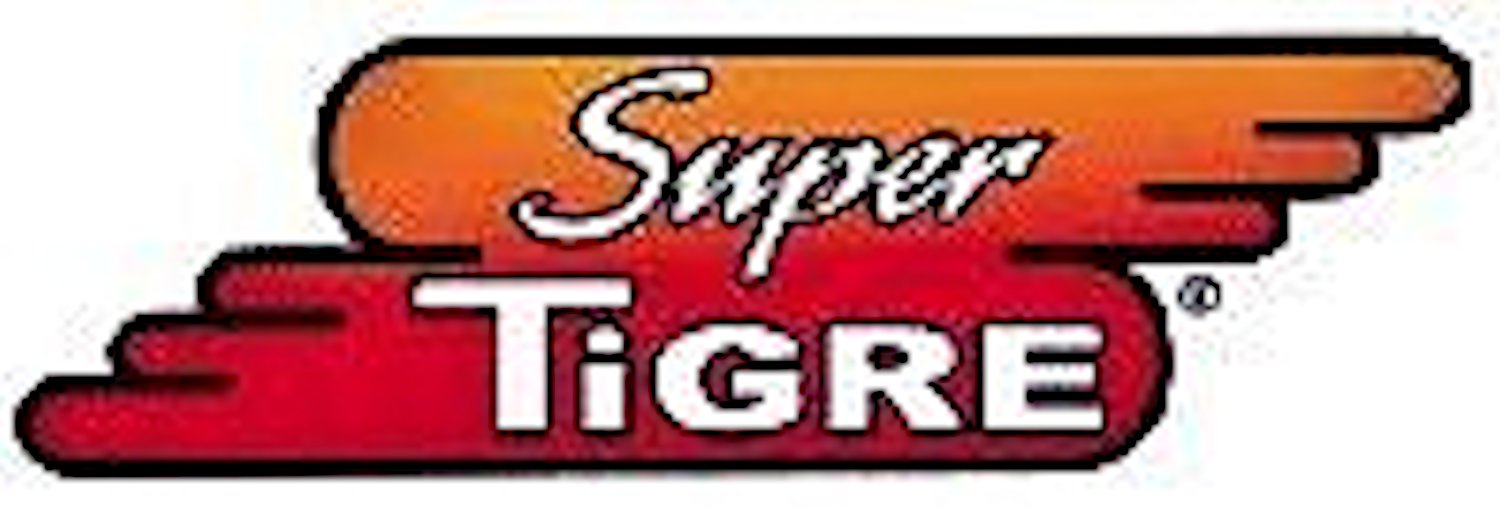 In this article, I’ll present a summary of the famous Super Tigre model engine range from Bologna, Italy during its manufacturer's first two decades of production. These iconic engines were the brainchild of one of Italy’s foremost model engine designers, Jaures Garofali (1920 - 2009). The details of his story are apparently well documented in Italy, but appear to be less widely-disseminated in the English language. Time to remedy that deficiency!
In this article, I’ll present a summary of the famous Super Tigre model engine range from Bologna, Italy during its manufacturer's first two decades of production. These iconic engines were the brainchild of one of Italy’s foremost model engine designers, Jaures Garofali (1920 - 2009). The details of his story are apparently well documented in Italy, but appear to be less widely-disseminated in the English language. Time to remedy that deficiency! Of course, it goes without saying that in writing about a model engine range from a non English-speaking country in which I have never lived and whose language I do not speak, I’m skating on relatively thin ice! There is simply no way that I could have reached first base on this task without the help of Italian friends and colleagues.
Of course, it goes without saying that in writing about a model engine range from a non English-speaking country in which I have never lived and whose language I do not speak, I’m skating on relatively thin ice! There is simply no way that I could have reached first base on this task without the help of Italian friends and colleagues. 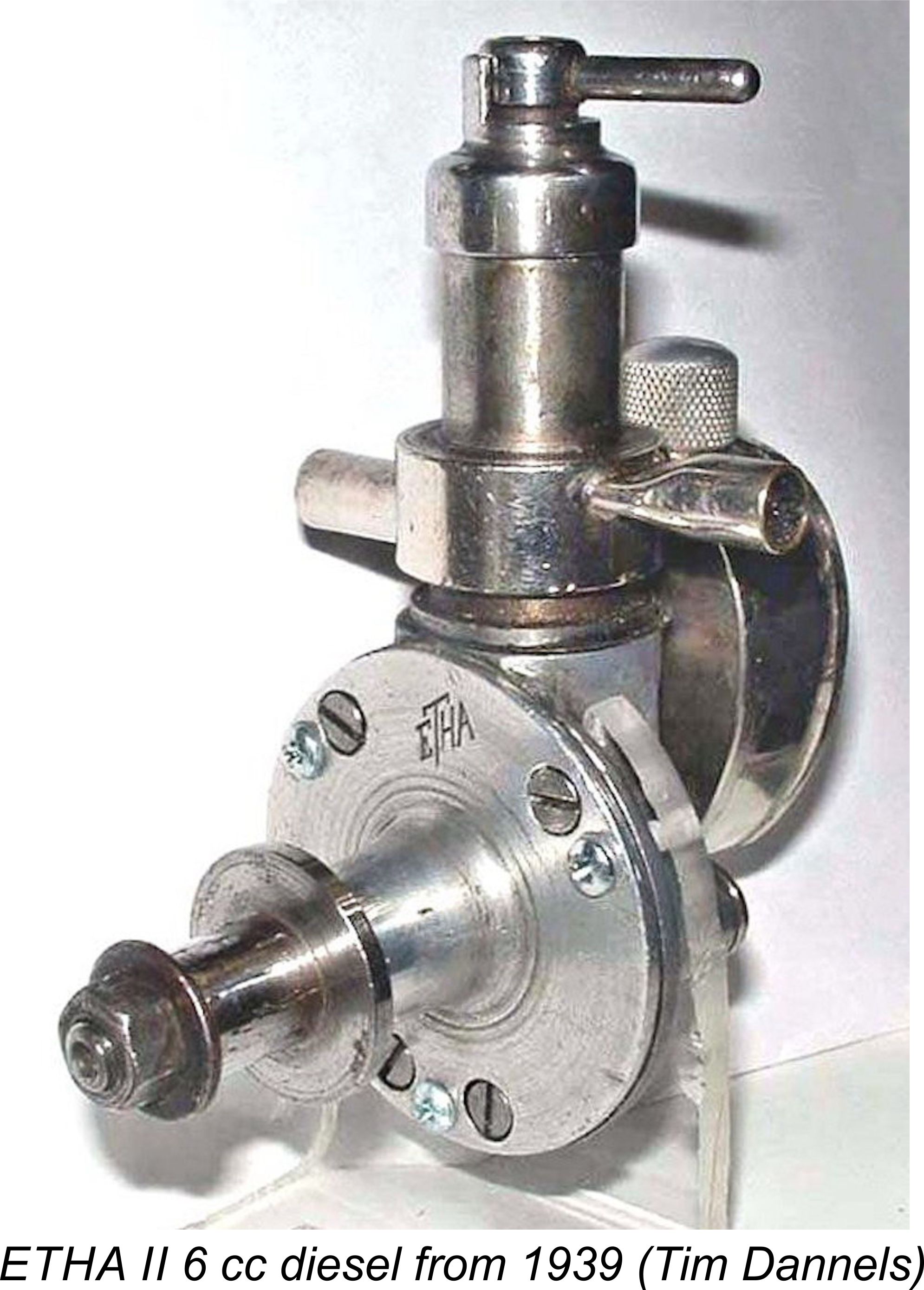 Some ten years later, Thalheim went into production with a series of engines which were marketed from 1938 onwards under the ETHA label, derived of course from Thalheim’s name rather than from a primary ingredient of the engine’s fuel! These appear to have been the world’s first commercially-produced model diesel engines. It’s a bit of a mystery why it took Thalheim ten years to actually begin to capitalize upon his patent ……. in all probability the Great Depression which began in 1929 immediately following the issuance of the patent had something to do with it.
Some ten years later, Thalheim went into production with a series of engines which were marketed from 1938 onwards under the ETHA label, derived of course from Thalheim’s name rather than from a primary ingredient of the engine’s fuel! These appear to have been the world’s first commercially-produced model diesel engines. It’s a bit of a mystery why it took Thalheim ten years to actually begin to capitalize upon his patent ……. in all probability the Great Depression which began in 1929 immediately following the issuance of the patent had something to do with it.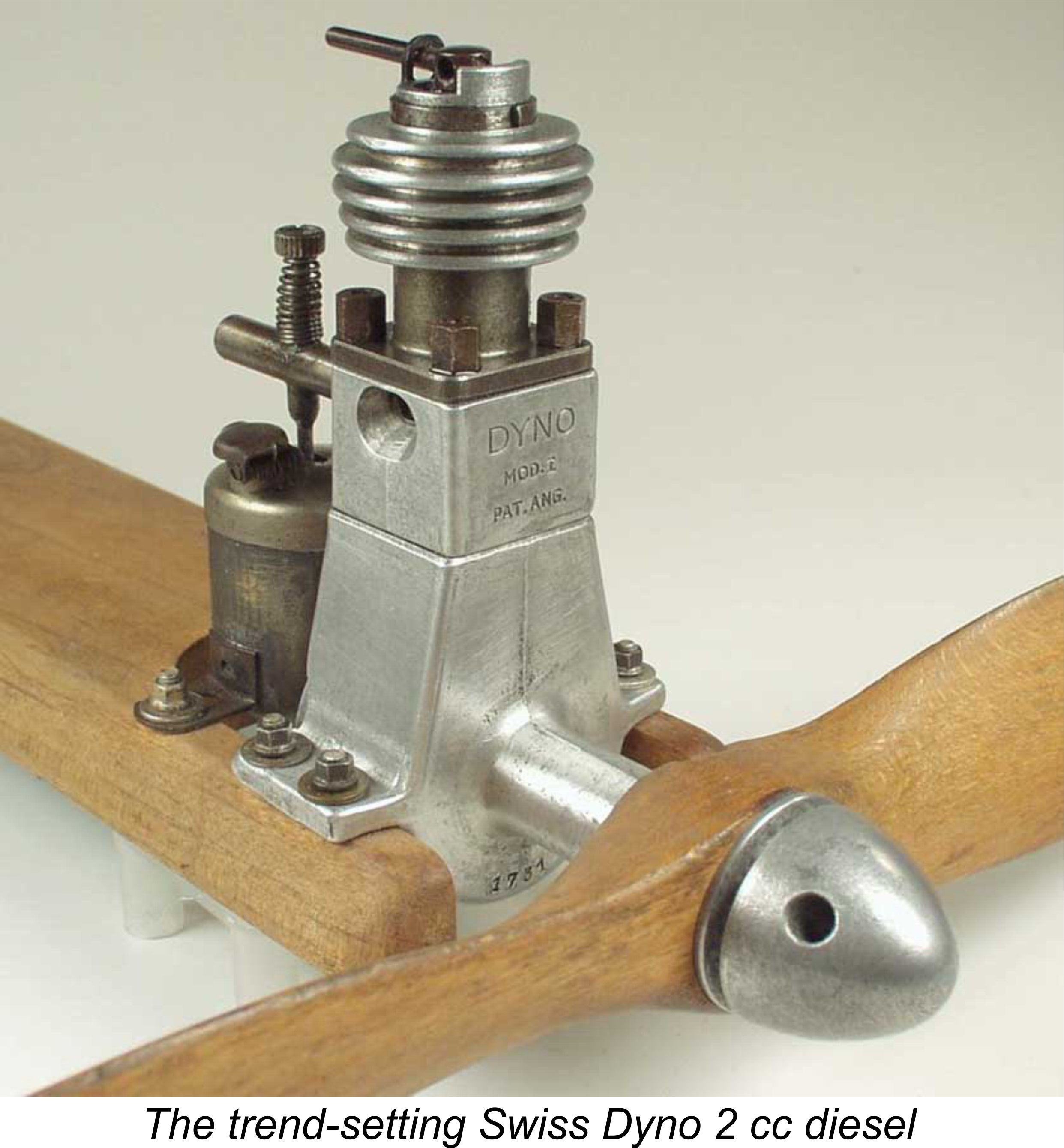 Despite the fact that by the early 1940’s most of Europe was heavily embroiled in WW2, word about this then-innovative type of model engine somehow trickled out of neutral Switzerland to reach a number of other European countries, along with a few examples of the Dyno. Among these countries was Italy, then heavily involved in what was increasingly becoming a very unpopular war for many Italian citizens. A number of Italian residents sought relief from wartime concerns by tinkering with the concept of designing and constructing model diesel engines.
Despite the fact that by the early 1940’s most of Europe was heavily embroiled in WW2, word about this then-innovative type of model engine somehow trickled out of neutral Switzerland to reach a number of other European countries, along with a few examples of the Dyno. Among these countries was Italy, then heavily involved in what was increasingly becoming a very unpopular war for many Italian citizens. A number of Italian residents sought relief from wartime concerns by tinkering with the concept of designing and constructing model diesel engines.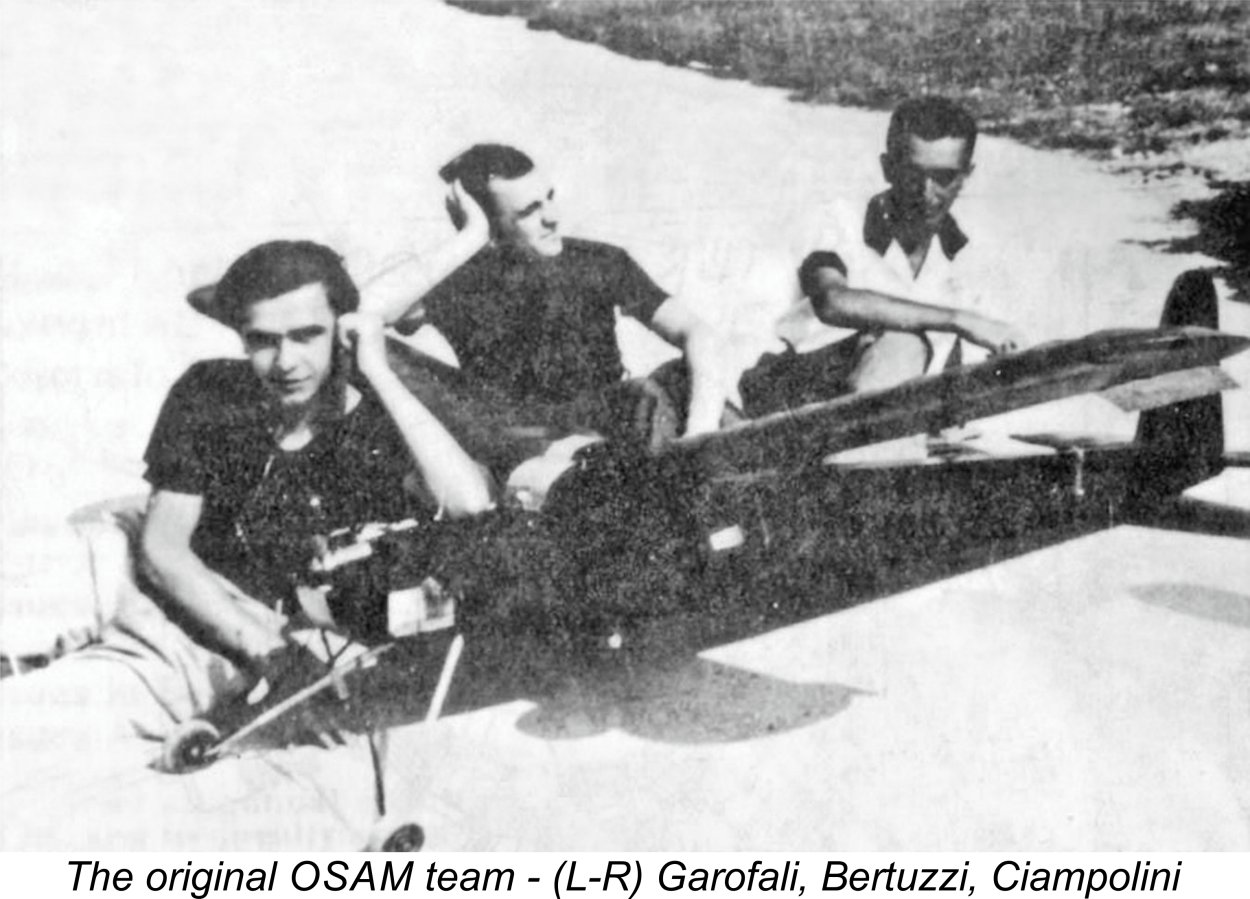
 Although at the time he was still heavily involved with war-related work at the Aeronautical Academy in Forli, Garofali was sufficiently intrigued by his examination of the Dyno to immediately begin exploring the compression ignition concept for himself. He did so by abandoning further work on the G.10, G.11 and G.12 models, turning his full attention to the development of the design of his first diesel, the sideport OSAM G.13 “Super Tigre” model of 5.28 cc displacement. This was the first time that the Super Tigre name was used in connection with one of Garofali’s designs, although it was to be some years before the name of the range itself was formalized as Super Tigre.
Although at the time he was still heavily involved with war-related work at the Aeronautical Academy in Forli, Garofali was sufficiently intrigued by his examination of the Dyno to immediately begin exploring the compression ignition concept for himself. He did so by abandoning further work on the G.10, G.11 and G.12 models, turning his full attention to the development of the design of his first diesel, the sideport OSAM G.13 “Super Tigre” model of 5.28 cc displacement. This was the first time that the Super Tigre name was used in connection with one of Garofali’s designs, although it was to be some years before the name of the range itself was formalized as Super Tigre.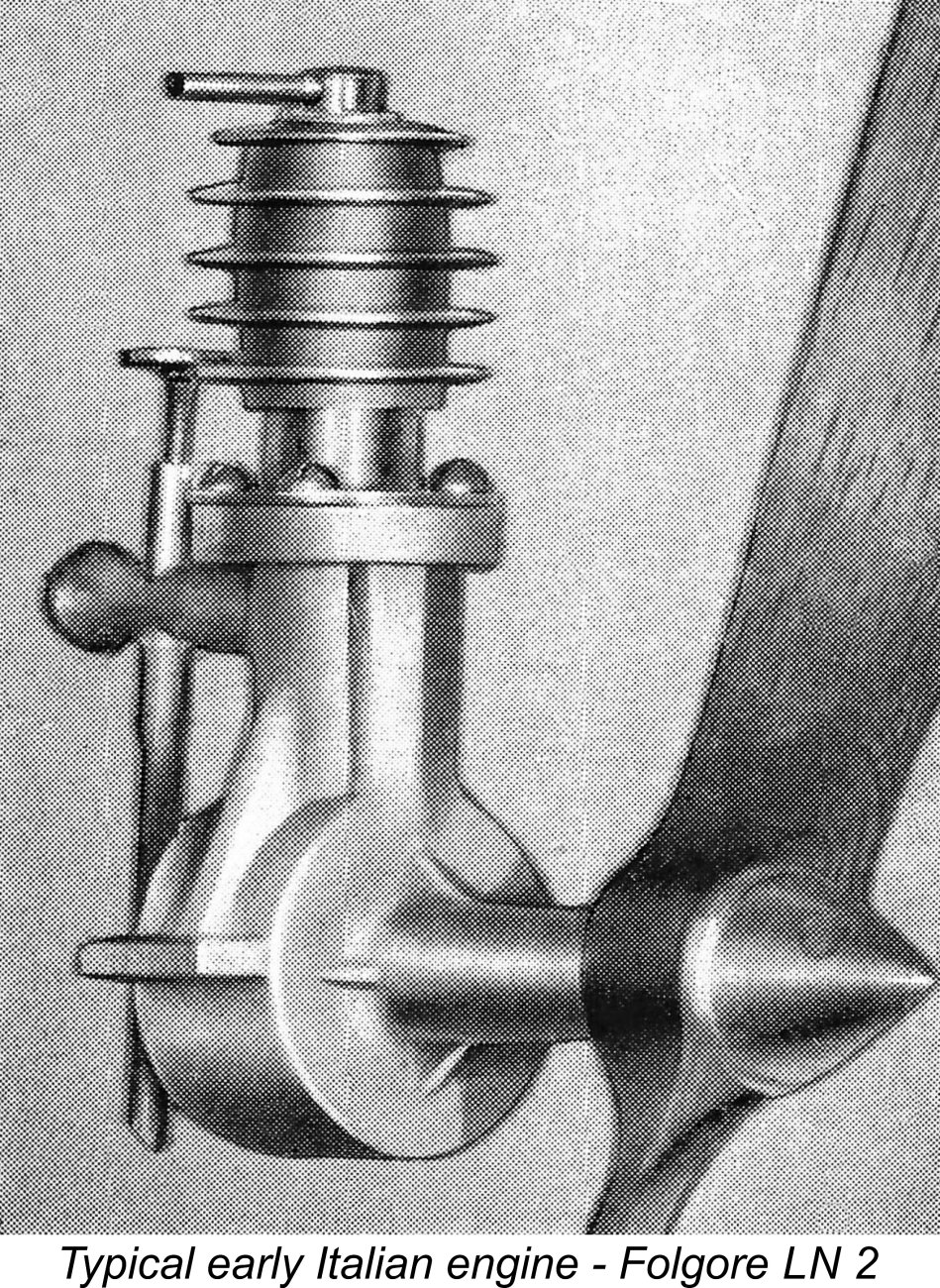
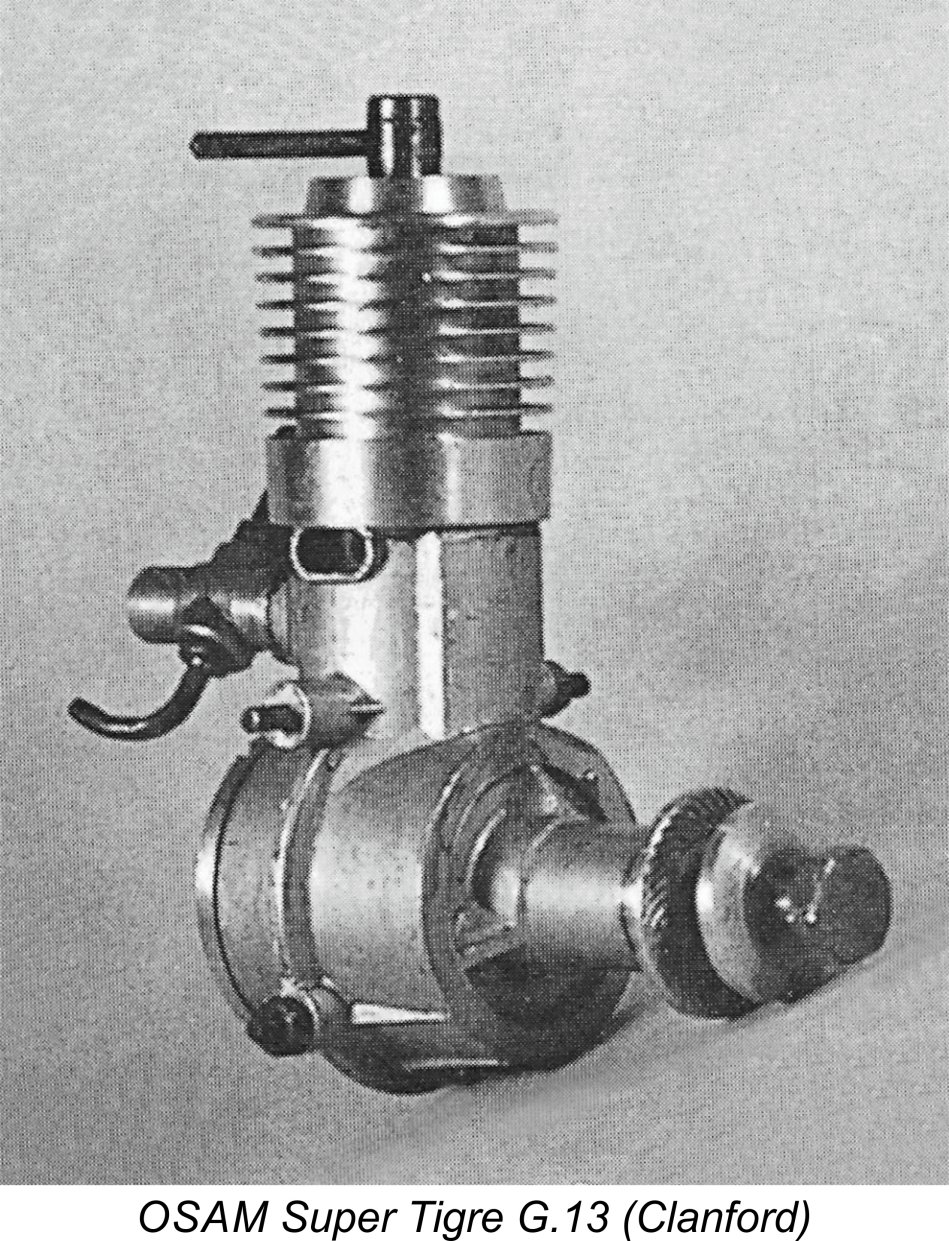
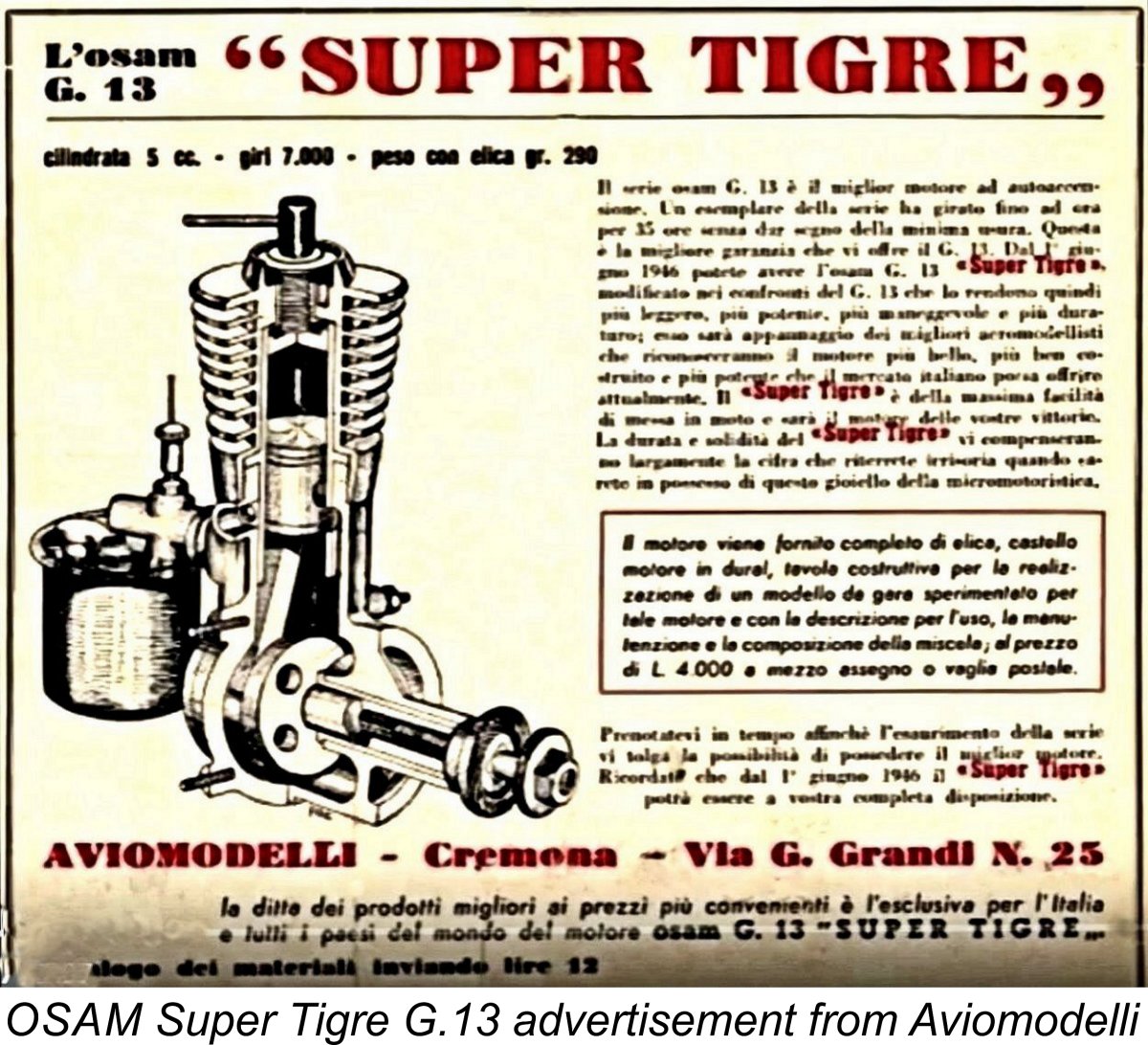
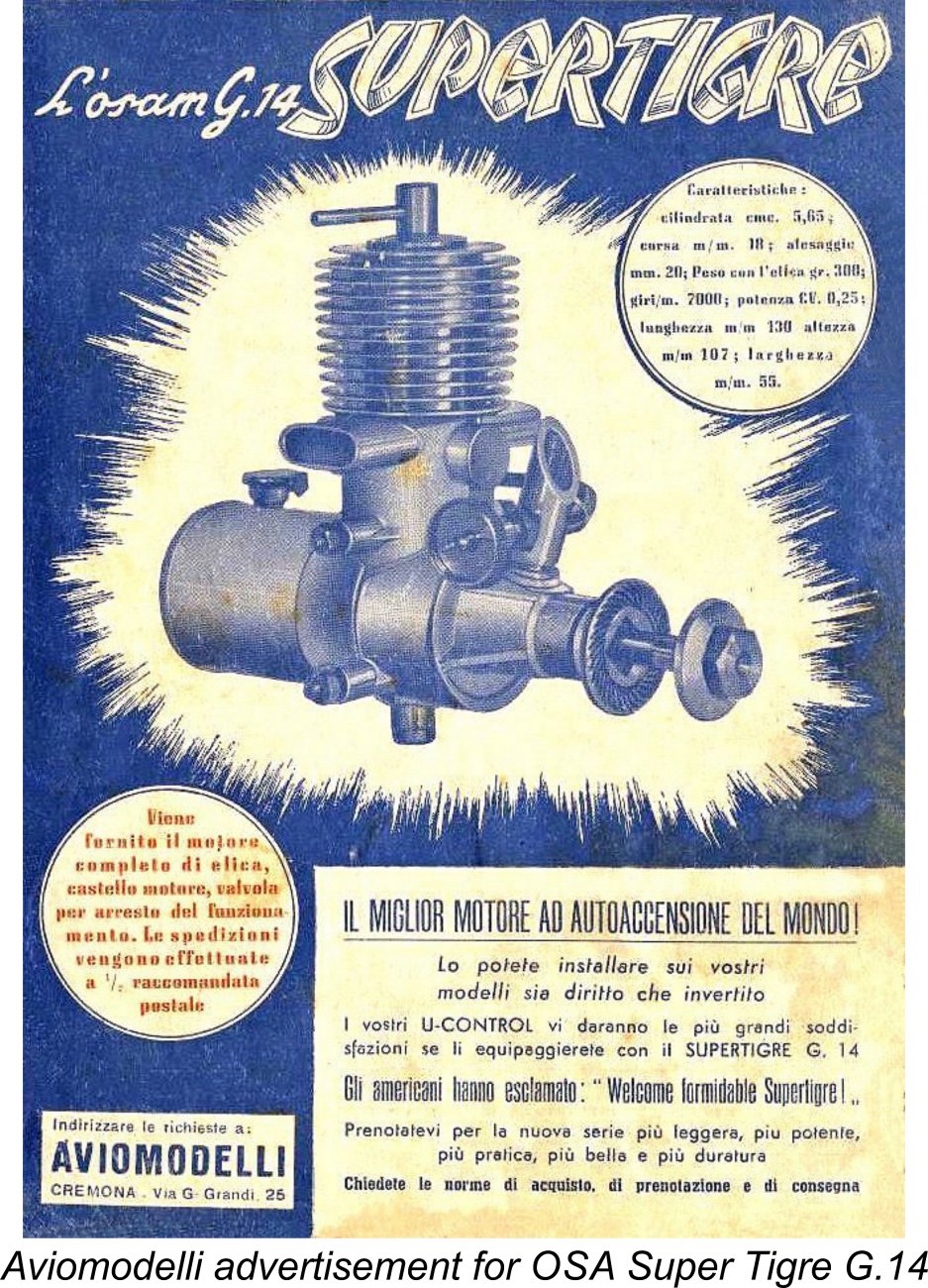 As 1946 rolled around, Signor Garofali had already developed the design of the G.13’s successor, the crankshaft front rotary valve (FRV) OSAM G.14 “Super Tigre” diesel of a slightly increased 5.65 cc displacement. However, at this stage Garofali still lacked the resources to manufacture his new design in quantity as well as market it properly. In order to expand the market potential of his designs, he needed help, which he found in the form of the aforementioned Aviomodelli company in Cremona which had marketed the G.13.
As 1946 rolled around, Signor Garofali had already developed the design of the G.13’s successor, the crankshaft front rotary valve (FRV) OSAM G.14 “Super Tigre” diesel of a slightly increased 5.65 cc displacement. However, at this stage Garofali still lacked the resources to manufacture his new design in quantity as well as market it properly. In order to expand the market potential of his designs, he needed help, which he found in the form of the aforementioned Aviomodelli company in Cremona which had marketed the G.13.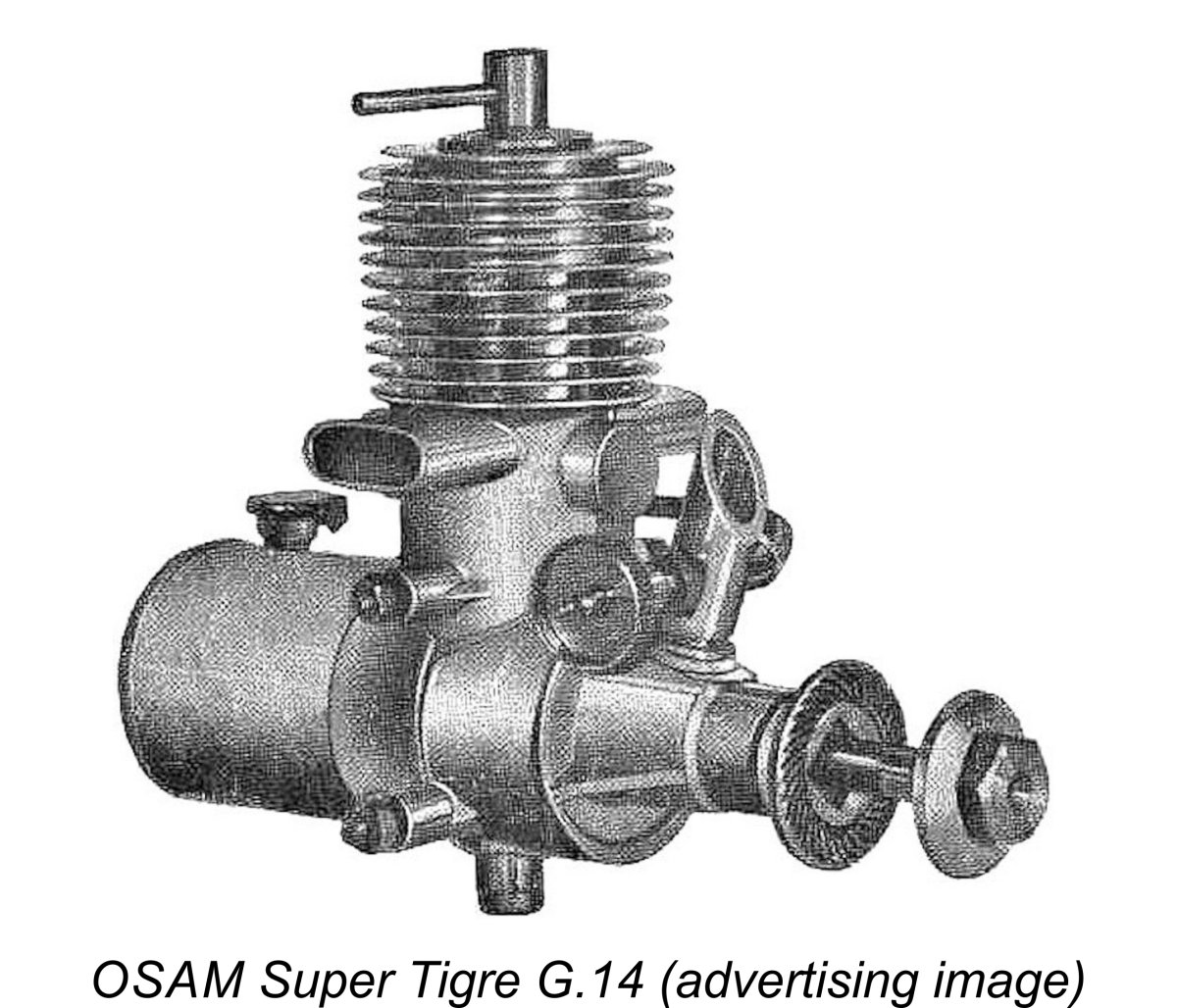 Only about 300 OSAM G-14’s were produced and marketed by the Aviomodelli company. Towards the end of 1946, while production of the G-14 by Aviomodelli was still ongoing, Jaures Garofali finally decided that the time was right to set up shop on his own account. Still lacking the resources to accomplish this on his own, he joined forces with a colleague named Leonardo Boreani to form a new company called Officine OSAM, Bologna.
Only about 300 OSAM G-14’s were produced and marketed by the Aviomodelli company. Towards the end of 1946, while production of the G-14 by Aviomodelli was still ongoing, Jaures Garofali finally decided that the time was right to set up shop on his own account. Still lacking the resources to accomplish this on his own, he joined forces with a colleague named Leonardo Boreani to form a new company called Officine OSAM, Bologna. 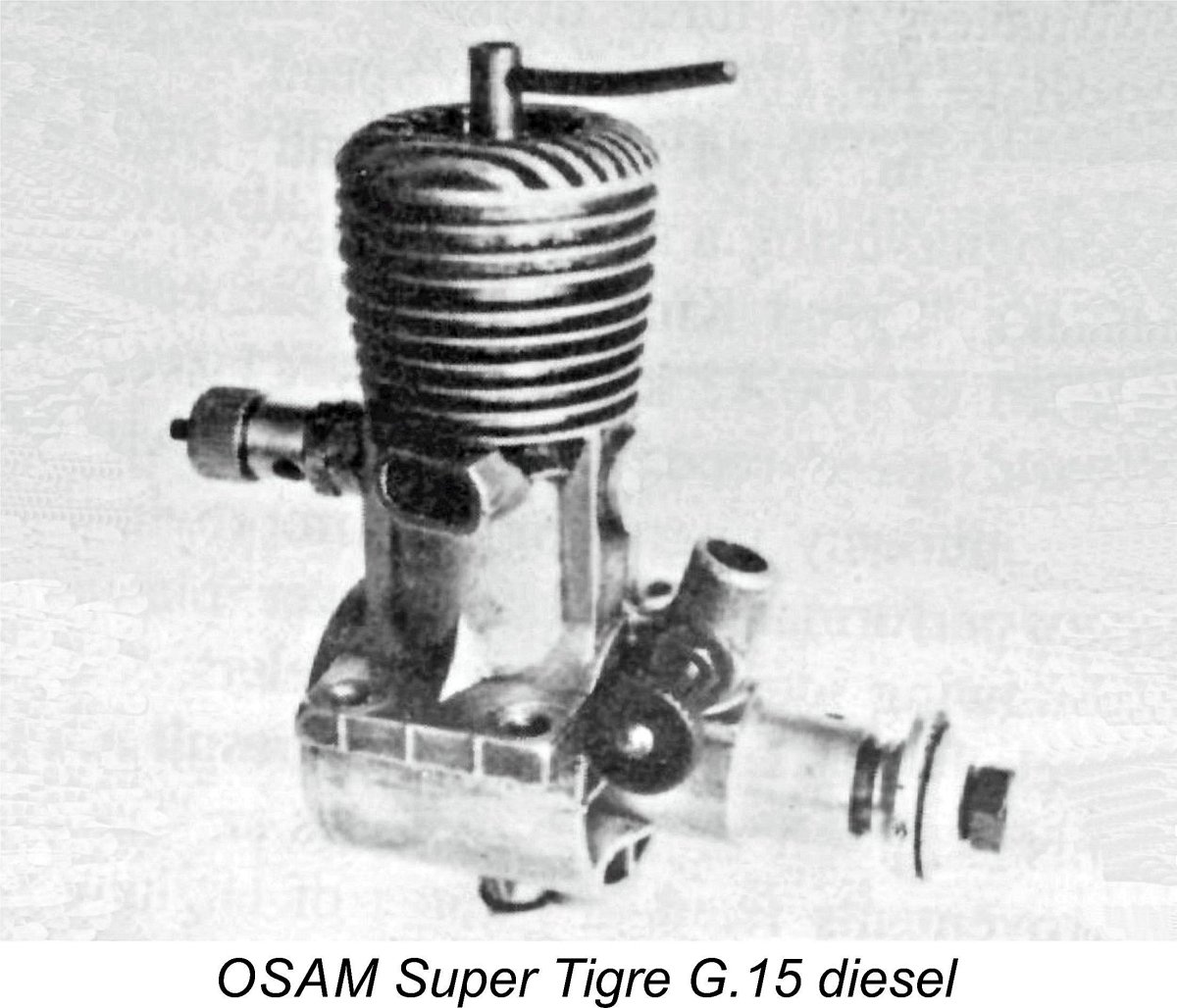 The first engine to appear from the new company was the OSAM GB-15, a 6.28 cc diesel. This FRV design was equipped with a bleed valve at the rear of the upper crankcase to serve as a cutout to stop the engine at the end of the motor run by releasing the crankcase compression. The GB-15 was very well received by the Italian modelling community because it was both powerful and reliable. However, time was to reveal its one drawback – a rather delicate crankshaft.
The first engine to appear from the new company was the OSAM GB-15, a 6.28 cc diesel. This FRV design was equipped with a bleed valve at the rear of the upper crankcase to serve as a cutout to stop the engine at the end of the motor run by releasing the crankcase compression. The GB-15 was very well received by the Italian modelling community because it was both powerful and reliable. However, time was to reveal its one drawback – a rather delicate crankshaft.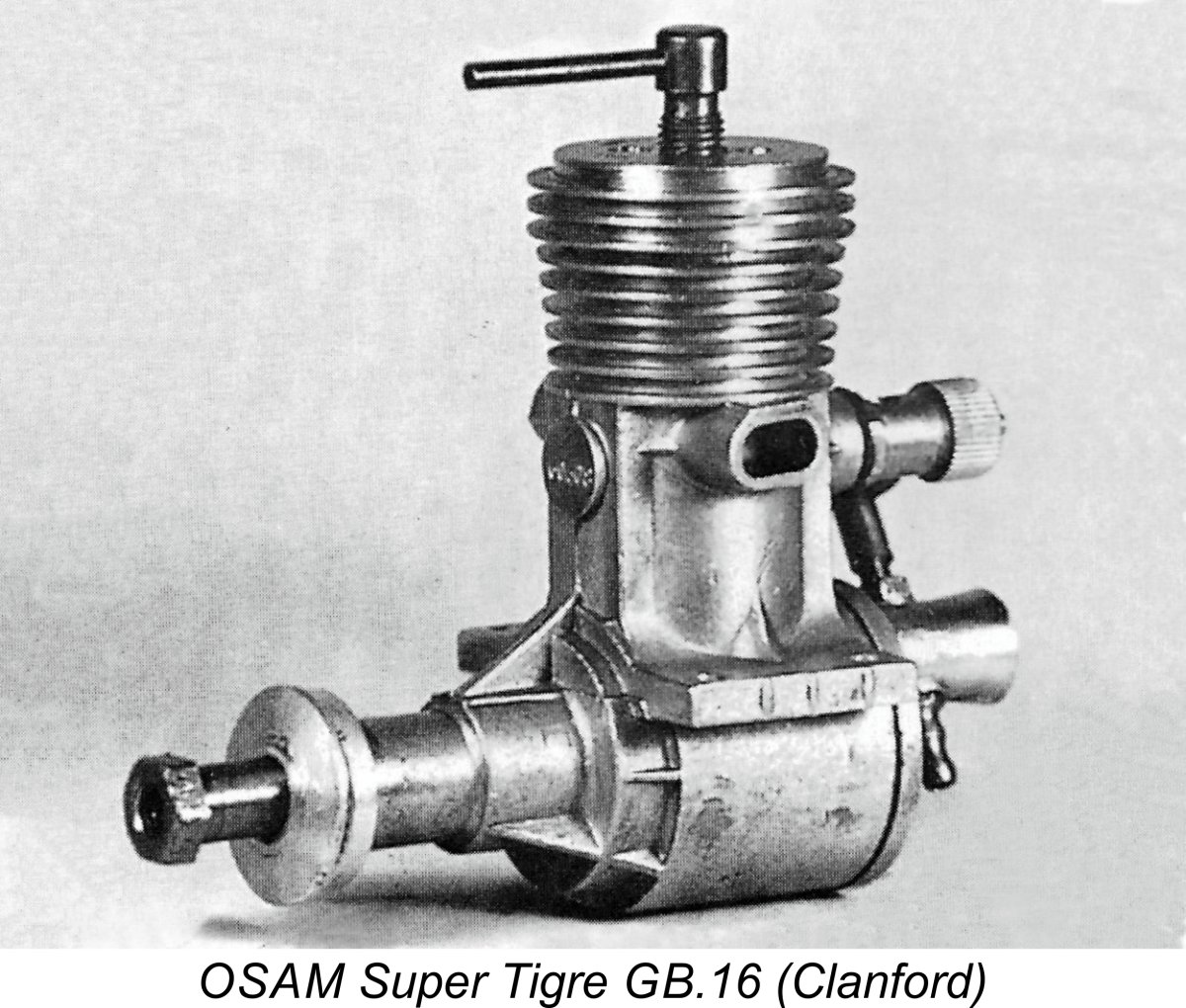
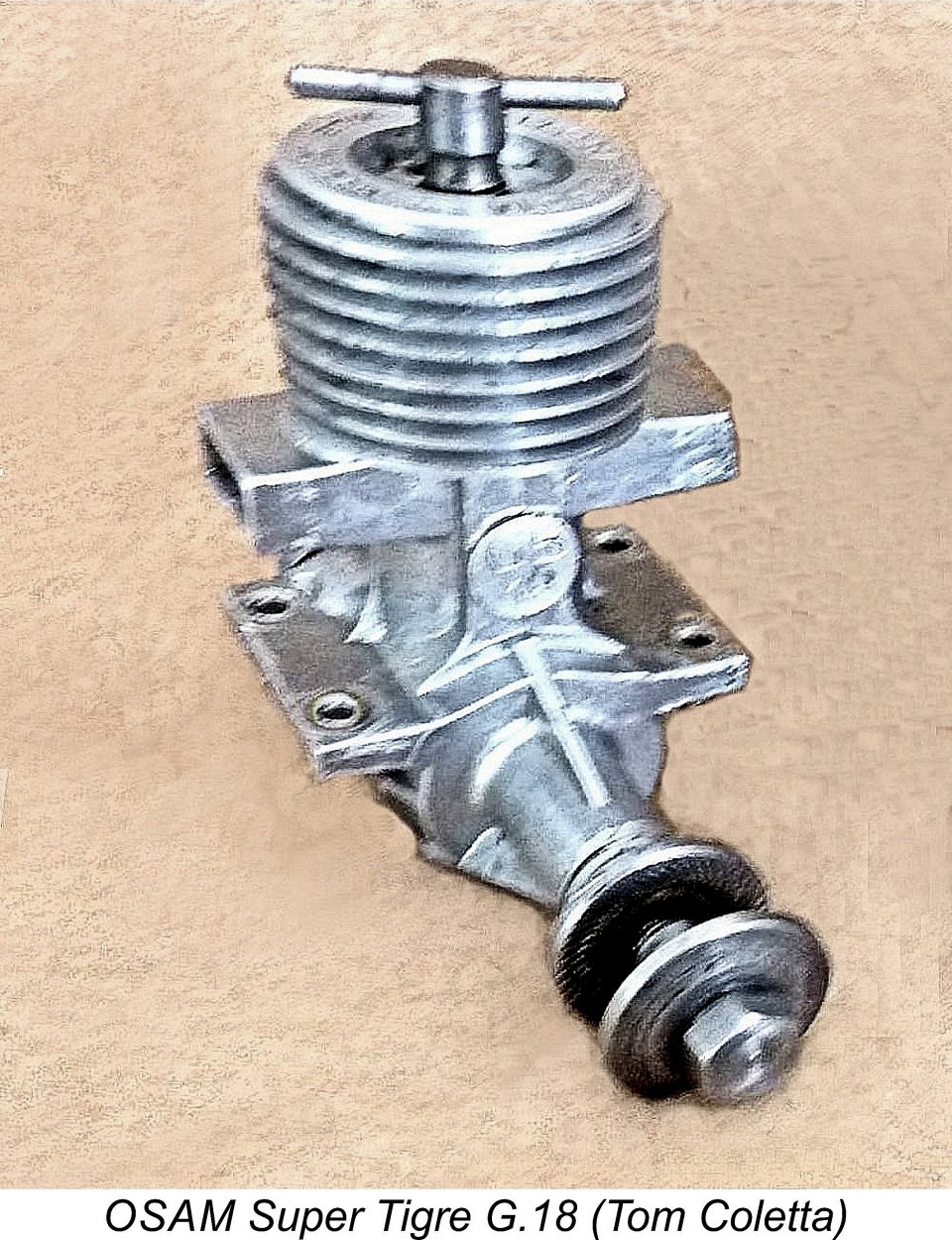 In his later test of the Super Tigre G.19 and G.20 units (see below), Lawrence H. Sparey commented that the GB.16 had been “probably the most powerful diesel to go into quantity production” up to that time. He recalled that the GB.16 had “gained great popularity amongst stunt control-line fliers the world over”, being particularly noted for its extremely robust construction.
In his later test of the Super Tigre G.19 and G.20 units (see below), Lawrence H. Sparey commented that the GB.16 had been “probably the most powerful diesel to go into quantity production” up to that time. He recalled that the GB.16 had “gained great popularity amongst stunt control-line fliers the world over”, being particularly noted for its extremely robust construction.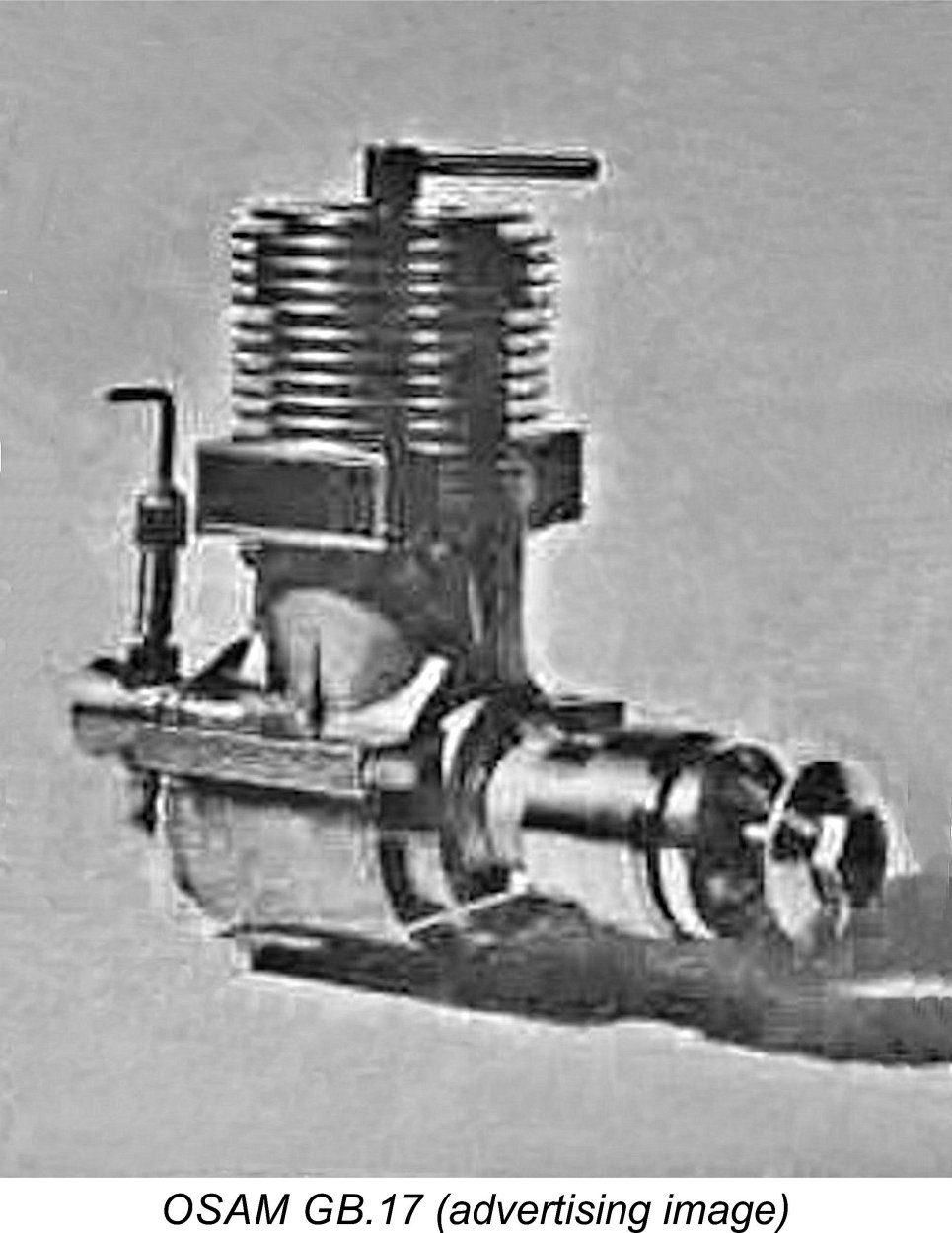
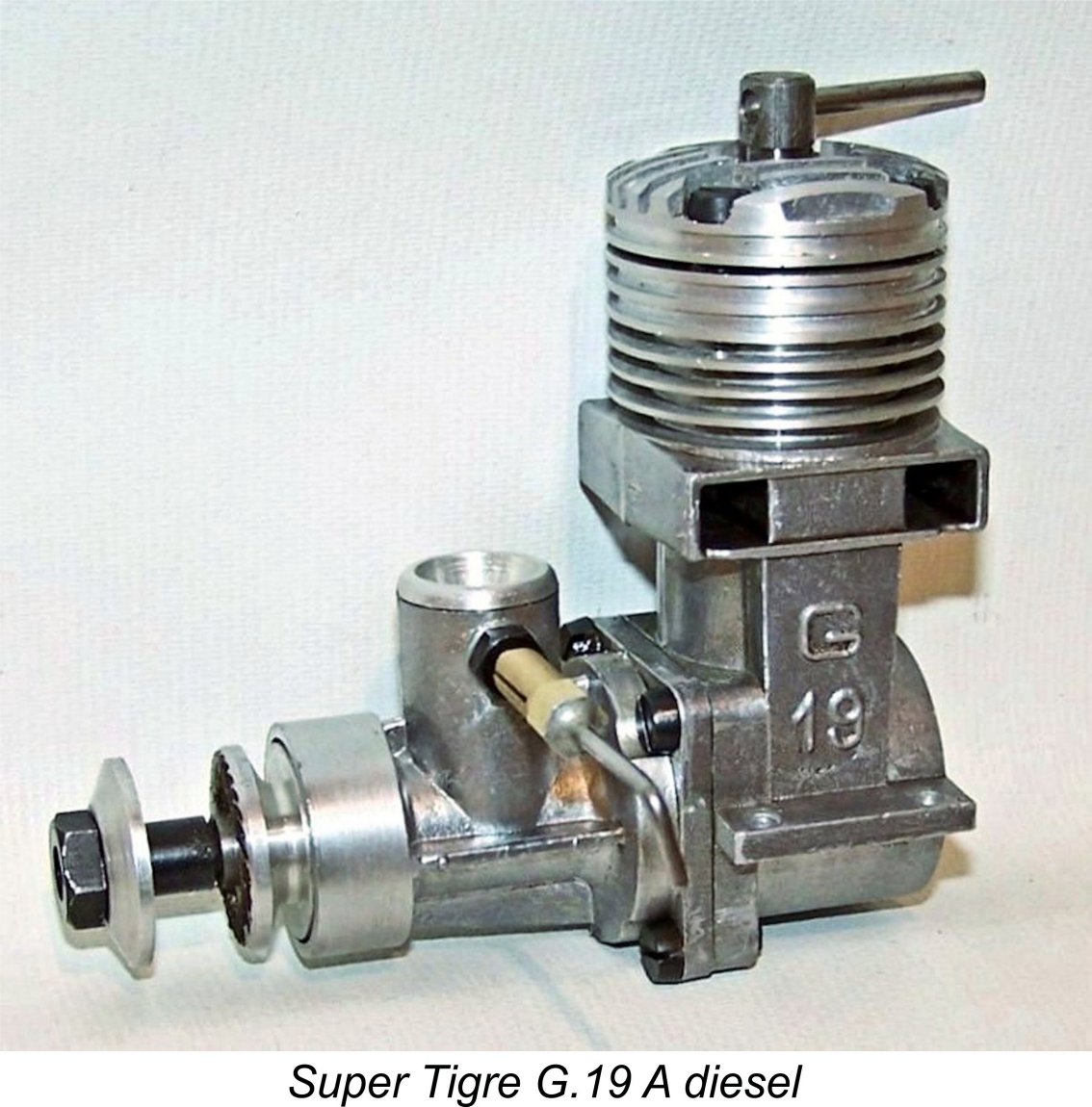 The first engine to appear under the Super Tigre brand name was the G-19, an excellent 4.82 cc diesel which was soon to be followed by an even more powerful glow-plug version carrying the same model designation. These two models were distinguished by having A and B suffixes attached to the G.19 model name for the diesel and glow-plug versions respectively. The G.19 A diesel was evidently intended as a replacement for the old GB.16, while the G.19 B glow-plug model was apparently aimed squarely at the competition market.
The first engine to appear under the Super Tigre brand name was the G-19, an excellent 4.82 cc diesel which was soon to be followed by an even more powerful glow-plug version carrying the same model designation. These two models were distinguished by having A and B suffixes attached to the G.19 model name for the diesel and glow-plug versions respectively. The G.19 A diesel was evidently intended as a replacement for the old GB.16, while the G.19 B glow-plug model was apparently aimed squarely at the competition market.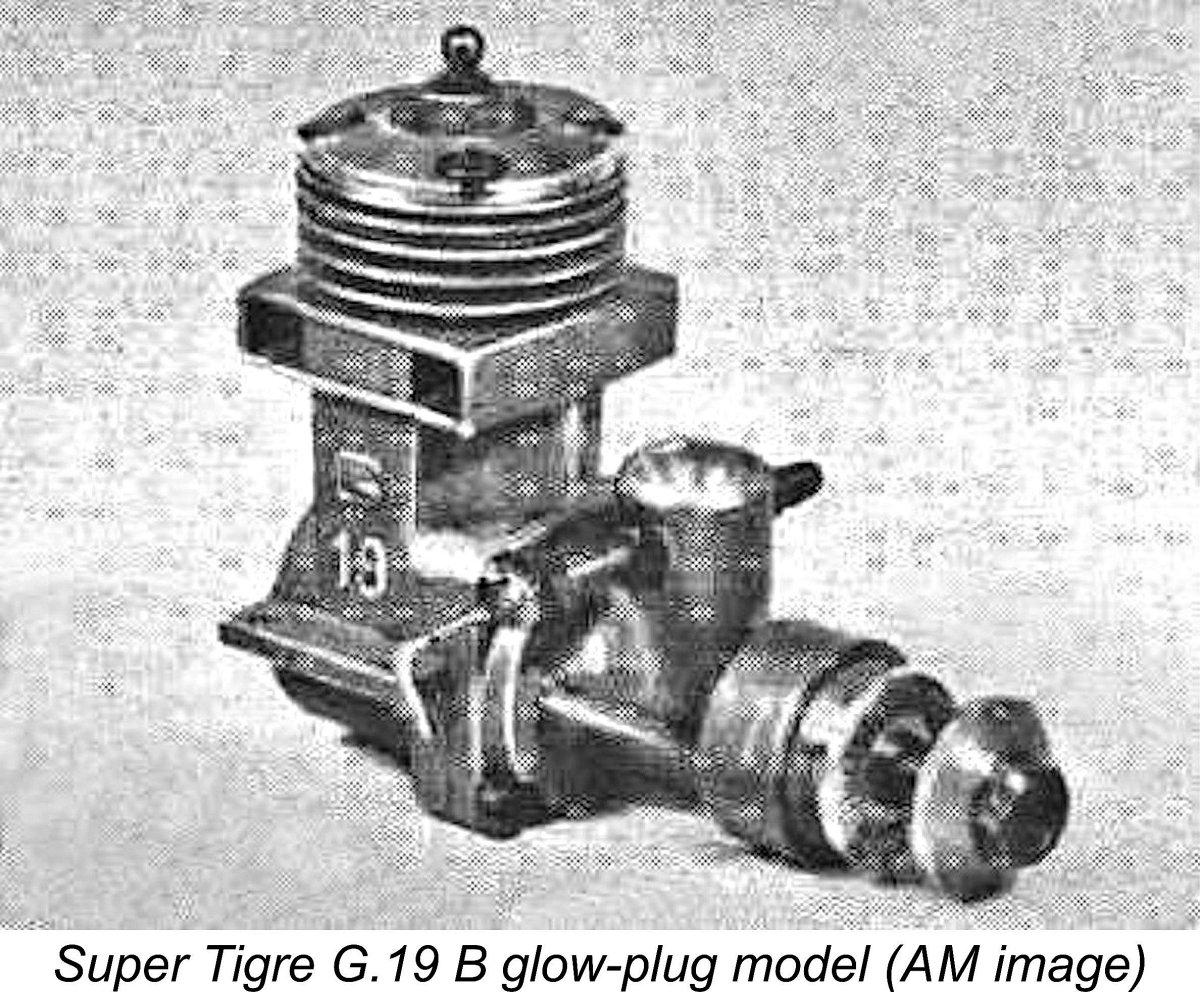 Bore and stroke dimensions of the two G.19 models were 19 mm and 17 mm respectively for displacement of 4.82 cc (0.294 cuin.). The engine was notable for two features – one, its unusually large-diameter crankshaft which doubtless contributed both to its performance and to its rather considerable weight of 240 gm (8.5 ounces); and two, its use of a flat-topped ringed aluminium alloy piston in both diesel and glow-plug variants. This latter feature was of course a carry-over from the GB.17 diesel model mentioned earlier, having actually been introduced way back in 1945 with the G.13 design.
Bore and stroke dimensions of the two G.19 models were 19 mm and 17 mm respectively for displacement of 4.82 cc (0.294 cuin.). The engine was notable for two features – one, its unusually large-diameter crankshaft which doubtless contributed both to its performance and to its rather considerable weight of 240 gm (8.5 ounces); and two, its use of a flat-topped ringed aluminium alloy piston in both diesel and glow-plug variants. This latter feature was of course a carry-over from the GB.17 diesel model mentioned earlier, having actually been introduced way back in 1945 with the G.13 design. 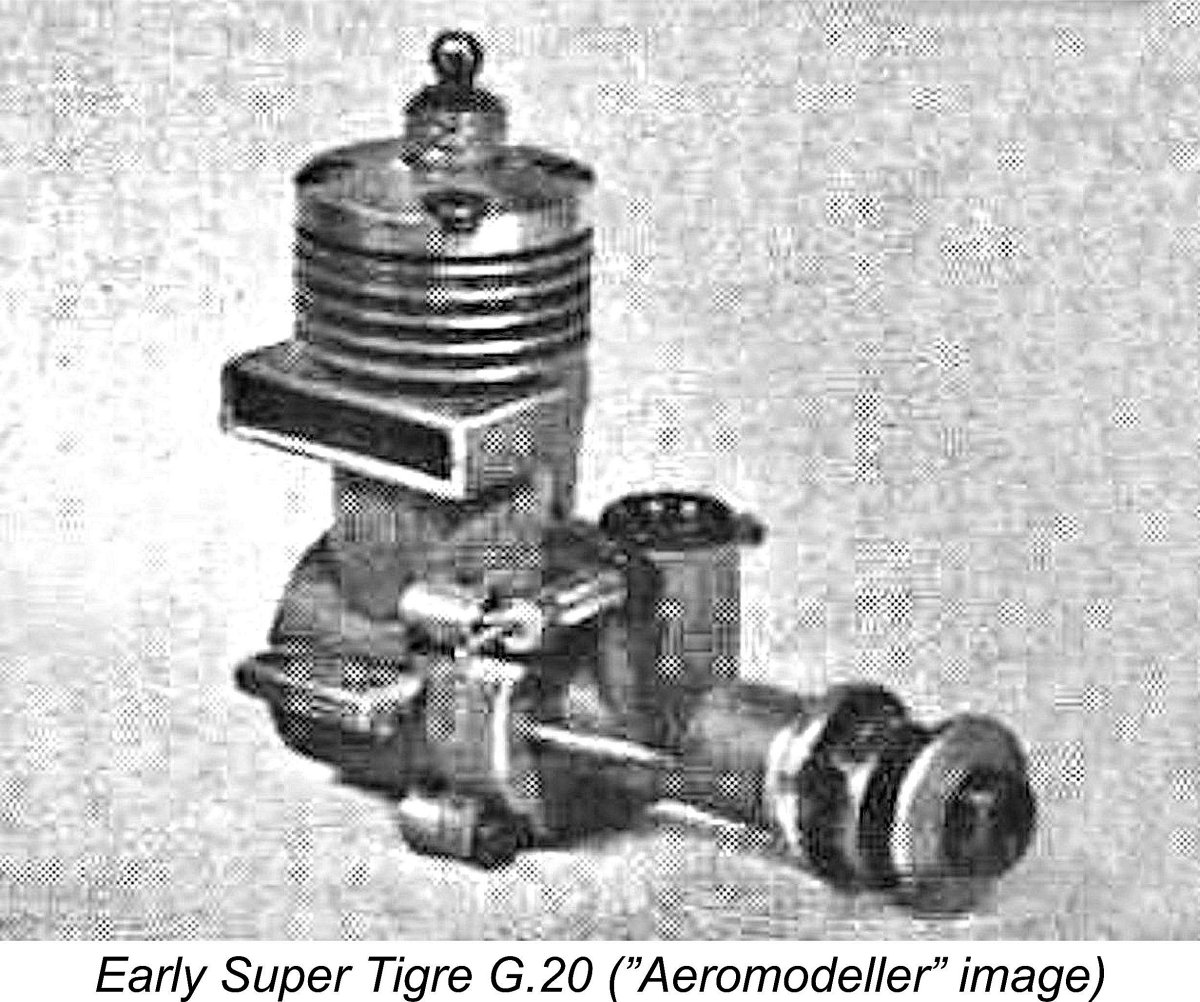 The engine was supplied with three plastic venturi inserts offering different choke diameters for control line speed, control line stunt and free flight applications. These venturis were readily distinguished by the different colours of the plastic from which they were moulded (red, black and white respectively). At this stage and for some years thereafter, the backplates were cast integrally with the main crankcase.
The engine was supplied with three plastic venturi inserts offering different choke diameters for control line speed, control line stunt and free flight applications. These venturis were readily distinguished by the different colours of the plastic from which they were moulded (red, black and white respectively). At this stage and for some years thereafter, the backplates were cast integrally with the main crankcase.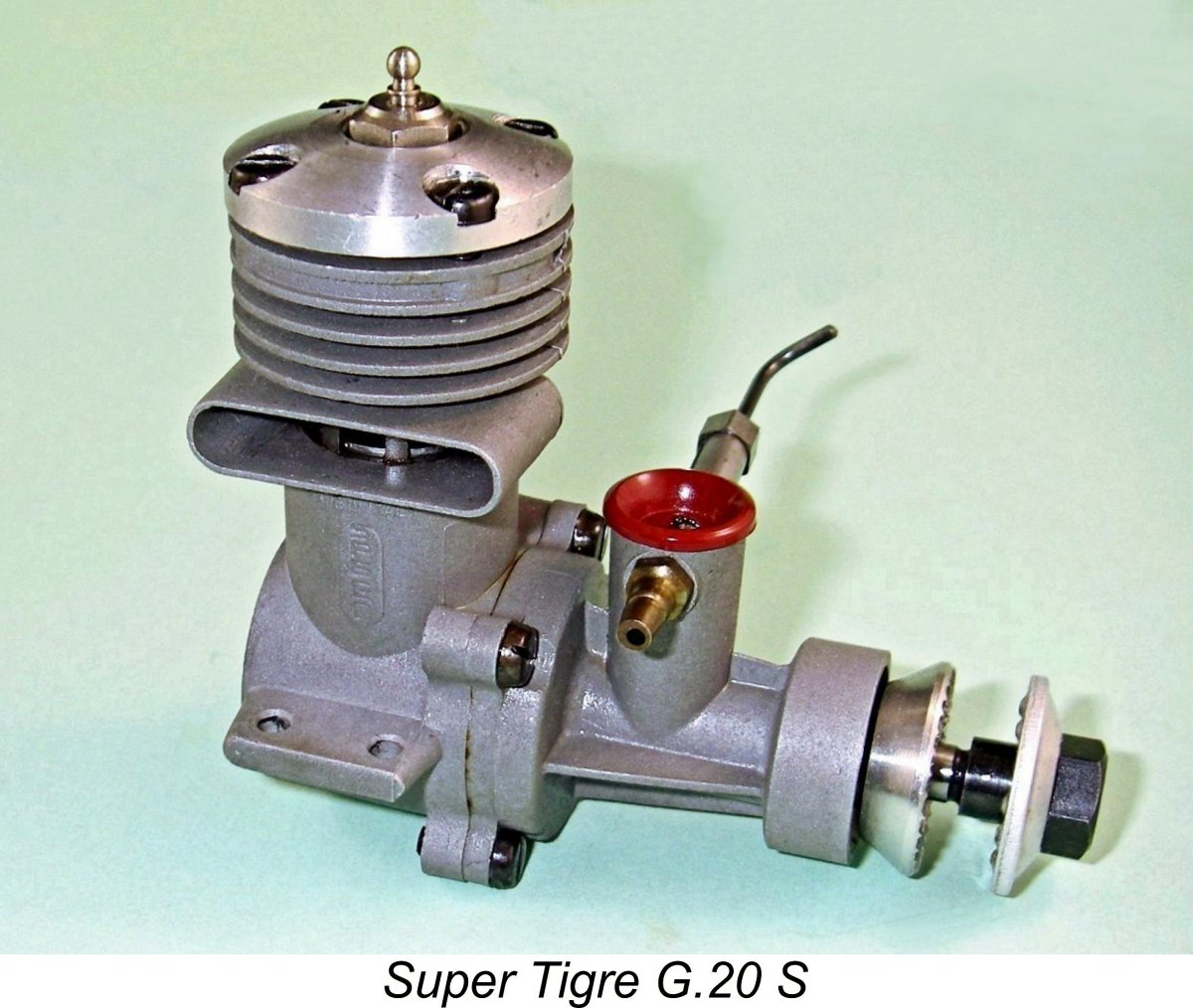 In 1952 a revised version of the G.20 called the G.20 S (for "Speed") appeared using a twin ball-race crankshaft. The original single ball-race version remained available as well under the "Sport" designation.
In 1952 a revised version of the G.20 called the G.20 S (for "Speed") appeared using a twin ball-race crankshaft. The original single ball-race version remained available as well under the "Sport" designation. 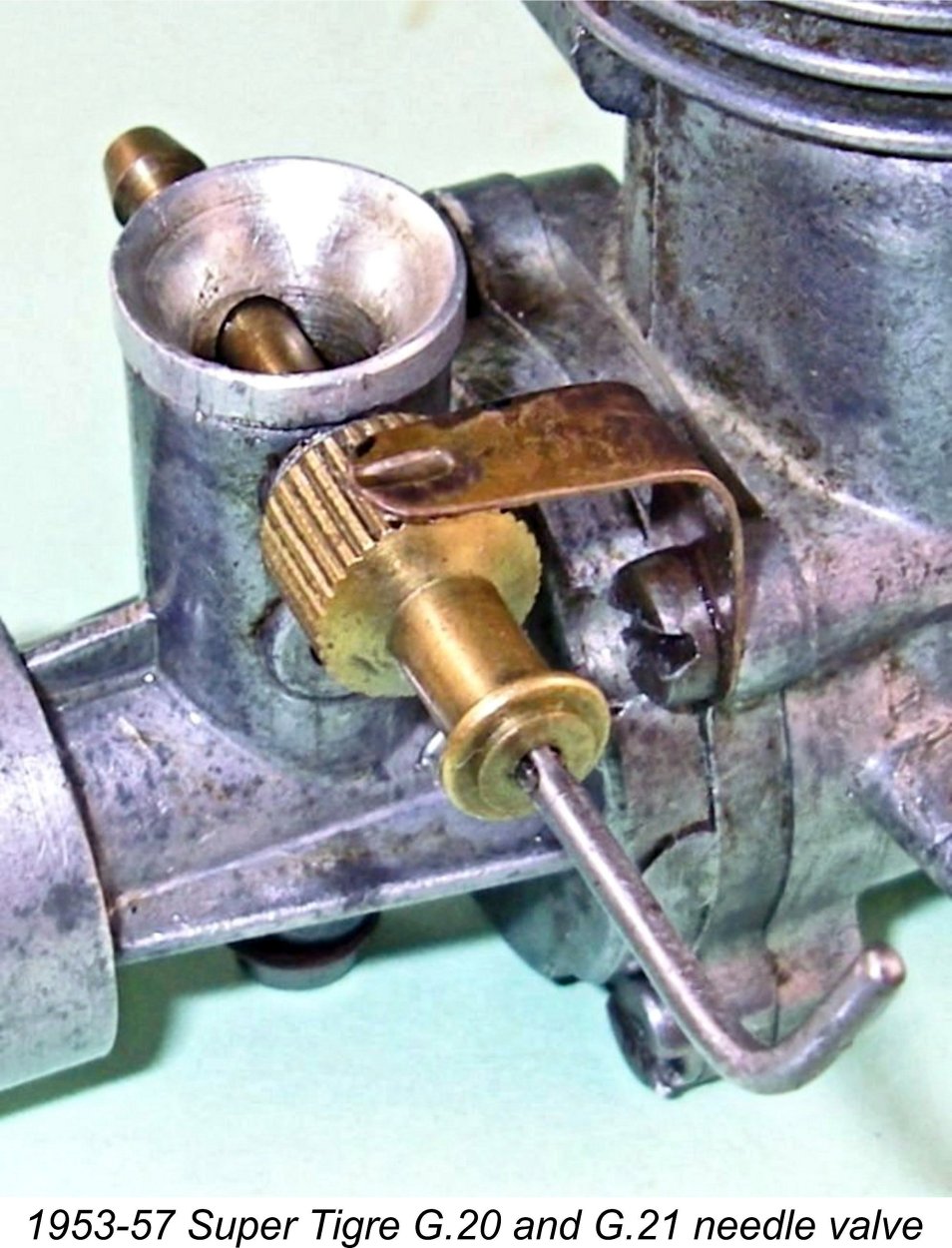
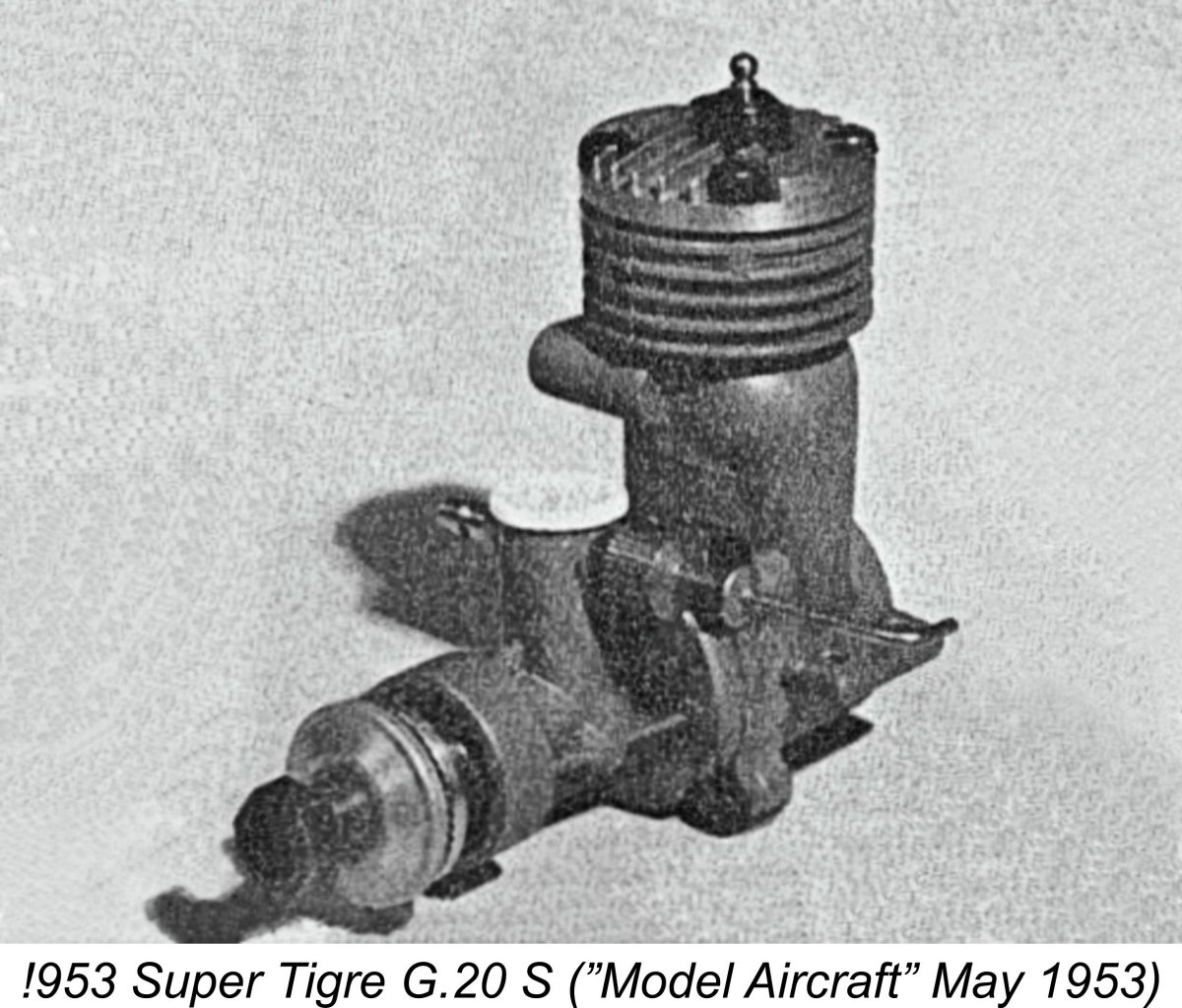
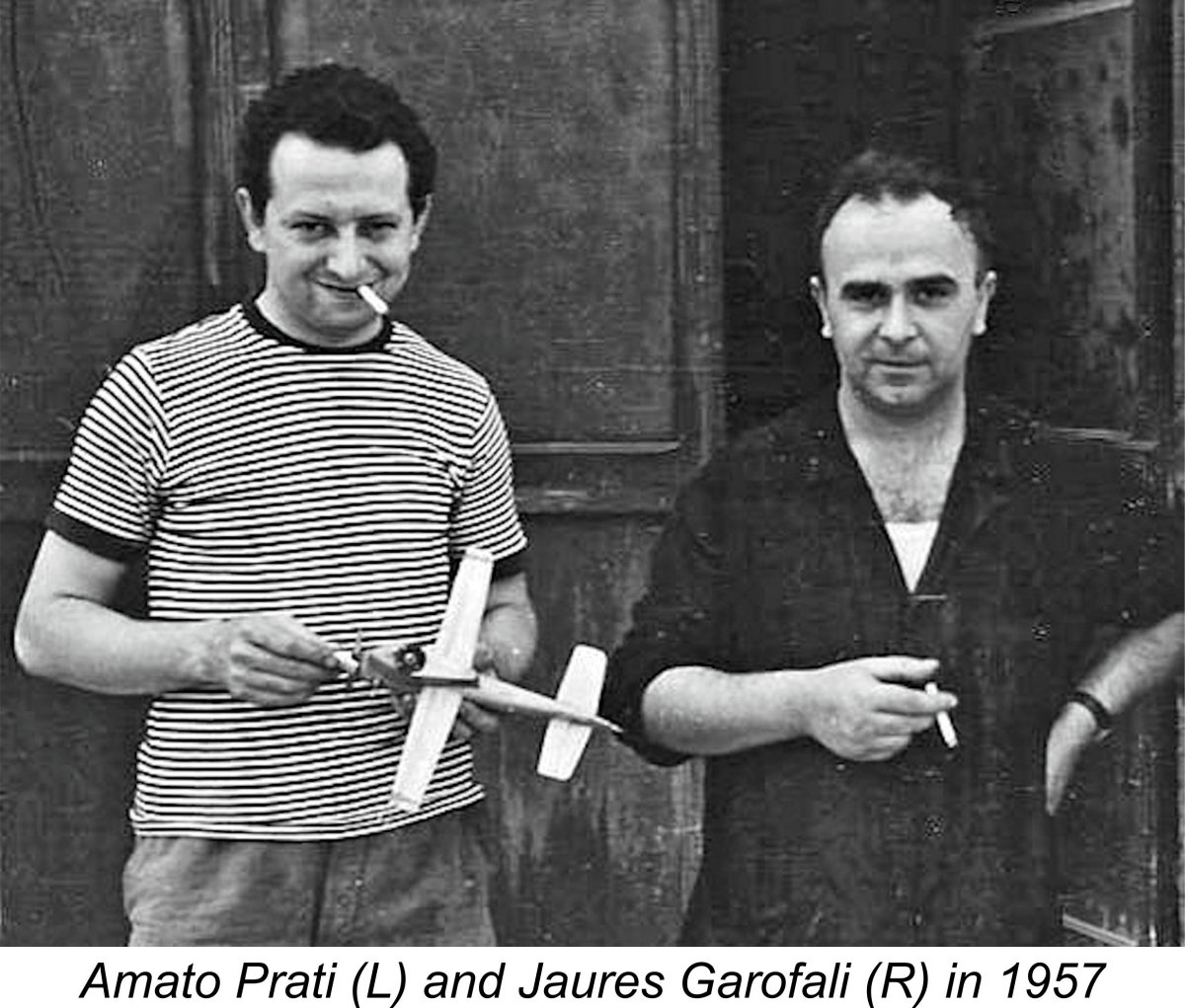 Amato Prati subsequently became a Super Tigre employee, working closely with Jaures Garofali on the further development of the G.20 as well as other Super Tigre models. Signor Garofali was always open to the ideas of serious users of his engines, particularly those like Prati who competed in control line speed events which placed the ultimate performance demands upon the engines. As a result, the G.20 underwent a continuous program of upgrading and performance improvement. Many of the changes were incorporated between one batch of engines and the next, and Signor Garofali made no attempt to keep track of all the changes. Consequently, numerous minor variants of this engine exist under the same model designations.
Amato Prati subsequently became a Super Tigre employee, working closely with Jaures Garofali on the further development of the G.20 as well as other Super Tigre models. Signor Garofali was always open to the ideas of serious users of his engines, particularly those like Prati who competed in control line speed events which placed the ultimate performance demands upon the engines. As a result, the G.20 underwent a continuous program of upgrading and performance improvement. Many of the changes were incorporated between one batch of engines and the next, and Signor Garofali made no attempt to keep track of all the changes. Consequently, numerous minor variants of this engine exist under the same model designations.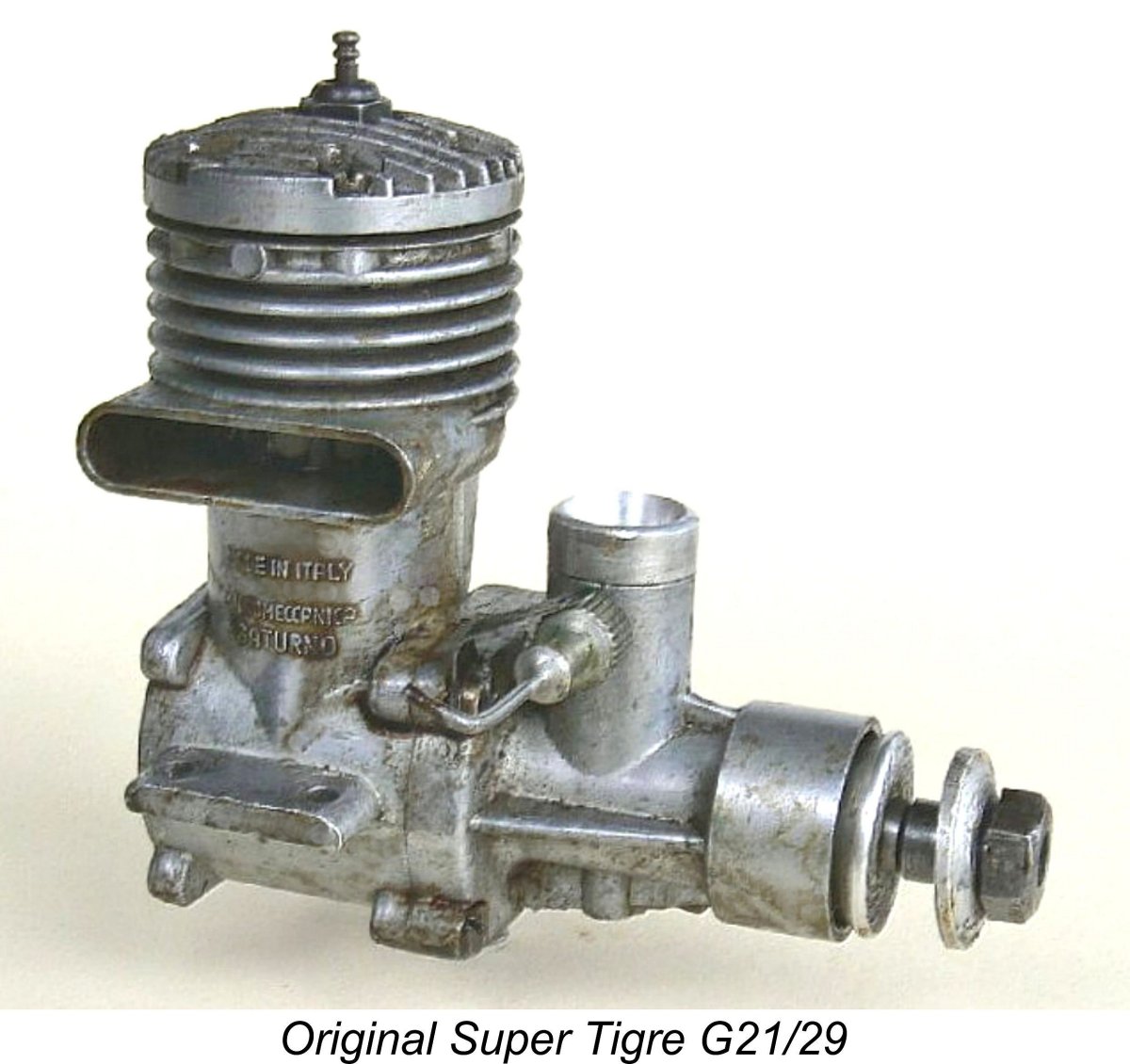 This FRV engine was aimed at matching the competition successes of the 2.5 cc G.20 in the larger 5 cc category. Like the earlier G.19, it had bore and stroke dimensions of 19.0 mm and 17.0 mm respectively for a displacement of 4.82 cc (0.294 cuin.). The twin ball-race front end was more or less identical to that of the G.19, but the main crankcase casting and cylinder porting arrangements were completely revised. The engine now featured cross-flow loop scavenging along with the use of a twin-ringed light alloy deflector piston in place of the former flat-topped component. Like the companion G.20, the G.21 featured an integrally-cast backplate. Unlike the G.19, it was never offered in a diesel version.
This FRV engine was aimed at matching the competition successes of the 2.5 cc G.20 in the larger 5 cc category. Like the earlier G.19, it had bore and stroke dimensions of 19.0 mm and 17.0 mm respectively for a displacement of 4.82 cc (0.294 cuin.). The twin ball-race front end was more or less identical to that of the G.19, but the main crankcase casting and cylinder porting arrangements were completely revised. The engine now featured cross-flow loop scavenging along with the use of a twin-ringed light alloy deflector piston in place of the former flat-topped component. Like the companion G.20, the G.21 featured an integrally-cast backplate. Unlike the G.19, it was never offered in a diesel version. 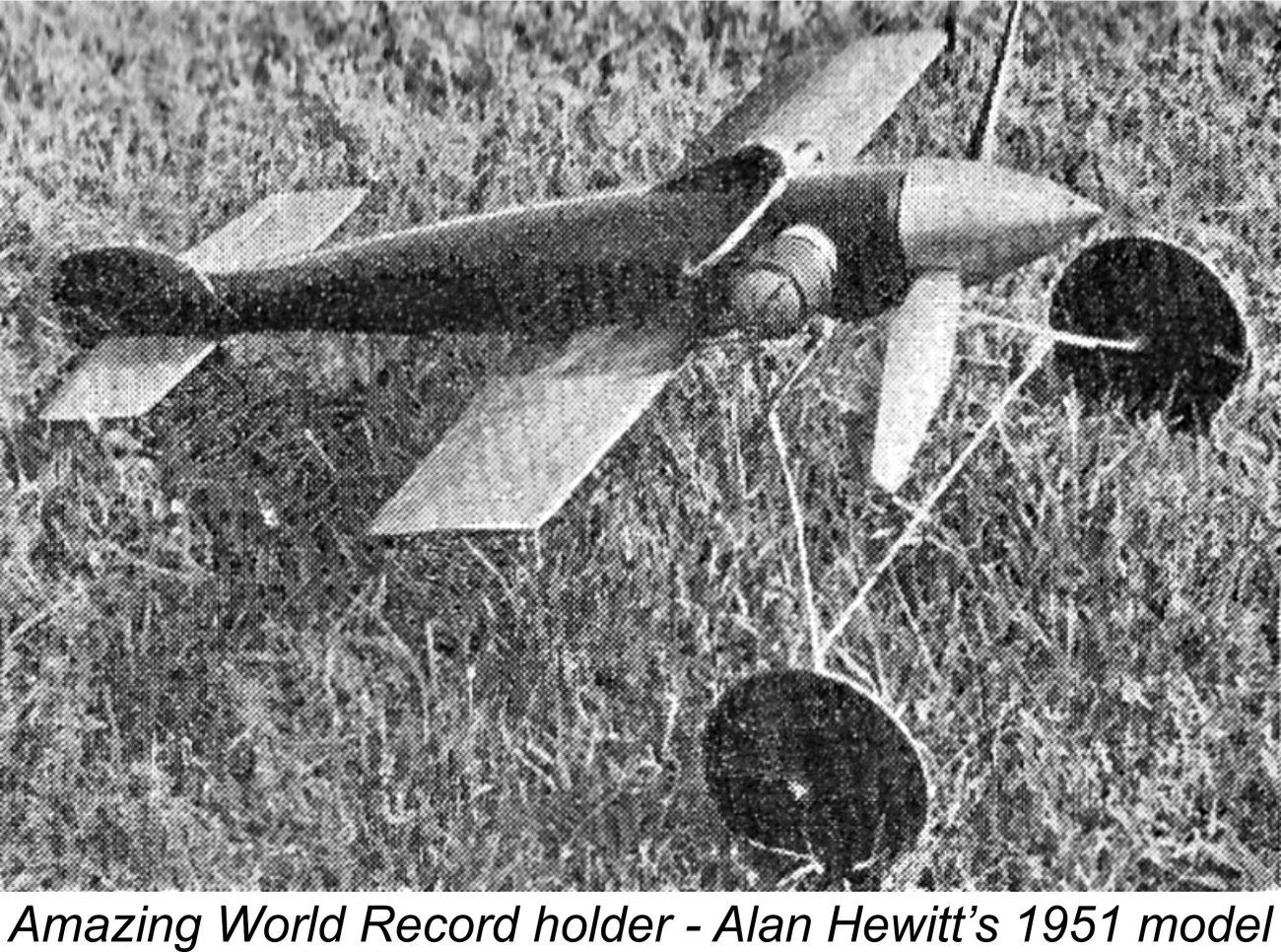 However, by the time that the first-ever FAI-sanctioned World Championship meeting for control-line speed models was organized in 1951, again at Knokke, classes were run for 2.5 cc, 5 cc and 10 cc models. Oddly enough, neither the Italians nor the Americans sent teams to this contest. The 2.5 cc class was won by Britain’s Alan Hewitt at a speed of 151.075 km/hr (93.88 mph) using a diesel engine hand-made by Gig Eifflaender of
However, by the time that the first-ever FAI-sanctioned World Championship meeting for control-line speed models was organized in 1951, again at Knokke, classes were run for 2.5 cc, 5 cc and 10 cc models. Oddly enough, neither the Italians nor the Americans sent teams to this contest. The 2.5 cc class was won by Britain’s Alan Hewitt at a speed of 151.075 km/hr (93.88 mph) using a diesel engine hand-made by Gig Eifflaender of 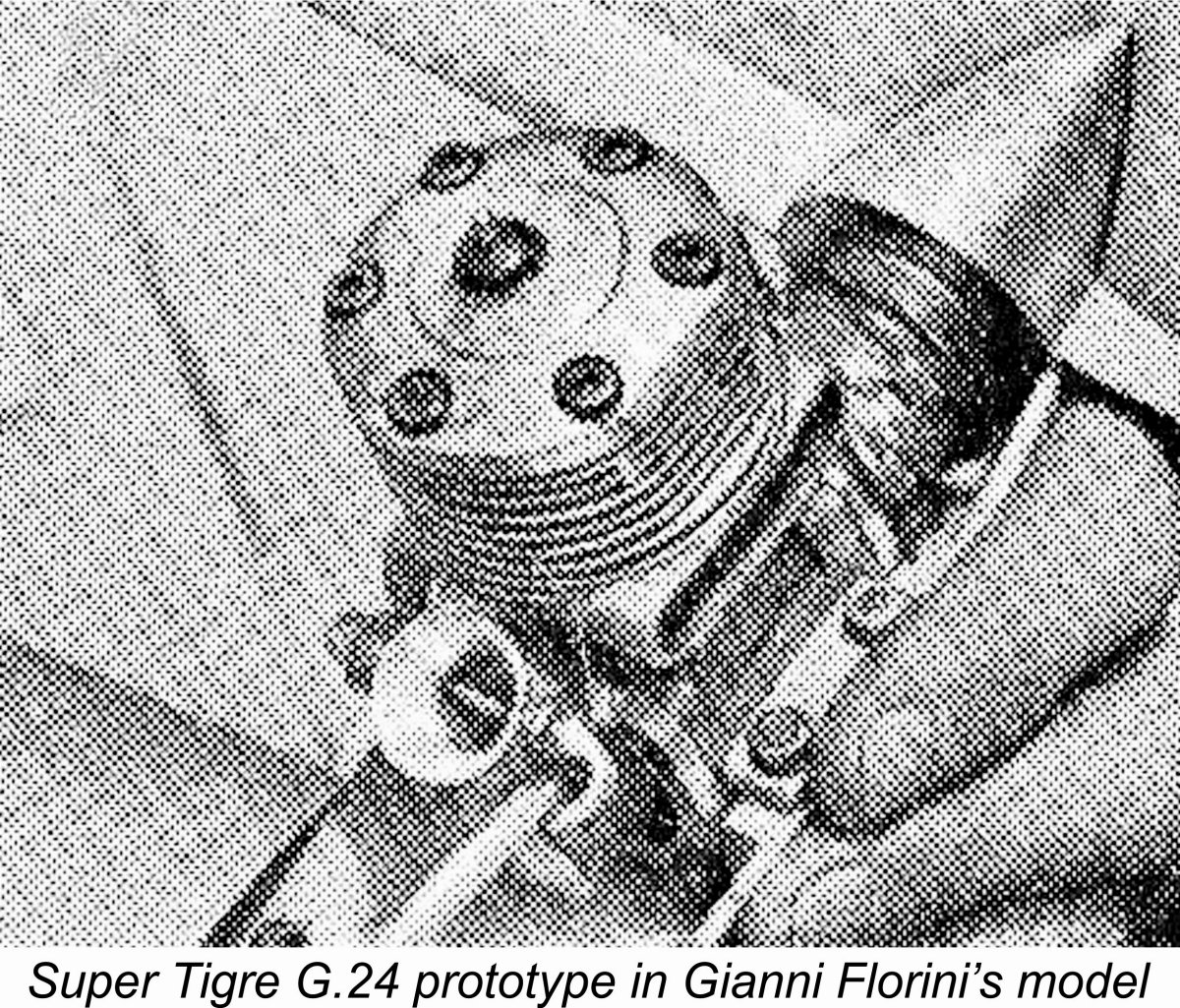 Knowing in advance that this event would not provide an opportunity for his 2.5 cc and 5 cc models to display their merits on the International stage at home, Signor Garofali quickly set about the development of a 10 cc racing engine to be called the G.24 (the G.22 and G.23 sports diesels had been released in the interim following the G.21 - see below). An early example of this model appeared at the 1953 Milan event in the hands of Gianni Fiorini.
Knowing in advance that this event would not provide an opportunity for his 2.5 cc and 5 cc models to display their merits on the International stage at home, Signor Garofali quickly set about the development of a 10 cc racing engine to be called the G.24 (the G.22 and G.23 sports diesels had been released in the interim following the G.21 - see below). An early example of this model appeared at the 1953 Milan event in the hands of Gianni Fiorini.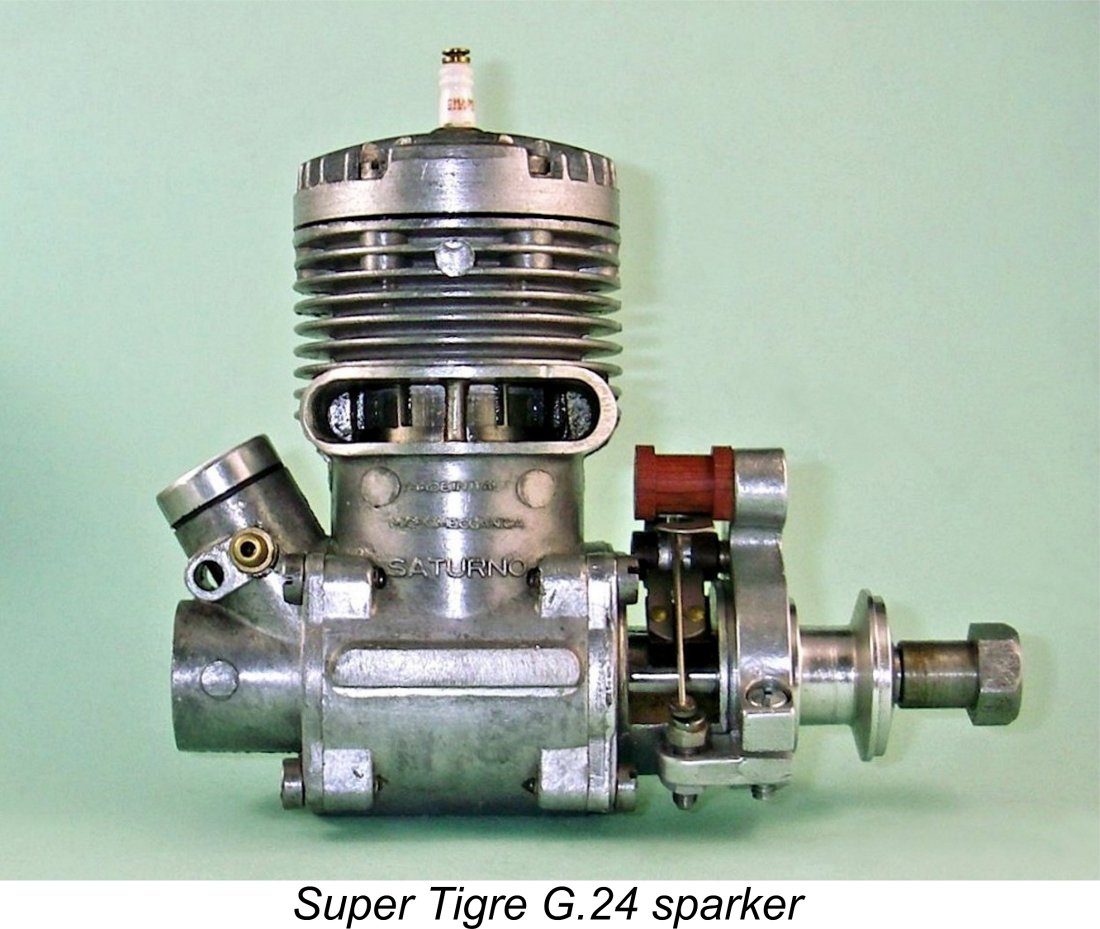 The G.24 was basically a fairly conventional large racing engine of its era, having cross-flow loop scavenging, a twin ball-race crankshaft and a lightweight alloy deflector piston with two rings. Its one notable departure from convention was its use of a rear drum valve induction system with downdraft intake as opposed to the more usual rear disc valve arrangement. Garofali was to use this system again in his later G.30 and G.31 diesel designs, of which more in due course.
The G.24 was basically a fairly conventional large racing engine of its era, having cross-flow loop scavenging, a twin ball-race crankshaft and a lightweight alloy deflector piston with two rings. Its one notable departure from convention was its use of a rear drum valve induction system with downdraft intake as opposed to the more usual rear disc valve arrangement. Garofali was to use this system again in his later G.30 and G.31 diesel designs, of which more in due course. 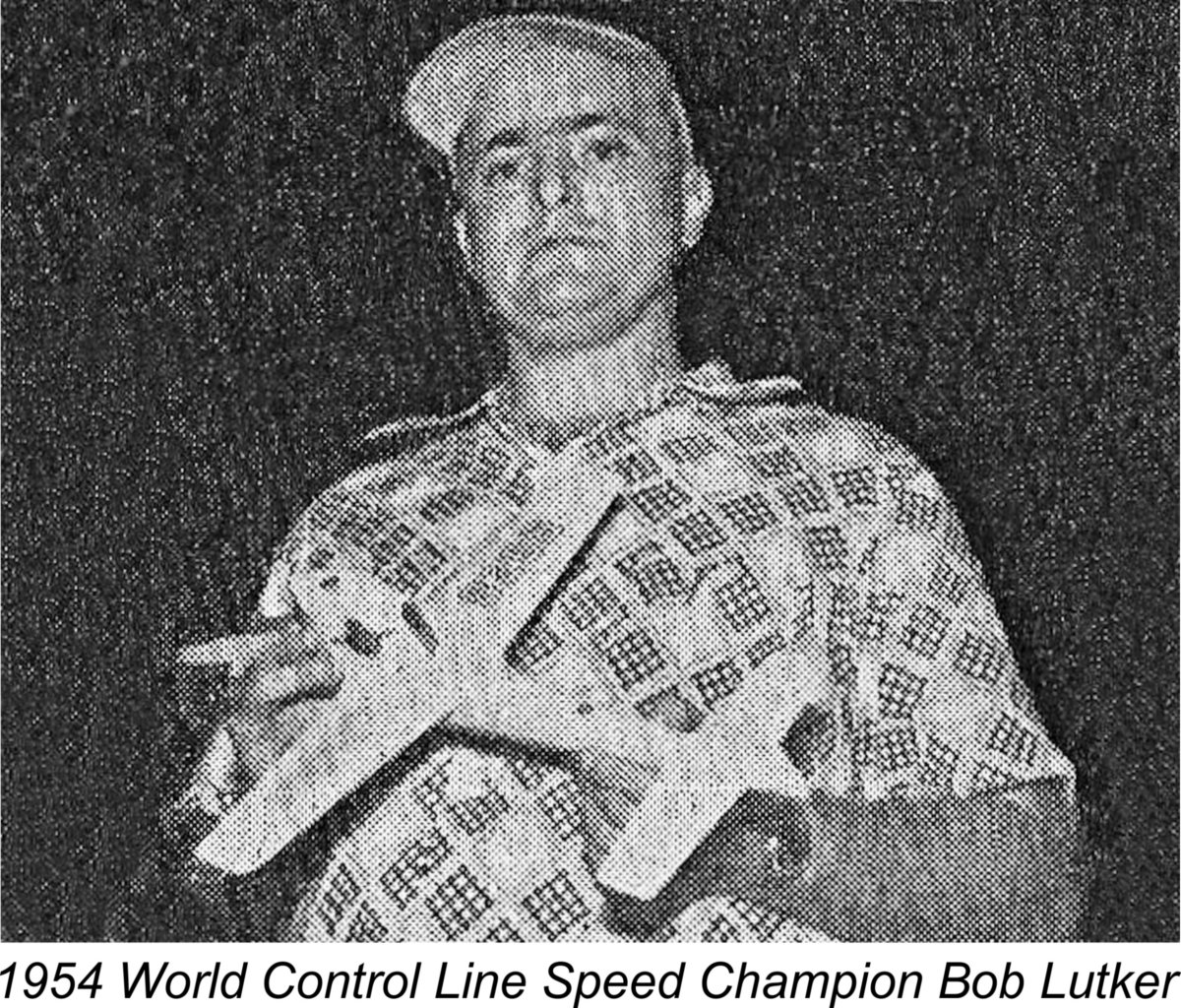 For 1954 the FAI hedged its bets somewhat by dropping the poorly-supported 10 cc class and offering both 2.5 cc and 5 cc classes at the World Championship meeting held that year at The Hague, Holland on August 20
For 1954 the FAI hedged its bets somewhat by dropping the poorly-supported 10 cc class and offering both 2.5 cc and 5 cc classes at the World Championship meeting held that year at The Hague, Holland on August 20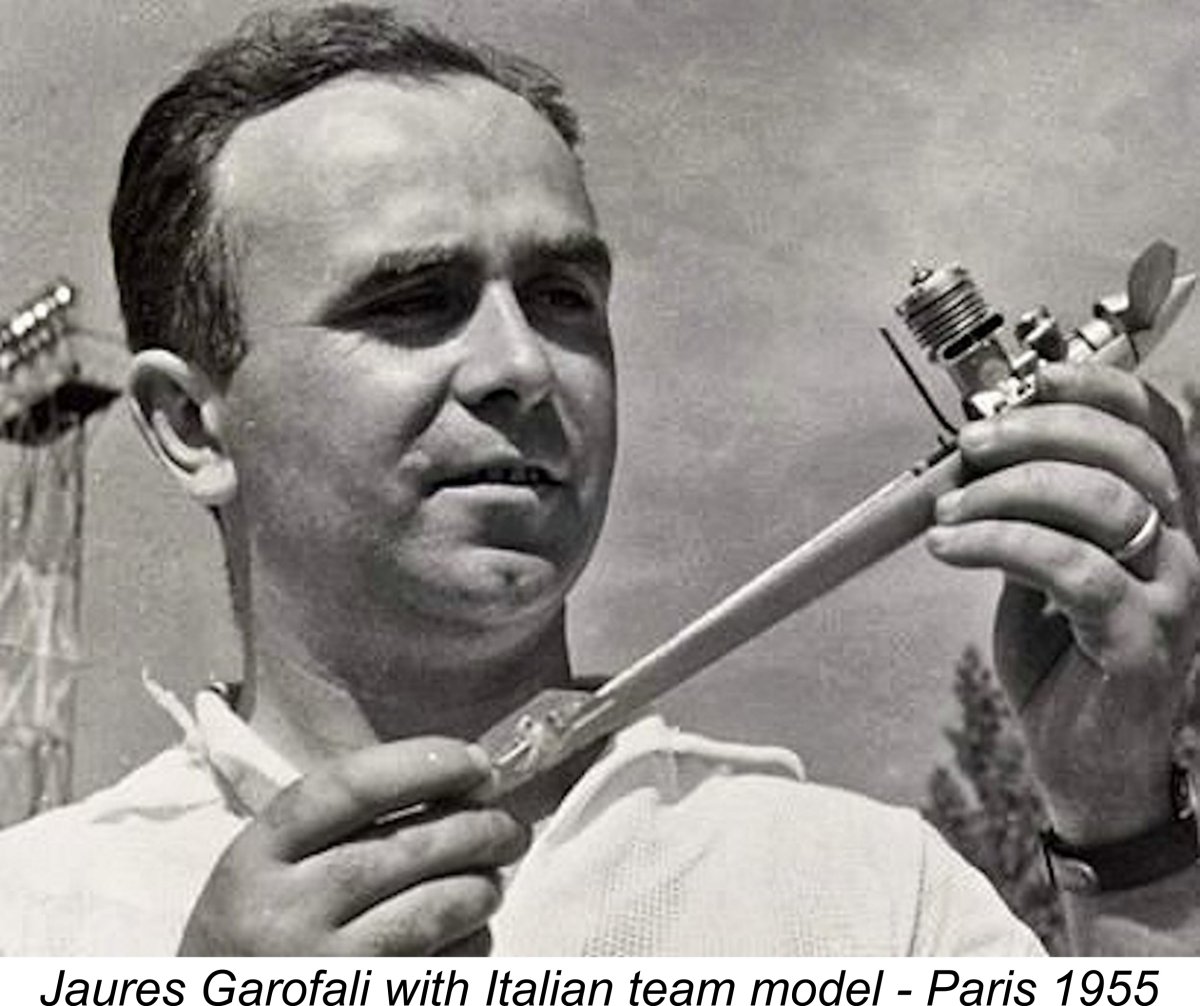
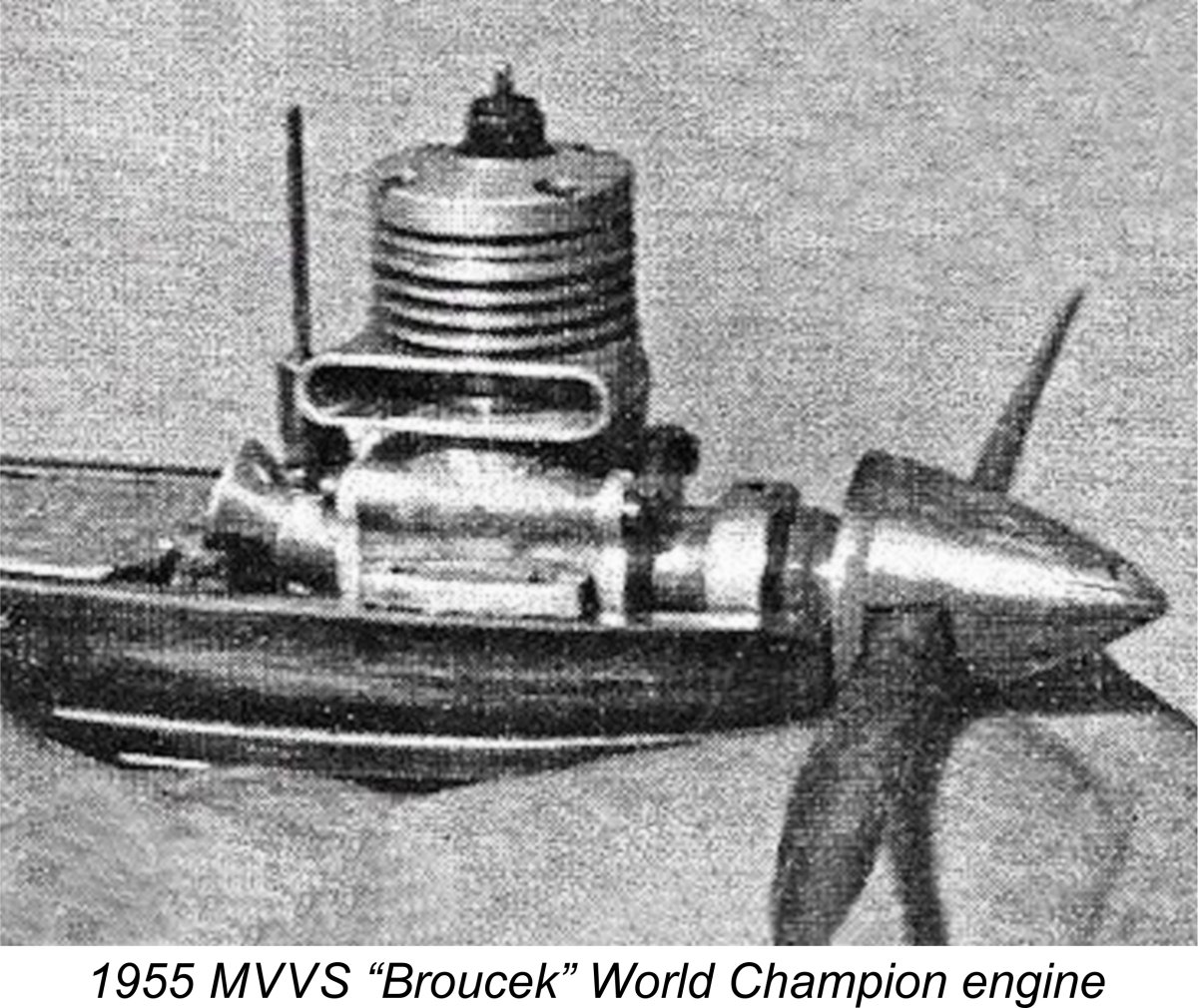 One of these engines was the SK-25 “Broucek” prototype which had been constructed in the MVVS workshops by Josef Sladký and Luboš Kočí (hence the letters in the engine's name). Using this one-off unit, Sladký won the individual title with a speed of 179.11 km.hr (111.30 mph). Amato Prati came in a frustratingly close second with his G.20 S powered model at a speed of 176.05 km/hr (109.39 mph), closely followed by his similarly-powered fellow Italian team members S. Monti and C. Cappi. Together with G. Gottarelli’s sixth place finish behind Mir Zatočil’s fifth-placed MVVS 25 (in essence, an FRV version of the winning SK-25), this was easily enough to give Italy the team title. However, the fact that the individual title had escaped cannot have sat well with Signor Garofali.
One of these engines was the SK-25 “Broucek” prototype which had been constructed in the MVVS workshops by Josef Sladký and Luboš Kočí (hence the letters in the engine's name). Using this one-off unit, Sladký won the individual title with a speed of 179.11 km.hr (111.30 mph). Amato Prati came in a frustratingly close second with his G.20 S powered model at a speed of 176.05 km/hr (109.39 mph), closely followed by his similarly-powered fellow Italian team members S. Monti and C. Cappi. Together with G. Gottarelli’s sixth place finish behind Mir Zatočil’s fifth-placed MVVS 25 (in essence, an FRV version of the winning SK-25), this was easily enough to give Italy the team title. However, the fact that the individual title had escaped cannot have sat well with Signor Garofali.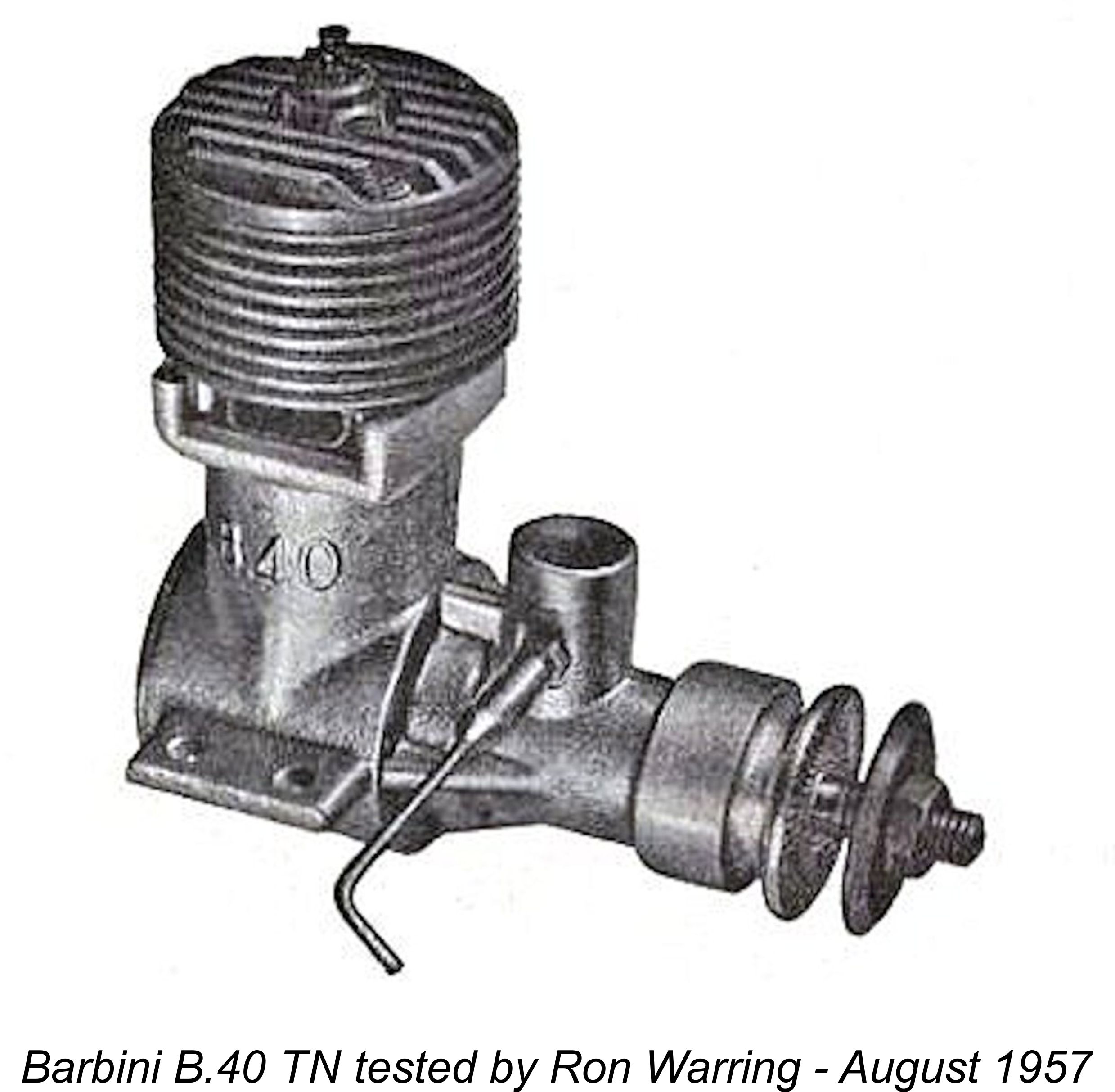 In that context, there can be little doubt that Garofali saw the 1956 World Control Line Speed Championship meeting as a golden opportunity to showcase his G.20 S, since the meeting was to be held on September 29
In that context, there can be little doubt that Garofali saw the 1956 World Control Line Speed Championship meeting as a golden opportunity to showcase his G.20 S, since the meeting was to be held on September 29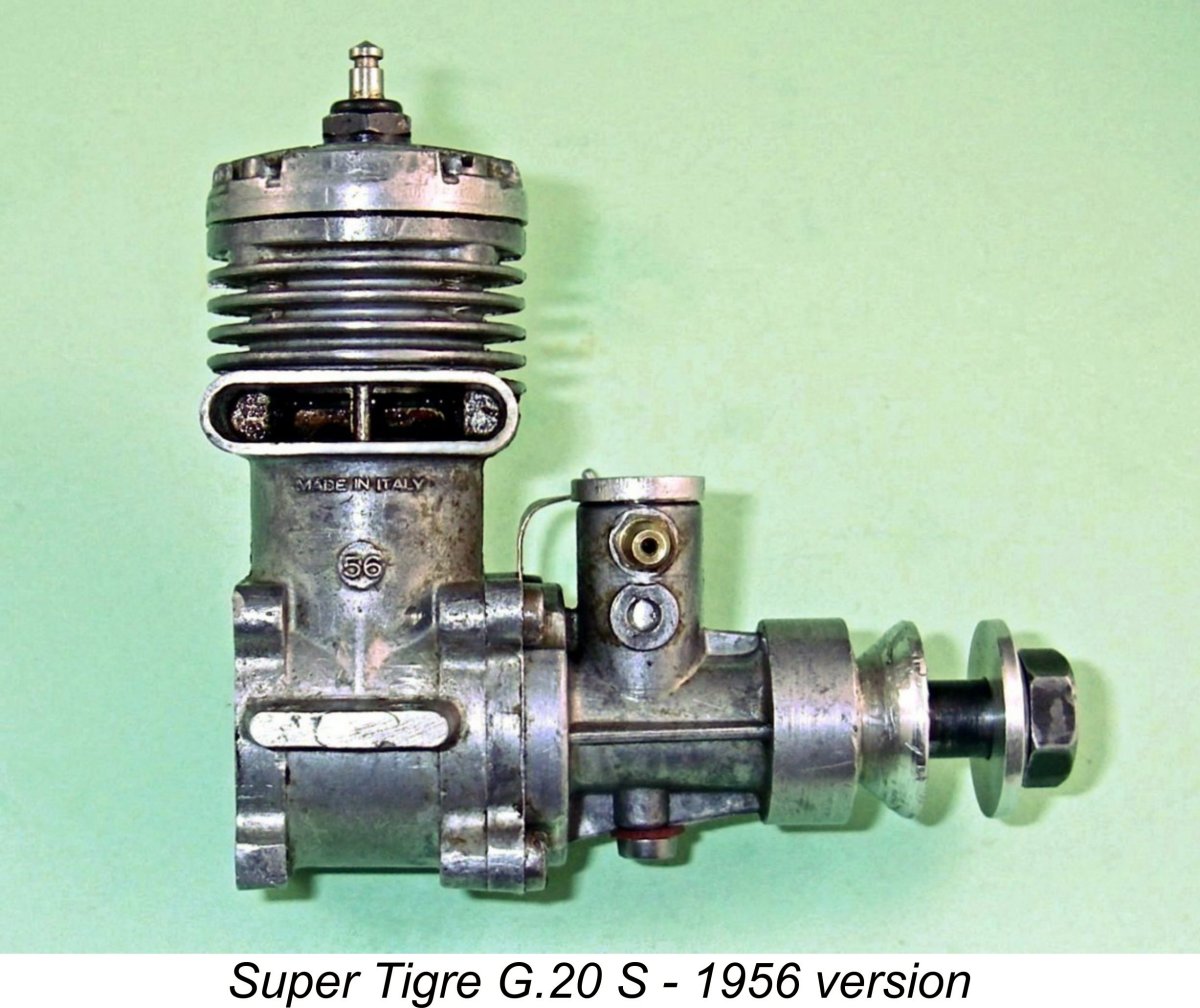
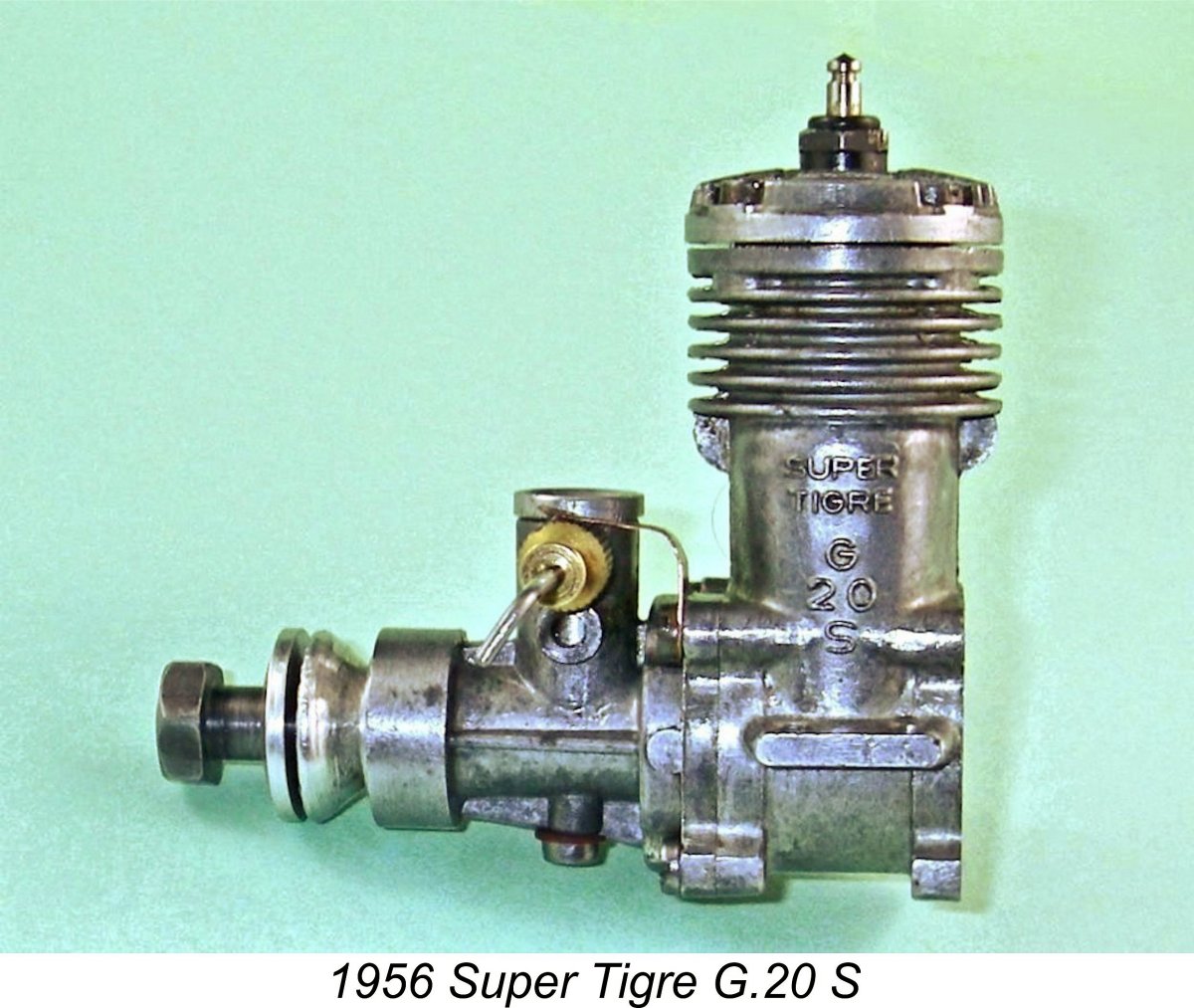 My illustrated example of the 1956 variant is a well-used former competition motor which has a filed exhaust stack, like many engines which have been used in competition. It was a very gracious gift from my valued Danish friend Luis Petersen, to whom my sincere thanks are due. I don't know the full details of the engine's internal arrangements or any modifications to which it may have been subjected, since I've never disturbed this well-settled unit. However, my own testing has revealed that on 30% nitro it develops over 0.410 BHP at around 17,500 RPM - a very sturdy performance indeed in a 1956 context. Clearly Garofali had tweaked this design to very good effect! The
My illustrated example of the 1956 variant is a well-used former competition motor which has a filed exhaust stack, like many engines which have been used in competition. It was a very gracious gift from my valued Danish friend Luis Petersen, to whom my sincere thanks are due. I don't know the full details of the engine's internal arrangements or any modifications to which it may have been subjected, since I've never disturbed this well-settled unit. However, my own testing has revealed that on 30% nitro it develops over 0.410 BHP at around 17,500 RPM - a very sturdy performance indeed in a 1956 context. Clearly Garofali had tweaked this design to very good effect! The 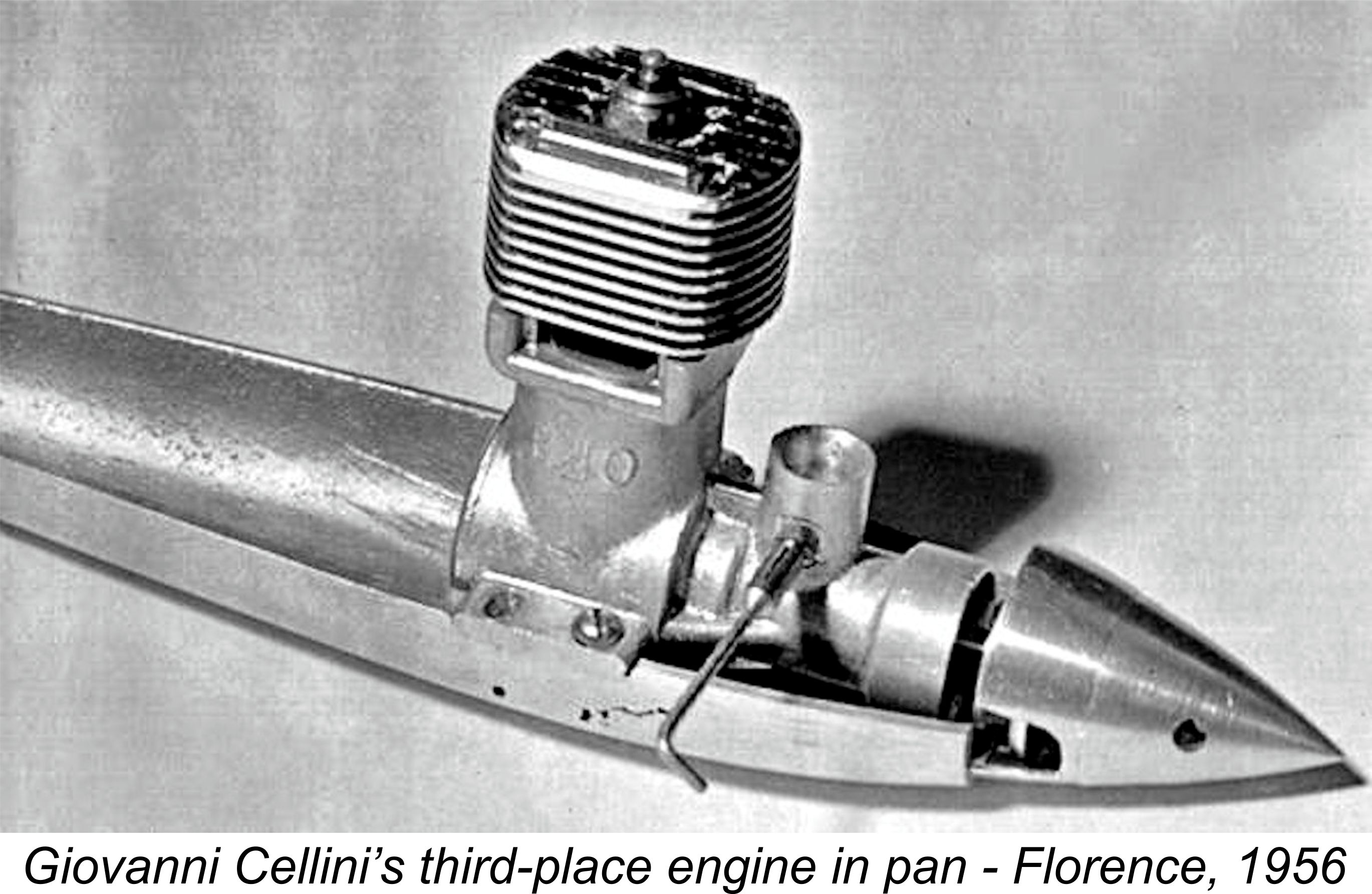 The achievement of Barbini and Cellini had been astonishing. The "old fashioned" B.40 TN had finished as the top commercial engine in the contest, leaving all of the fancied Super Tigre G.20’s and MVVS tool-room specials in its wake. The best speed achieved by any of the Super Tigre entries was 195 km/hr (121.17 mph), good enough only for fifth place behind Smejkal's fourth-place MVVS. Even this speed was set by the Spaniard J. Battlo, rather than an Italian, and it fell well short of Battlo's winning speed from earlier in the year at Brussels. Evidently the Super Tigres were not at their best at this meeting!
The achievement of Barbini and Cellini had been astonishing. The "old fashioned" B.40 TN had finished as the top commercial engine in the contest, leaving all of the fancied Super Tigre G.20’s and MVVS tool-room specials in its wake. The best speed achieved by any of the Super Tigre entries was 195 km/hr (121.17 mph), good enough only for fifth place behind Smejkal's fourth-place MVVS. Even this speed was set by the Spaniard J. Battlo, rather than an Italian, and it fell well short of Battlo's winning speed from earlier in the year at Brussels. Evidently the Super Tigres were not at their best at this meeting! 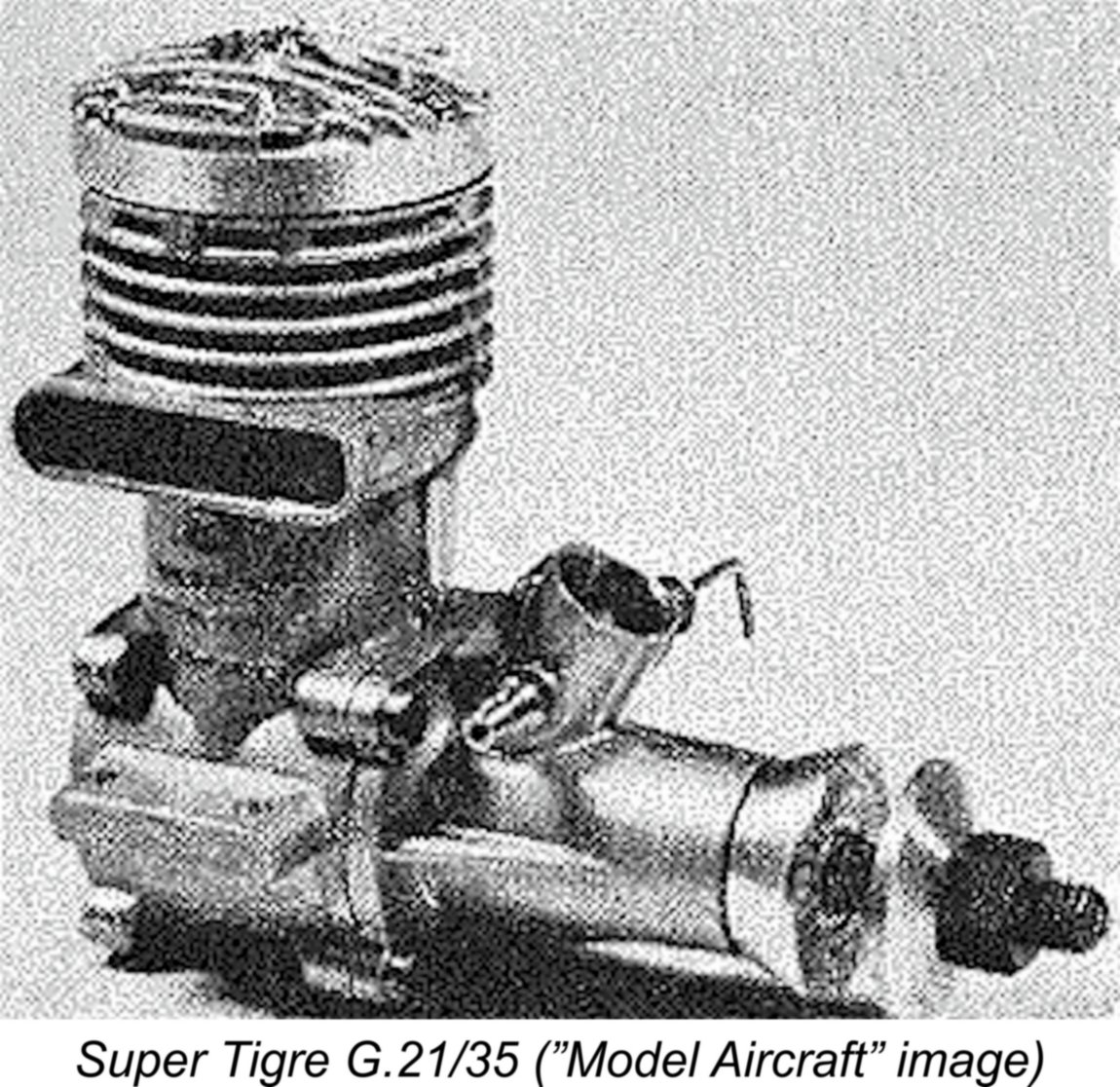 In 1954 a lapped piston version of this model had become available, reflecting the parallel change which had been made to the G.20 at the same time. In 1956 Garofali took steps to further increase the range of applications for which the G.21 was suitable. A new version of the G.21 called the G.21/35 was released which had an increased displacement of 5.235 cc (0.32 cuin.). The larger displacement was achieved by increasing both the bore and stroke of the engine to 19.5 mm and 18.0 mm respectively.
In 1954 a lapped piston version of this model had become available, reflecting the parallel change which had been made to the G.20 at the same time. In 1956 Garofali took steps to further increase the range of applications for which the G.21 was suitable. A new version of the G.21 called the G.21/35 was released which had an increased displacement of 5.235 cc (0.32 cuin.). The larger displacement was achieved by increasing both the bore and stroke of the engine to 19.5 mm and 18.0 mm respectively.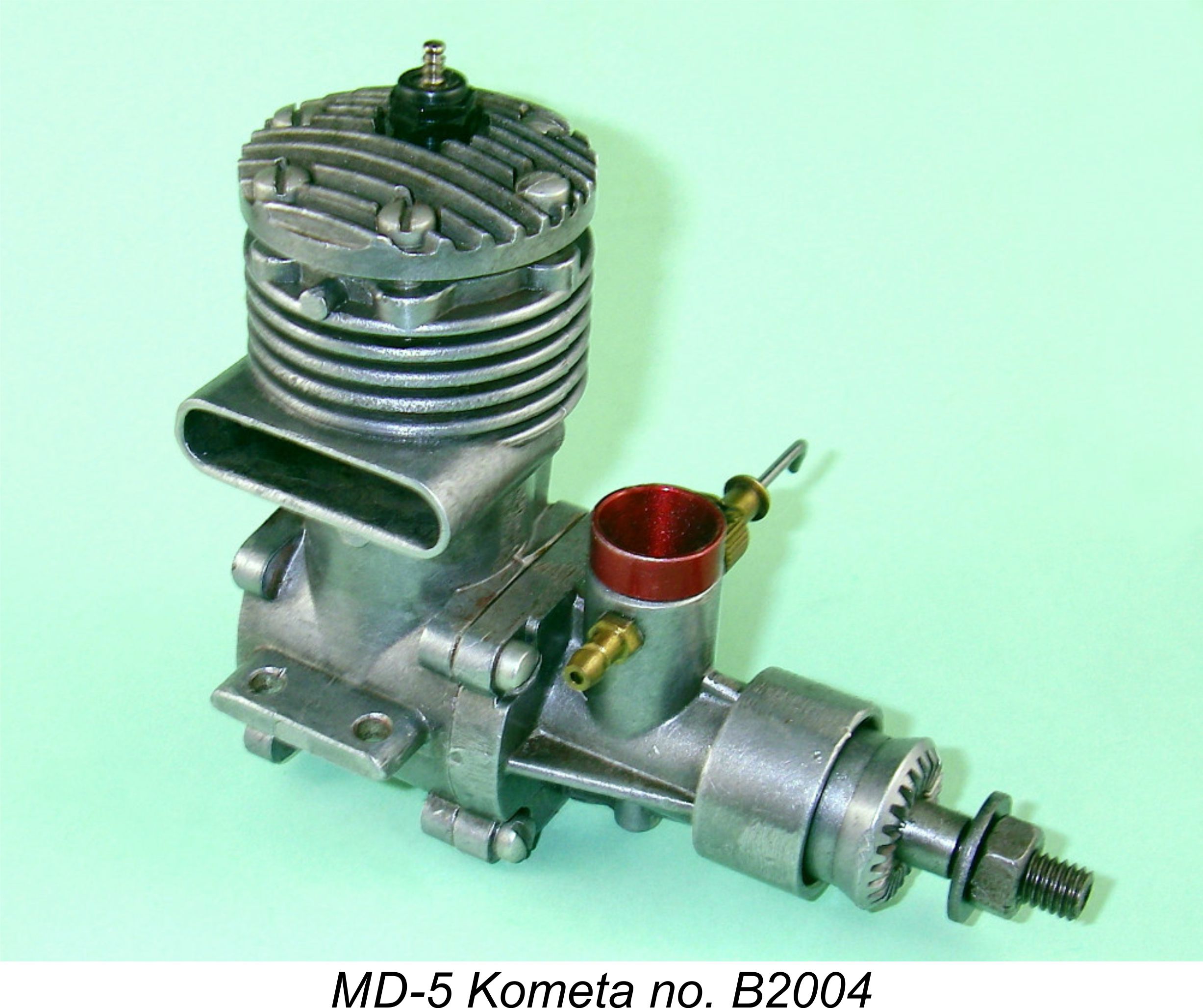 It's often been said that imitation is the sincerest form of flattery. This being the case, the Russians paid Super Tigre a very high compliment in 1957 when they introduced the MD-5 Kometa glow-plug model. This engine was nothing less than a clone of the 5 cc Super Tigre G.21 model. Although not as well made as the Italian originals, it was a perfectly servicable engine which performed at a quite respectable level, especially if properly sorted before break-in. It was primarily intended for use in the Russian technical training programs for young people, but was nonetheless used by the Russian stunt team to secure a very creditable 5
It's often been said that imitation is the sincerest form of flattery. This being the case, the Russians paid Super Tigre a very high compliment in 1957 when they introduced the MD-5 Kometa glow-plug model. This engine was nothing less than a clone of the 5 cc Super Tigre G.21 model. Although not as well made as the Italian originals, it was a perfectly servicable engine which performed at a quite respectable level, especially if properly sorted before break-in. It was primarily intended for use in the Russian technical training programs for young people, but was nonetheless used by the Russian stunt team to secure a very creditable 5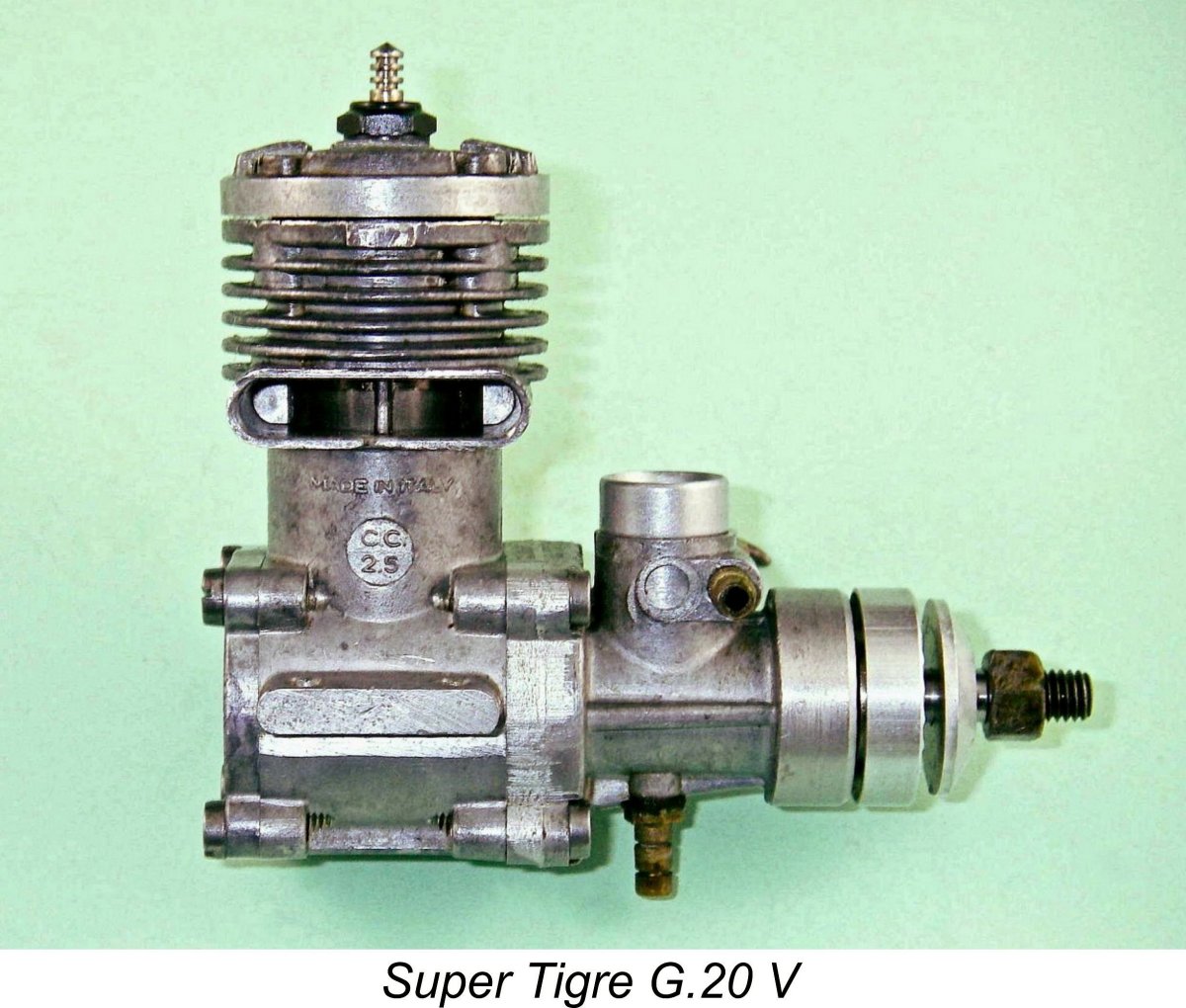 The new G.20 V featured a strengthened crankcase having far more sturdy mounting lugs, thus addressing an often-noted criticism of the earlier G.20 models. As hinted with the previous 1956 G.20 S, a removable bolt-on rear cover was now used in place of the former integrally-cast component.
The new G.20 V featured a strengthened crankcase having far more sturdy mounting lugs, thus addressing an often-noted criticism of the earlier G.20 models. As hinted with the previous 1956 G.20 S, a removable bolt-on rear cover was now used in place of the former integrally-cast component. 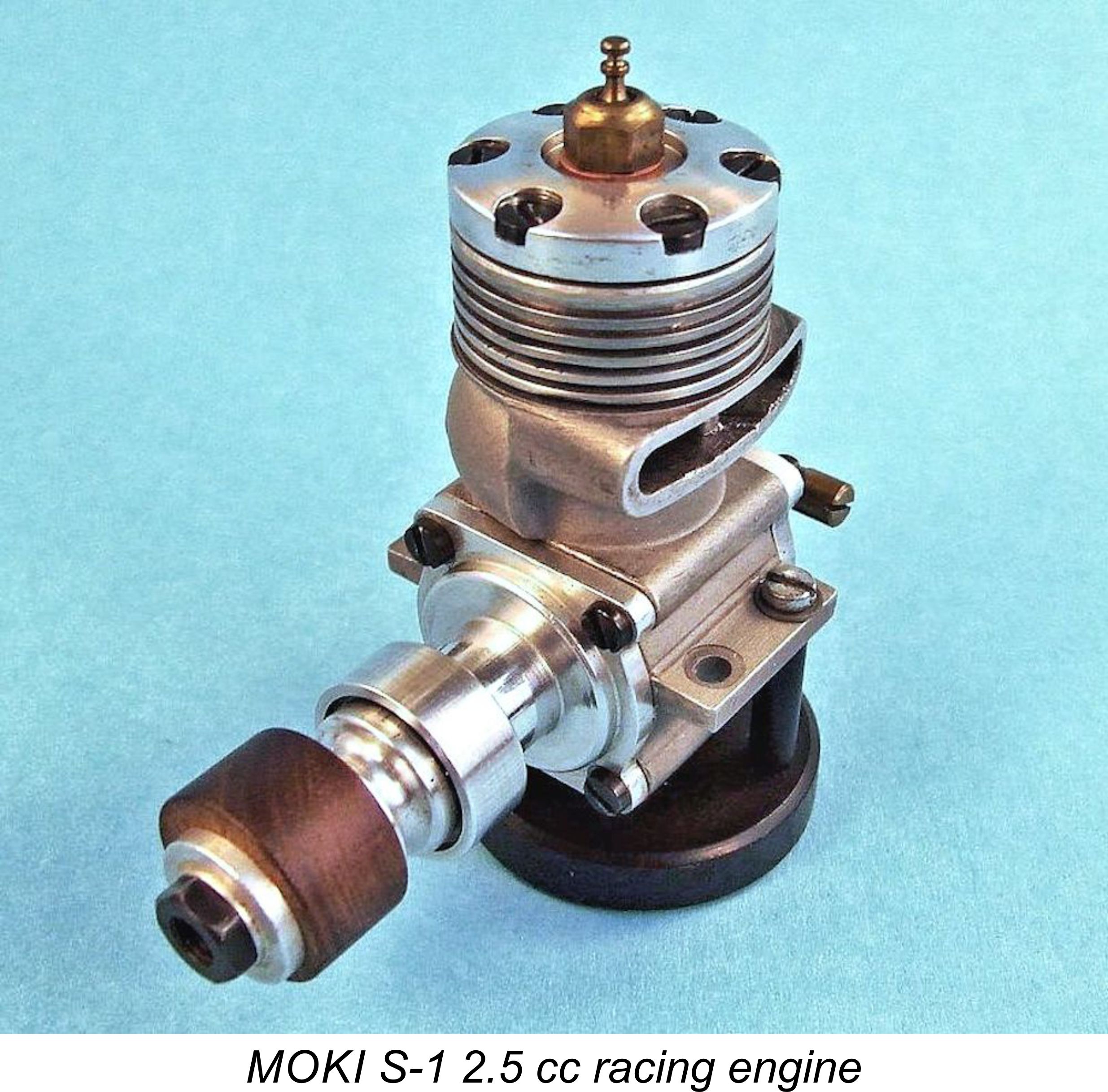 So ….. back to the drawing board and on to the next year, with hopes for better things! However, by 1958 the “commercial” manufacturers were no longer getting a look in. In 1957 the Hungarian government of the day followed the lead of their Czech counterparts by establishing their own version of the MVVS institute in the form of the Modell Kisérleti Intézet (Experimental Modeling Institute) at Buadörs Airport near Budapest.
So ….. back to the drawing board and on to the next year, with hopes for better things! However, by 1958 the “commercial” manufacturers were no longer getting a look in. In 1957 the Hungarian government of the day followed the lead of their Czech counterparts by establishing their own version of the MVVS institute in the form of the Modell Kisérleti Intézet (Experimental Modeling Institute) at Buadörs Airport near Budapest. 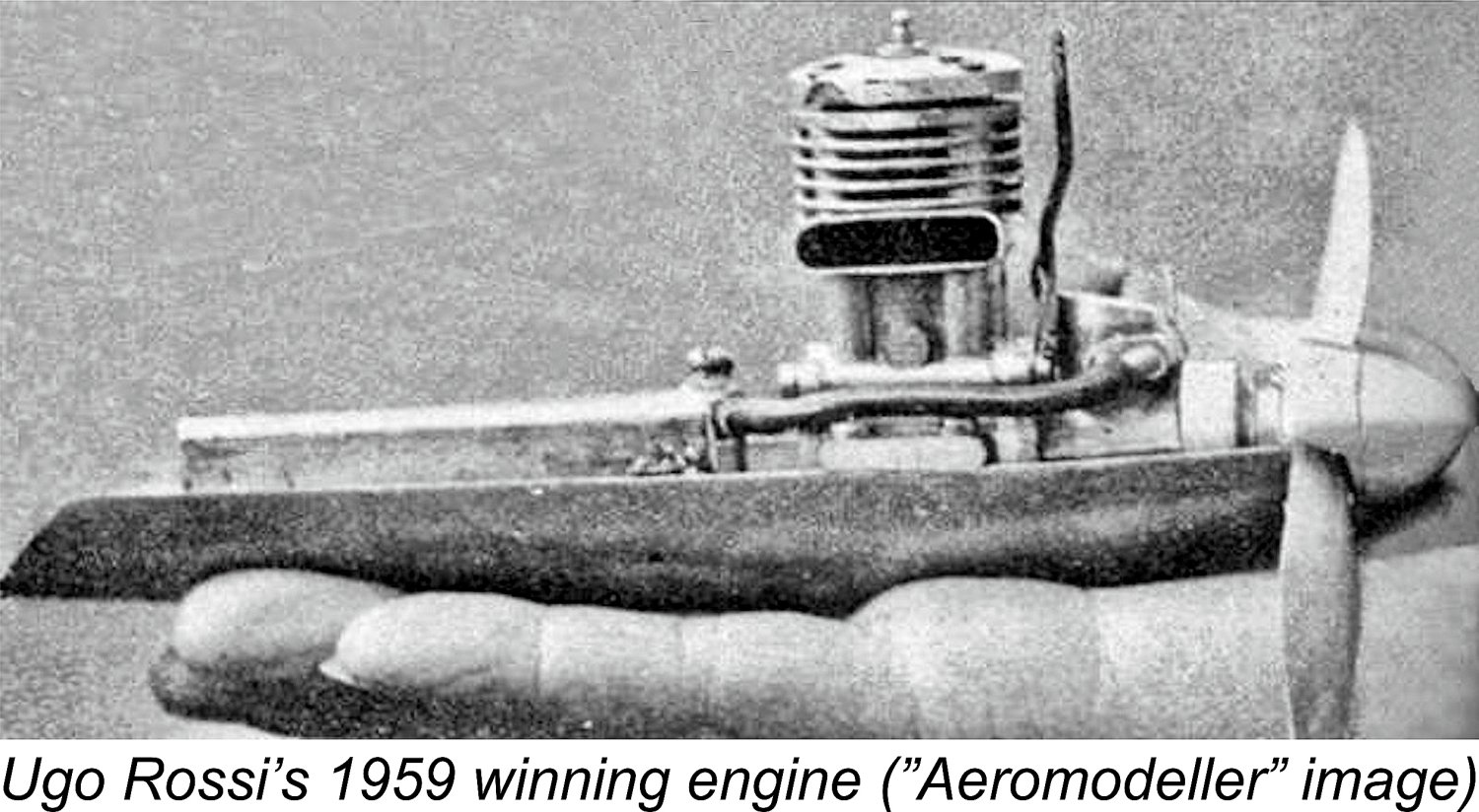 The engines used by the Italians at this meeting were in fact hybrid prototypes of what would become the Super Tigre G.20/15V "Jubilee" model which appeared in the following year (see below). As the attached image from the "Aeromodeller" report on the meeting shows, the winning engine featured a Jubilee-style crankcase which was fitted with a G.20 V front end and rear cover. The engine utilized Garofali's ground-breaking directional cylinder porting which allowed the use of a flat-topped piston having no baffle.
The engines used by the Italians at this meeting were in fact hybrid prototypes of what would become the Super Tigre G.20/15V "Jubilee" model which appeared in the following year (see below). As the attached image from the "Aeromodeller" report on the meeting shows, the winning engine featured a Jubilee-style crankcase which was fitted with a G.20 V front end and rear cover. The engine utilized Garofali's ground-breaking directional cylinder porting which allowed the use of a flat-topped piston having no baffle. 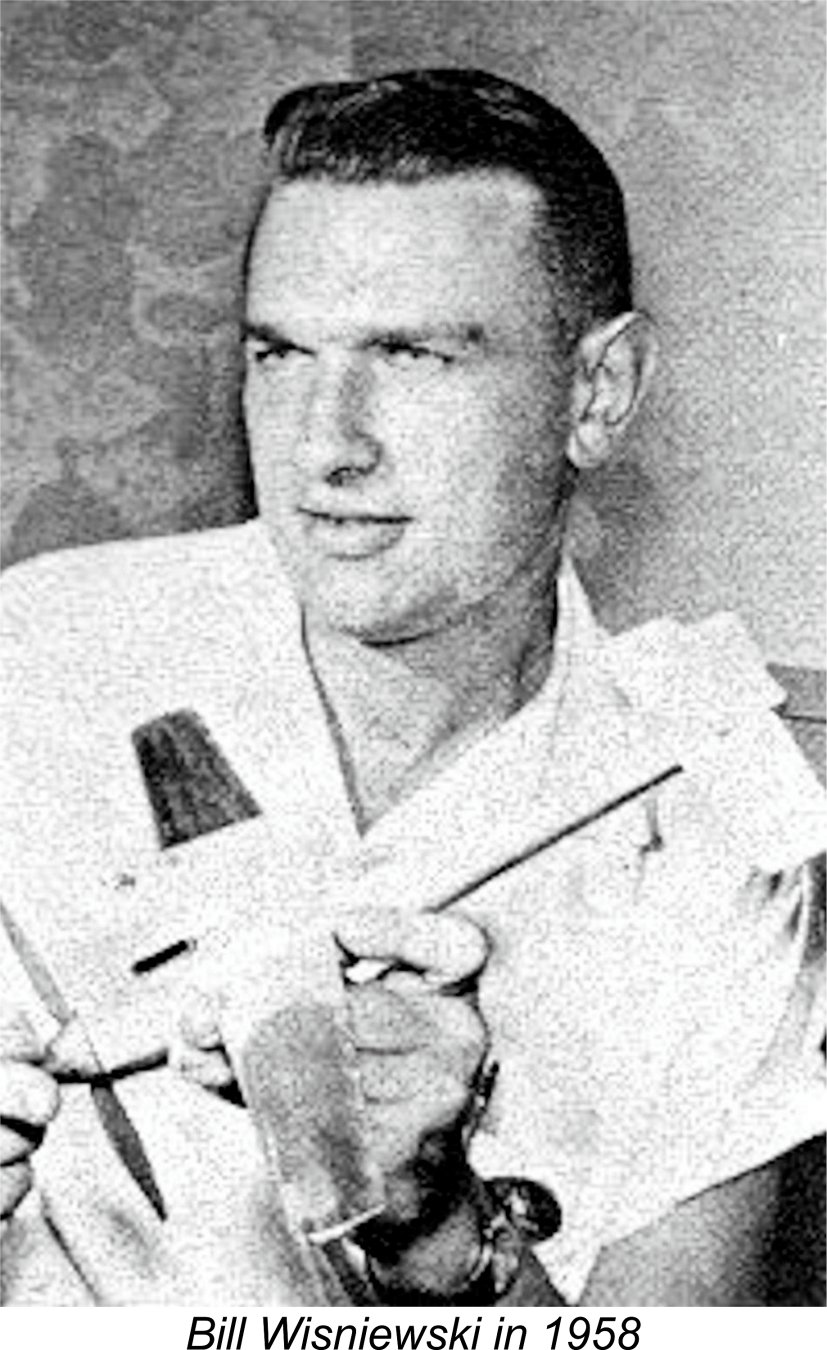 Unfortunately, we now come to the one sour note in this otherwise very positive saga. Having finally got to the top of the heap, Jaures Garofali was naturally very keen indeed to stay there. Just how keen was soon to become glaringly apparent.
Unfortunately, we now come to the one sour note in this otherwise very positive saga. Having finally got to the top of the heap, Jaures Garofali was naturally very keen indeed to stay there. Just how keen was soon to become glaringly apparent. The very lame defensive argument put forward by the Italians was that whipping was not specifically banned (which was unfortunately true at this stage). Maybe, but whipping wasn't the issue here. The point was that Rossi was so far ahead of his model that he was actually shortening his flight circle radius, thus failing to complete the timed 1 km distance. His action clearly merited his instant disqualification by an unbiased FAI jury - no protest should have been necessary. The British team did lodge an official protest on this basis, but this was ignored by the officials without response.
The very lame defensive argument put forward by the Italians was that whipping was not specifically banned (which was unfortunately true at this stage). Maybe, but whipping wasn't the issue here. The point was that Rossi was so far ahead of his model that he was actually shortening his flight circle radius, thus failing to complete the timed 1 km distance. His action clearly merited his instant disqualification by an unbiased FAI jury - no protest should have been necessary. The British team did lodge an official protest on this basis, but this was ignored by the officials without response. 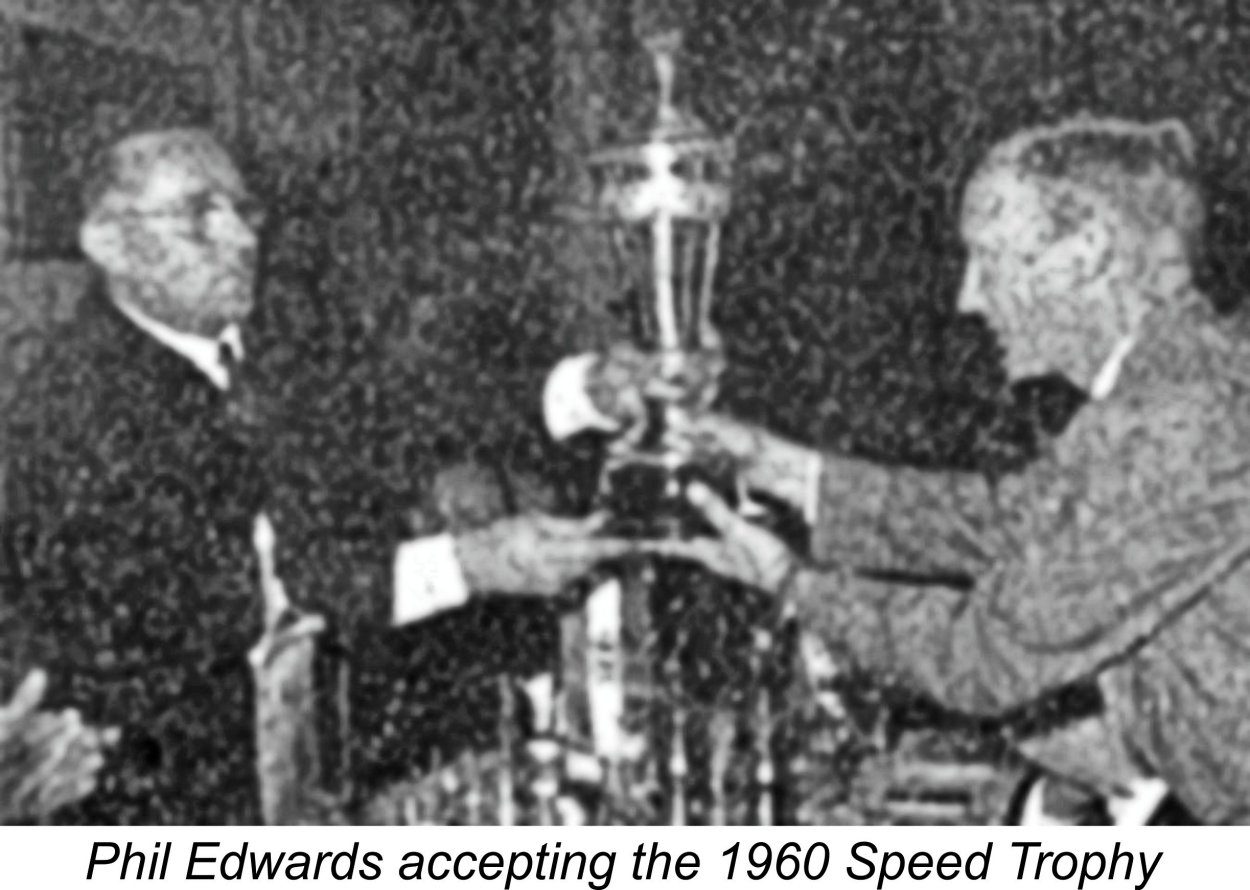 The Hungarian organizers had prepared special trophies of their own to be presented to the speed and team race winners. They showed their opinion of the official results by presenting the speed trophy to the Americans, "contrary to announcement" according to the "Aeromodeller" report. Perhaps diplomatically, the trophy was accepted by the Acting Manager of the American team, Phil Edwards, rather than by Bill Wisniewski!
The Hungarian organizers had prepared special trophies of their own to be presented to the speed and team race winners. They showed their opinion of the official results by presenting the speed trophy to the Americans, "contrary to announcement" according to the "Aeromodeller" report. Perhaps diplomatically, the trophy was accepted by the Acting Manager of the American team, Phil Edwards, rather than by Bill Wisniewski! 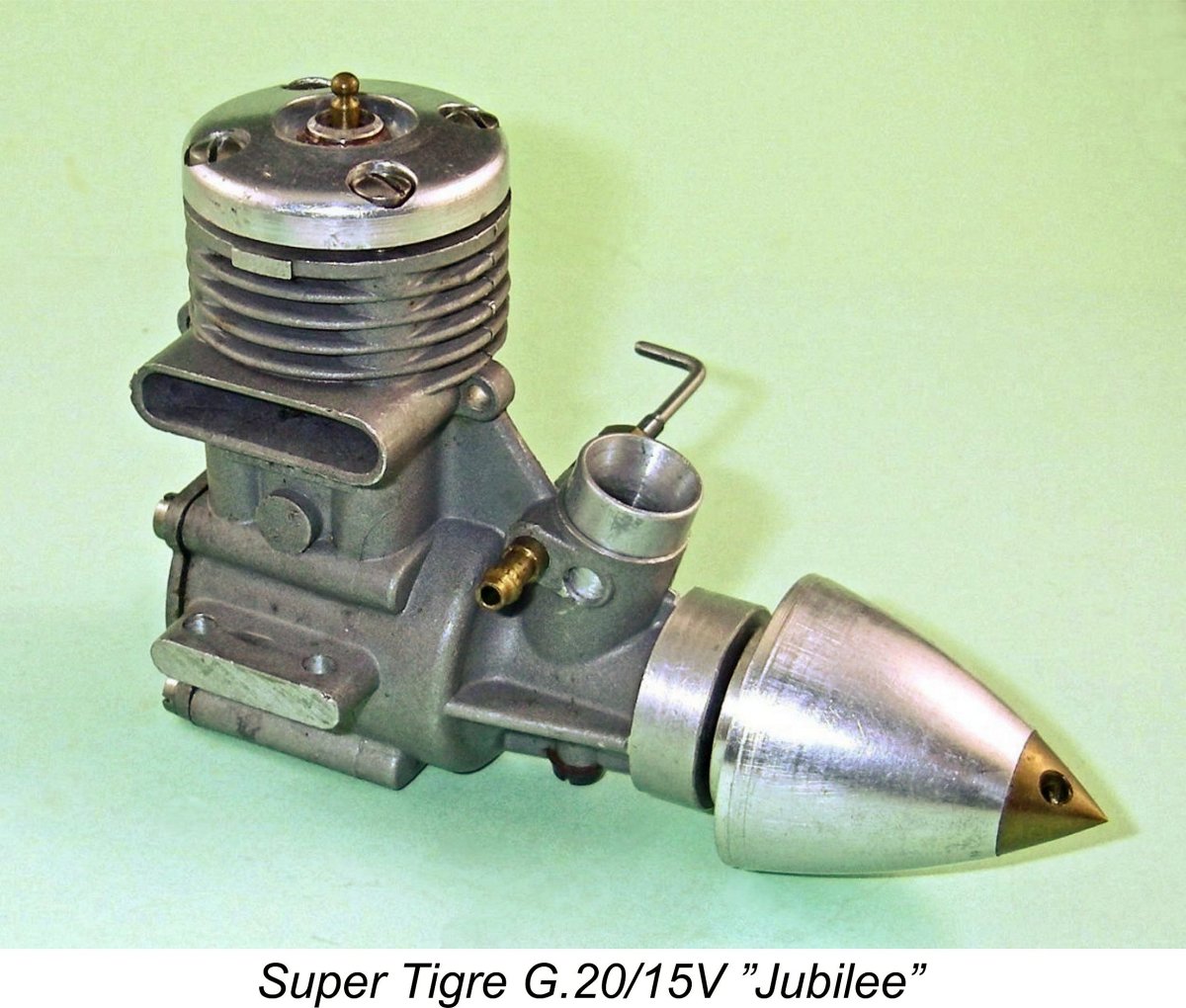 Returning now to 1960, and setting aside all such controversy, it was objectively clear to everyone, not just Bill Wisniwewski, that Jaures Garofali had made great strides during the development of the radically modified Super Tigre G.20 prototypes used by the Rossi brothers. A production version of this engine appeared almost immediately in the shape of the Super Tigre G.20/15V “Giubileo” (Jubilee) model. The Jubilee name evidently celebrated the fact that the G.20 had now completed its tenth year in production. For the first time, the engine was made available in both glow-plug and diesel versions.
Returning now to 1960, and setting aside all such controversy, it was objectively clear to everyone, not just Bill Wisniwewski, that Jaures Garofali had made great strides during the development of the radically modified Super Tigre G.20 prototypes used by the Rossi brothers. A production version of this engine appeared almost immediately in the shape of the Super Tigre G.20/15V “Giubileo” (Jubilee) model. The Jubilee name evidently celebrated the fact that the G.20 had now completed its tenth year in production. For the first time, the engine was made available in both glow-plug and diesel versions.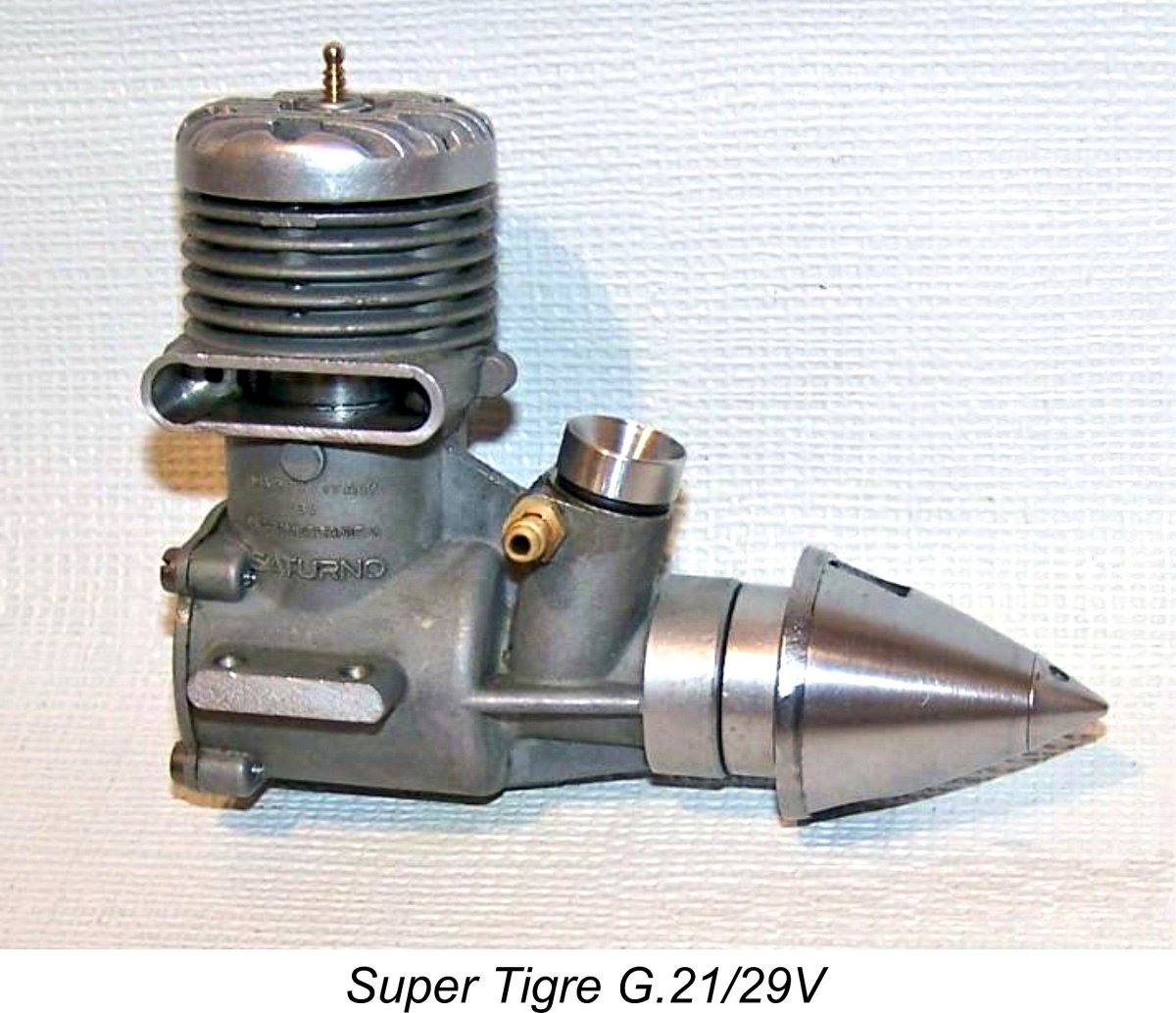 The companion Super Tigre G.21 design was altered similarly at the same time, with the same one-piece crankcase/front housing casting and similarly radical cylinder port timing in the case of the racing versions. The revised 5 cc racing model was designated the G.21/29V to distinguish it from its two companion models which were based on the same crankcase. These were an updated version of the G.21/35 which was intended for AMA control line combat and the G.21/40 which was offered in both ringed R/C and lapped rat race versions. It’s worth noting in passing that the manufacturer claimed an output of no less than 0.95 BHP for the G.21/29V running on a high-nitro fuel. If true, this certainly placed it at or near the top of the 5 cc performance stakes as of 1960.
The companion Super Tigre G.21 design was altered similarly at the same time, with the same one-piece crankcase/front housing casting and similarly radical cylinder port timing in the case of the racing versions. The revised 5 cc racing model was designated the G.21/29V to distinguish it from its two companion models which were based on the same crankcase. These were an updated version of the G.21/35 which was intended for AMA control line combat and the G.21/40 which was offered in both ringed R/C and lapped rat race versions. It’s worth noting in passing that the manufacturer claimed an output of no less than 0.95 BHP for the G.21/29V running on a high-nitro fuel. If true, this certainly placed it at or near the top of the 5 cc performance stakes as of 1960.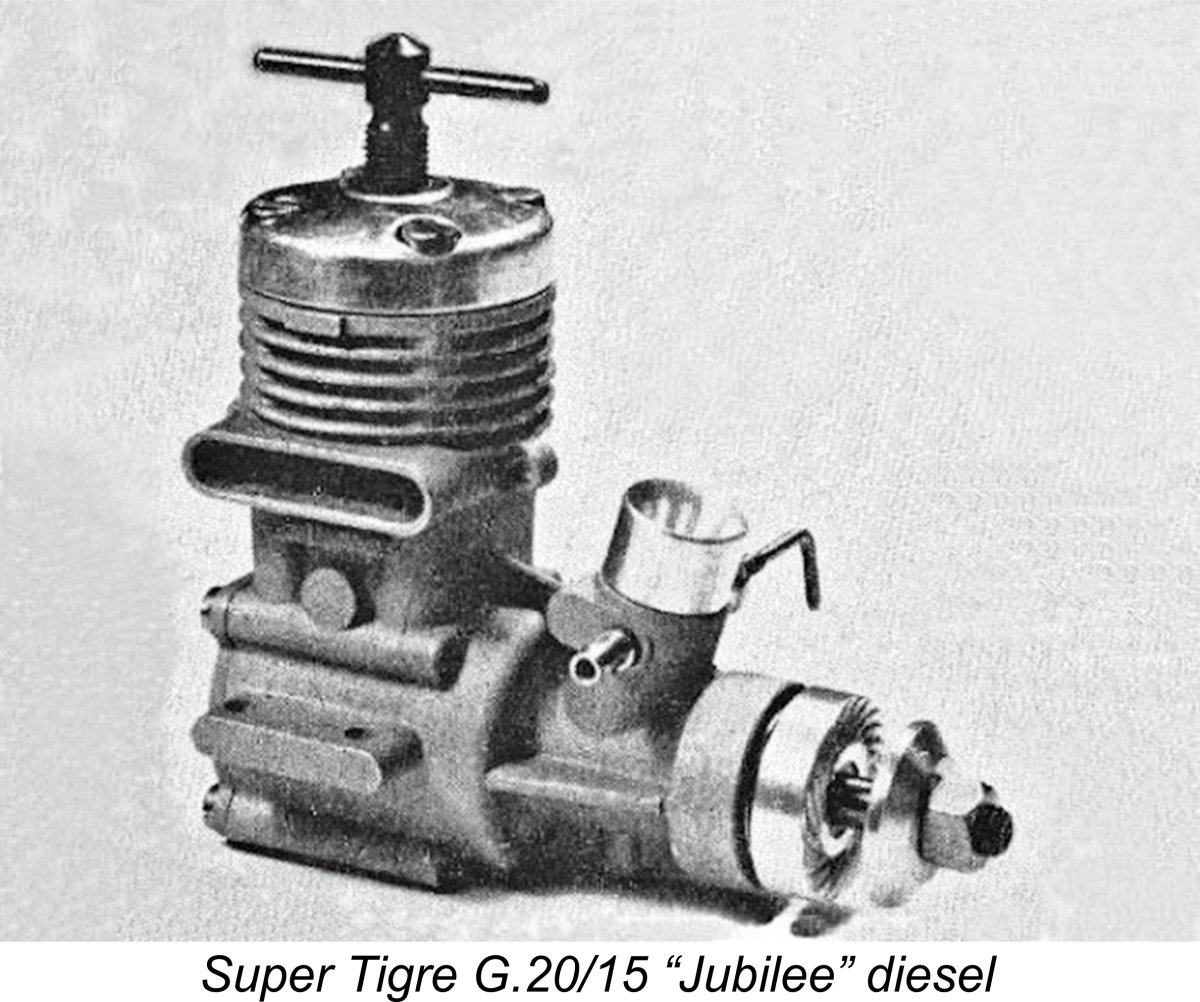 Peter Chinn published tests of both diesel and glow-plug versions of this engine. His
Peter Chinn published tests of both diesel and glow-plug versions of this engine. His 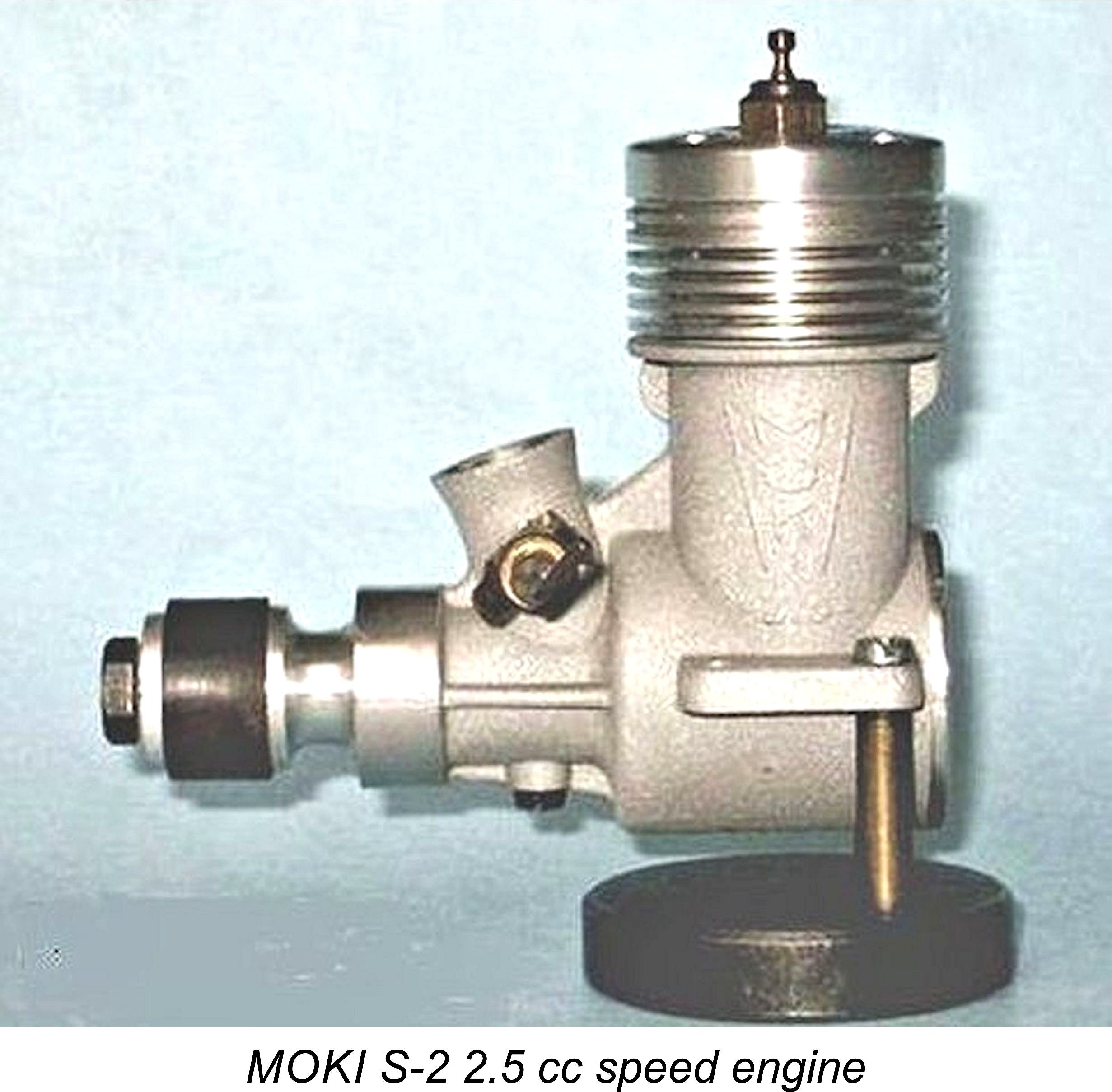 Chinn’s test report on the
Chinn’s test report on the 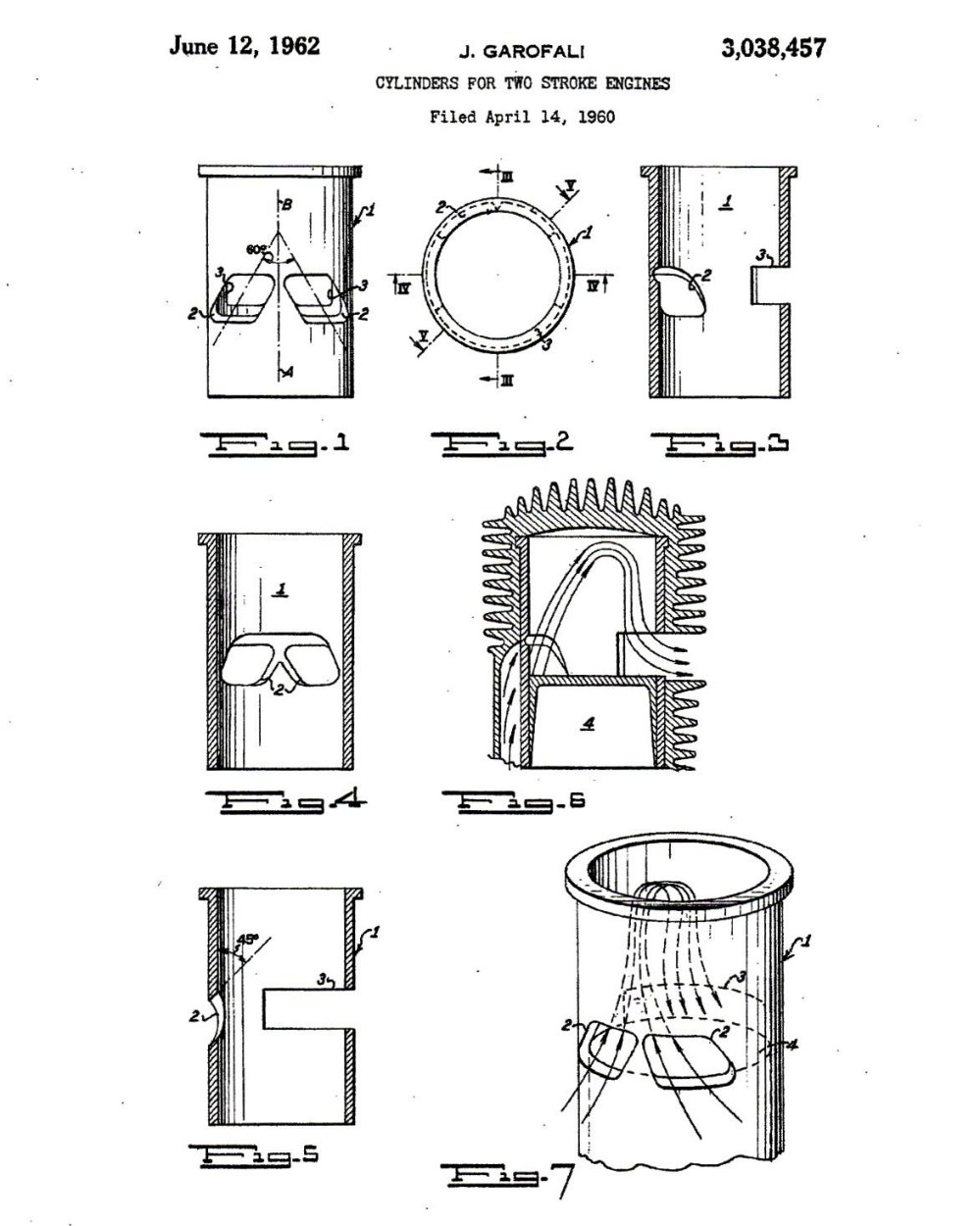 speed of 202.25 km/hr (125.67 mph). The best Super Tigre performance was put up by the veteran Amato Prati, who came in fourth with a speed of 189.47 km/hr (117.73 mph) using a G.20/15V.
speed of 202.25 km/hr (125.67 mph). The best Super Tigre performance was put up by the veteran Amato Prati, who came in fourth with a speed of 189.47 km/hr (117.73 mph) using a G.20/15V.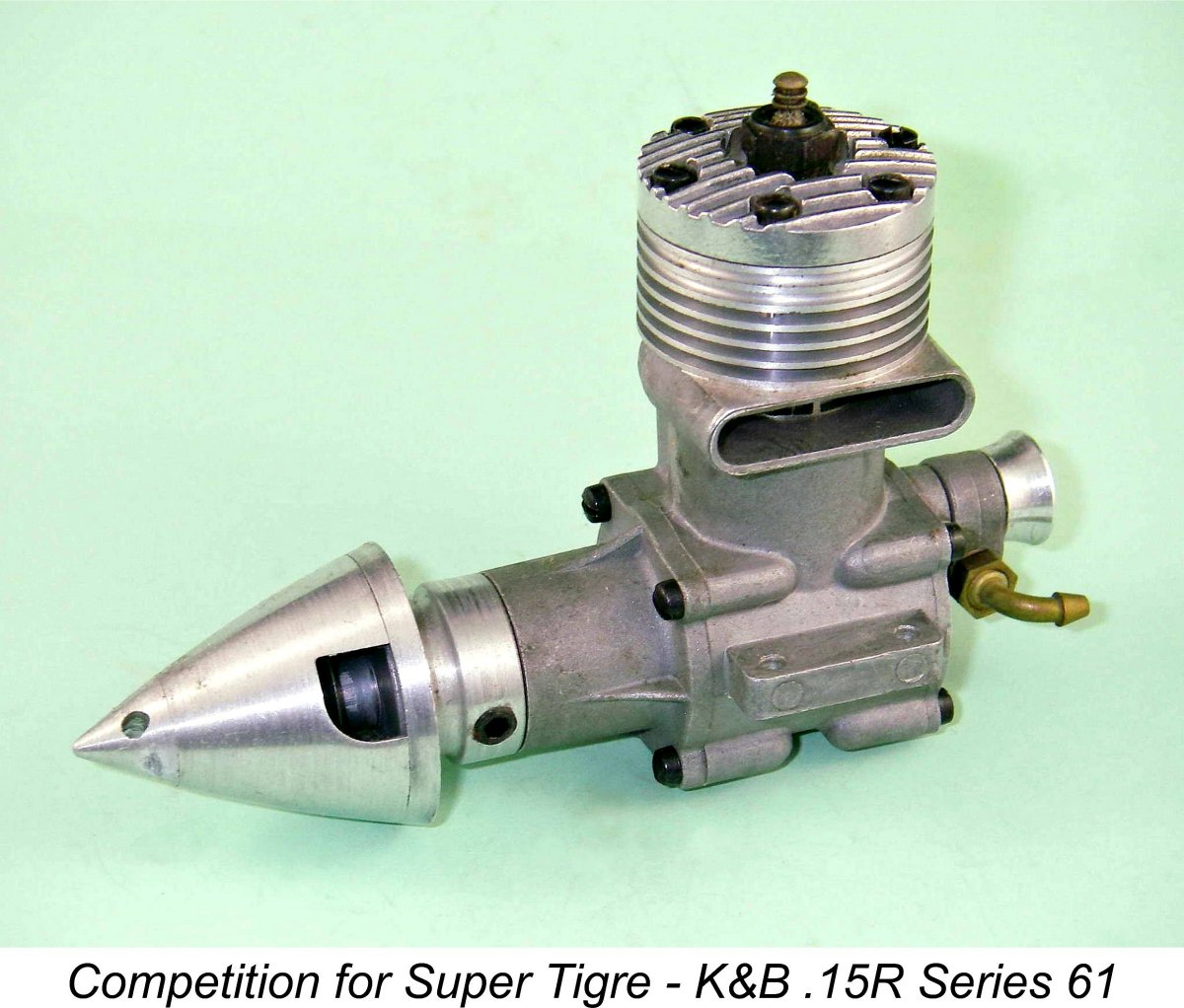 Notwithstanding the 1961 results, the fact remained that the Super Tigre G.20/15V was still the most powerful 2.5 cc engine commercially available to the general public, being challenged only by the successive American K&B Torpedo 15R models which were developed from Bill Wisniewski's 1960 World Championship powerplant beginning in 1961. The G.20/15V continued to be widely used for some years to come, doing great credit to the Super Tigre name. In 1964 it was joined by the even more powerful G.15 model.
Notwithstanding the 1961 results, the fact remained that the Super Tigre G.20/15V was still the most powerful 2.5 cc engine commercially available to the general public, being challenged only by the successive American K&B Torpedo 15R models which were developed from Bill Wisniewski's 1960 World Championship powerplant beginning in 1961. The G.20/15V continued to be widely used for some years to come, doing great credit to the Super Tigre name. In 1964 it was joined by the even more powerful G.15 model.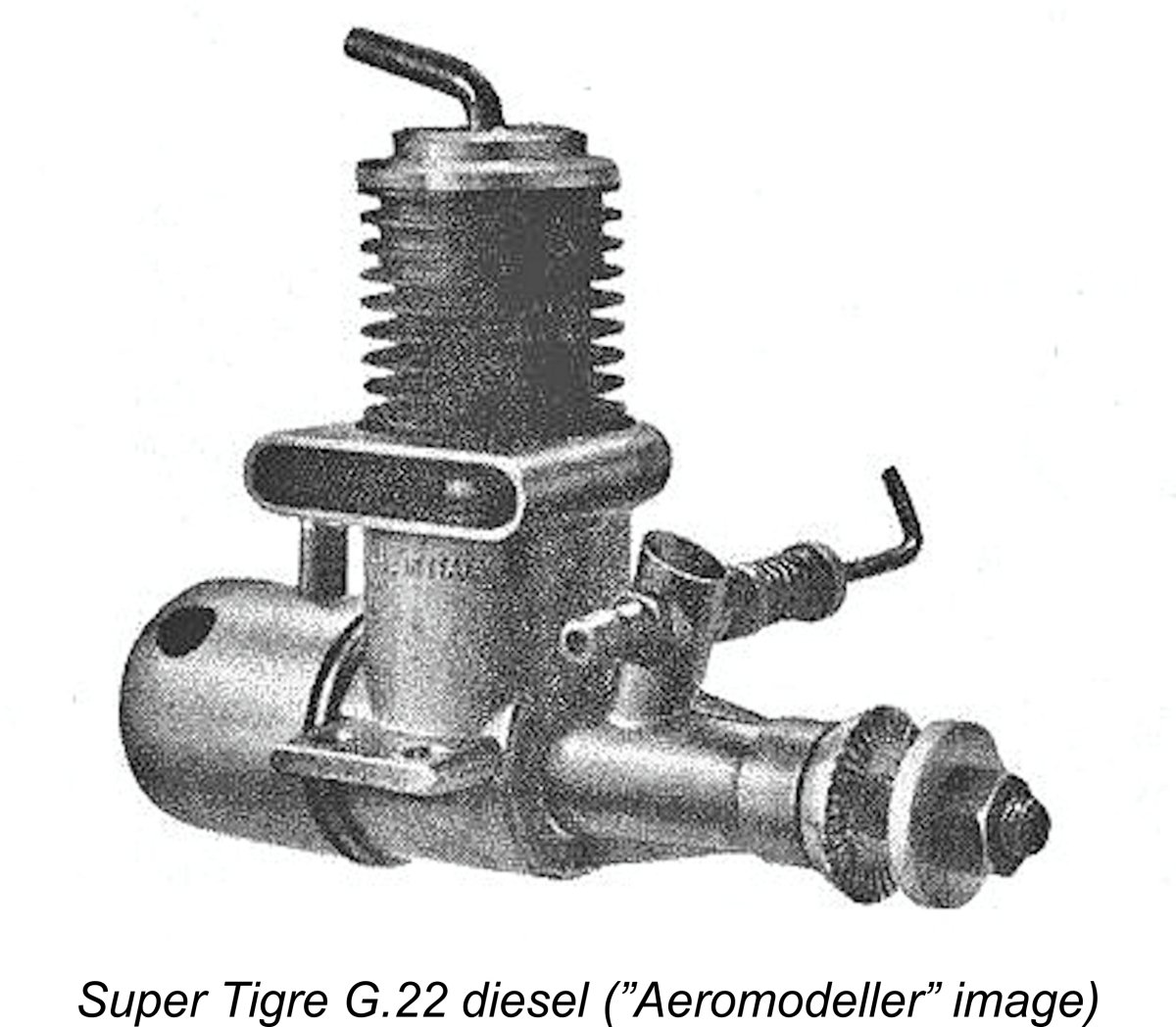 The initial result of this change in focus was the 1951 appearance of the Super Tigre G.22 “Baby Tigre,” a 1.23 cc design which appeared in both diesel and glow-plug forms. This neat little American-influenced FRV engine featured a screw-in cylinder with integral cooling fins and 360 degree radial porting for both exhaust and transfer. The cylinder of the diesel version was necessarily made considerably longer than that of the glow-plug model in order to accommodate the contra-piston. This gave the diesel version a rather “tall ‘n skinny” appearance which belied its distinctly short-stroke internal geometry of 12.5 mm and 10.0 mm for bore and stroke respectively.
The initial result of this change in focus was the 1951 appearance of the Super Tigre G.22 “Baby Tigre,” a 1.23 cc design which appeared in both diesel and glow-plug forms. This neat little American-influenced FRV engine featured a screw-in cylinder with integral cooling fins and 360 degree radial porting for both exhaust and transfer. The cylinder of the diesel version was necessarily made considerably longer than that of the glow-plug model in order to accommodate the contra-piston. This gave the diesel version a rather “tall ‘n skinny” appearance which belied its distinctly short-stroke internal geometry of 12.5 mm and 10.0 mm for bore and stroke respectively.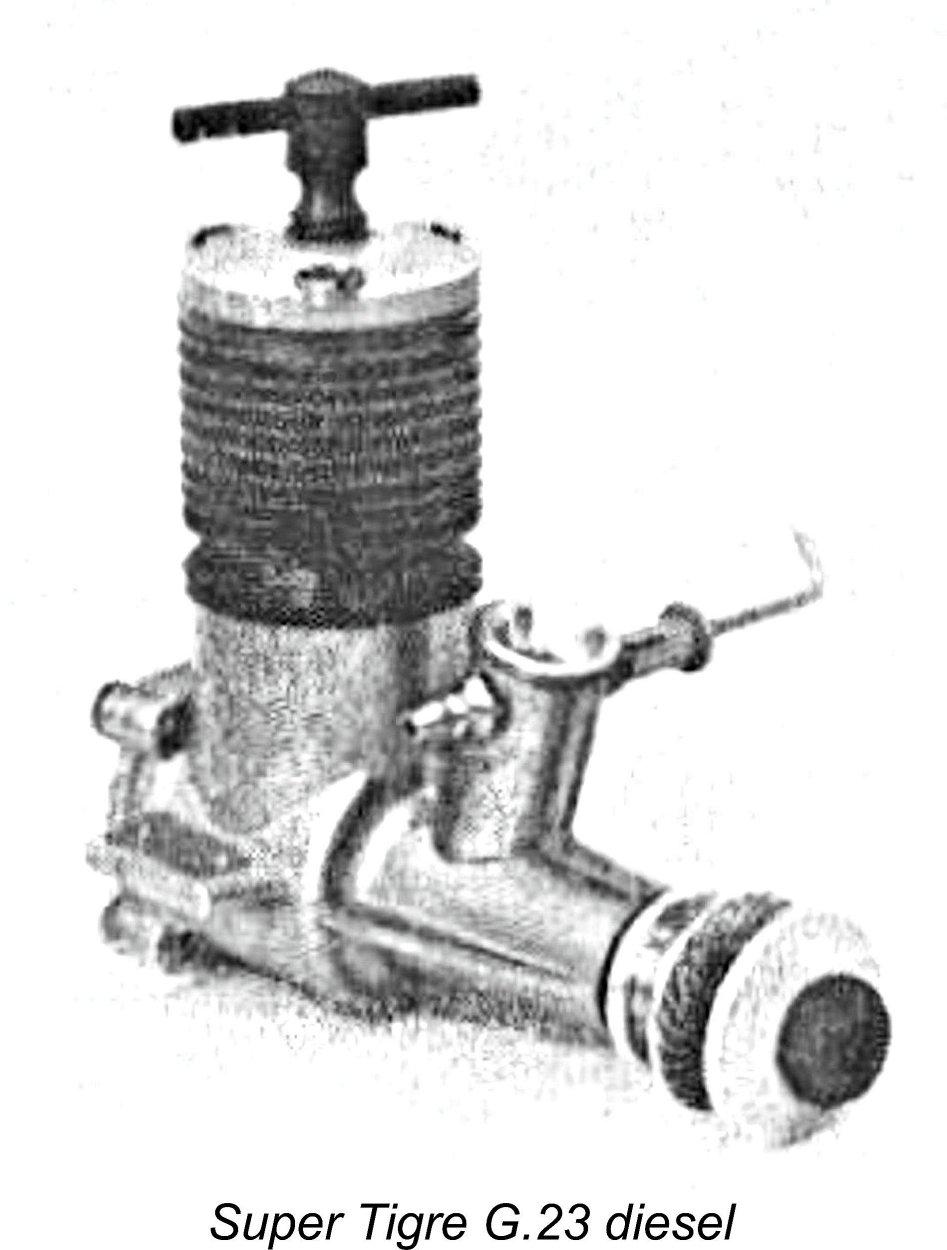 The G.22 was followed in 1953 by the G.23, a 2.47 cc plain bearing FRV diesel. This model introduced a new cylinder porting arrangement which was in effect a combination of the bypass and transfer arrangements introduced in America by Charles Brebeck of the Herkimer company, makers of the OK engines, and Leroy Cox respectively.
The G.22 was followed in 1953 by the G.23, a 2.47 cc plain bearing FRV diesel. This model introduced a new cylinder porting arrangement which was in effect a combination of the bypass and transfer arrangements introduced in America by Charles Brebeck of the Herkimer company, makers of the OK engines, and Leroy Cox respectively.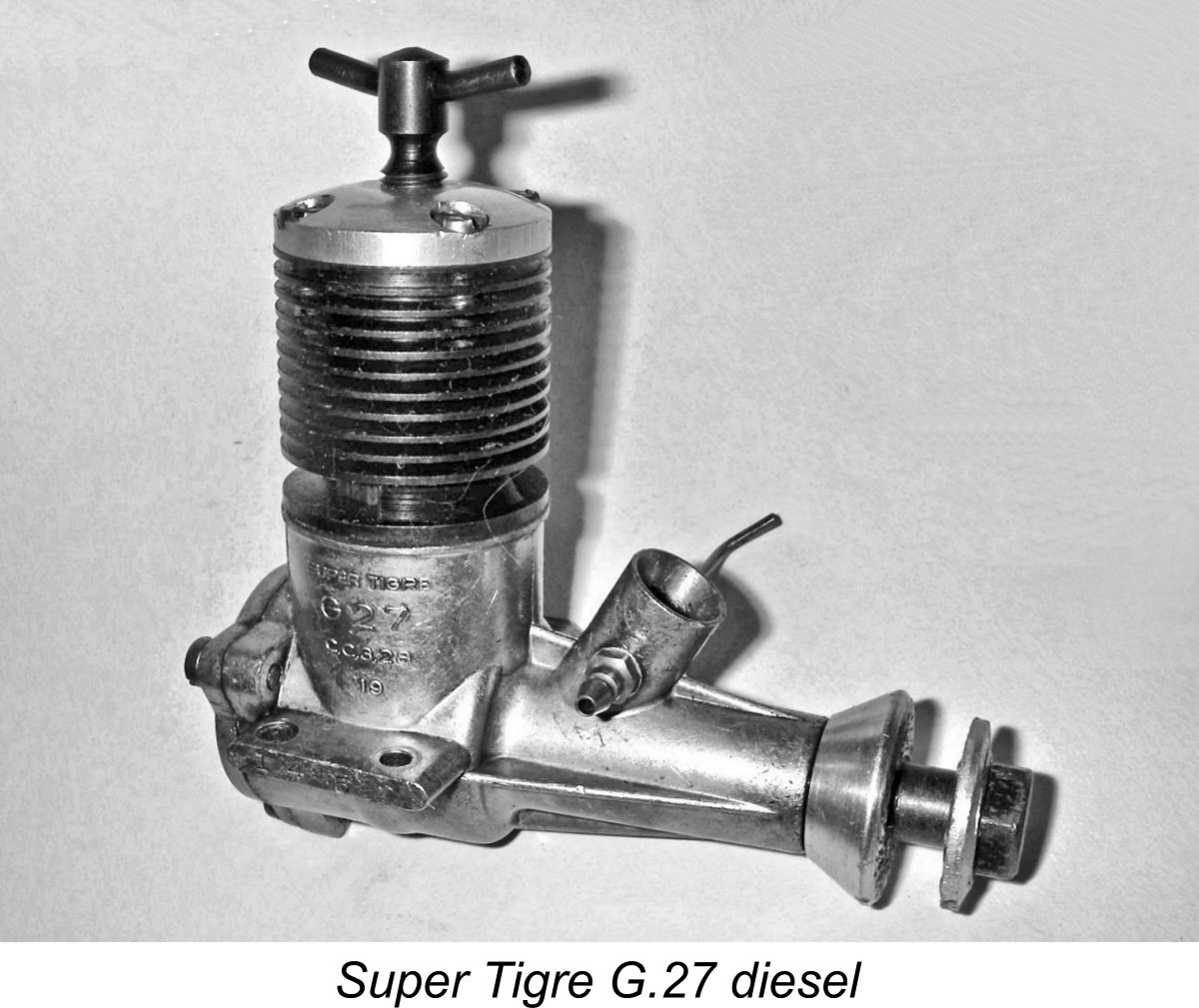 The G.25 was the subject of another published
The G.25 was the subject of another published 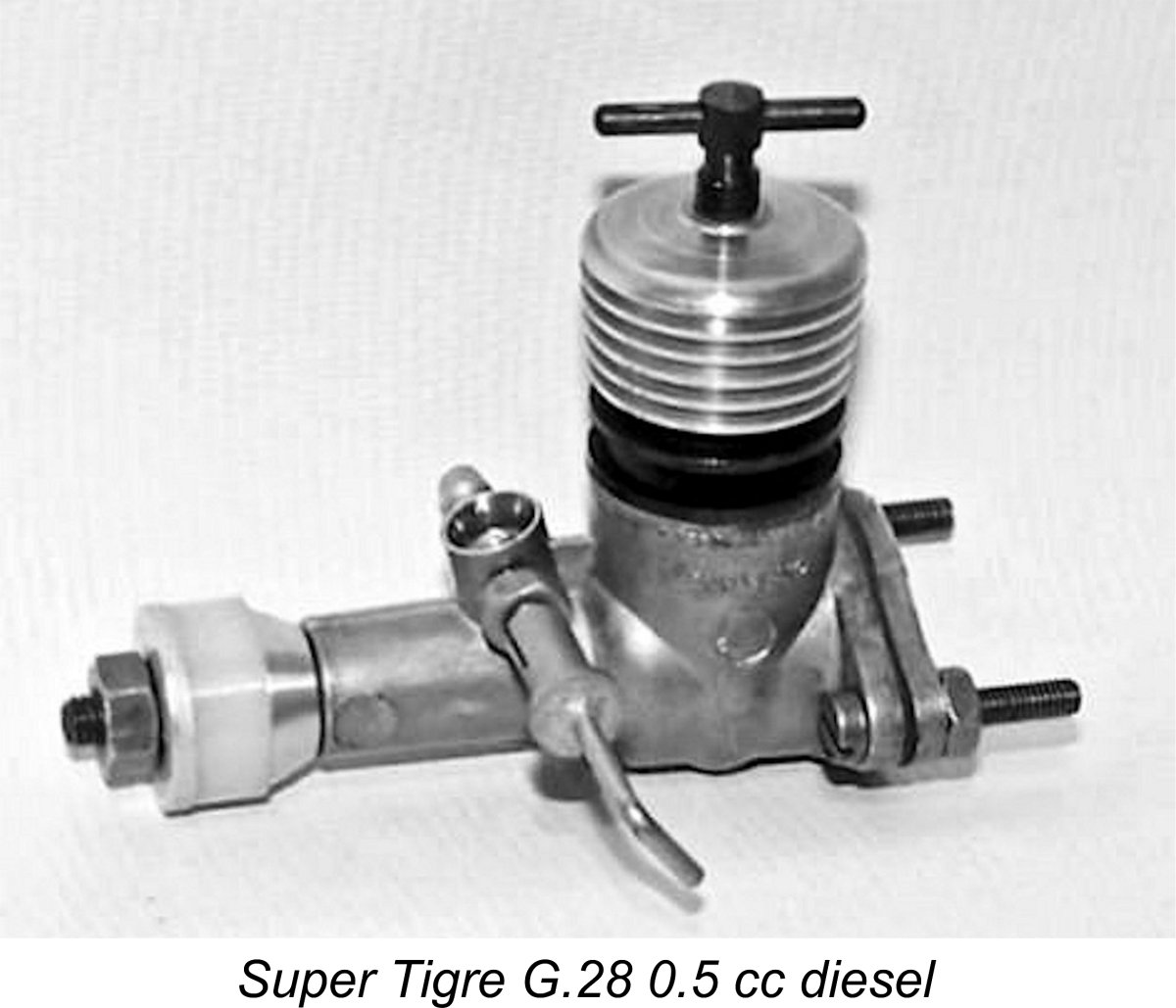 In 1955, Garofali turned his attention to the small-displacement categories which were then becoming very popular. He introduced a pair of FRV diesel engines of 0.5 cc and 0.8 cc displacements which were designated the G.28 and G.29 respectively. These neat little engines seemingly owed some elements of their design arrangement to the earlier McCoy .049 diesel from America. However, they utilized a similar cylinder porting arrangement to that seen on the earlier G.23, G.25, G.26 and G.27 models described above. The main difference was the abandonment of the integrally-turned cooling fins in favour of a separate screw-on aluminium alloy cooling jacket. The designs of the G.25 and G.26 were amended in a similar manner at the same time.
In 1955, Garofali turned his attention to the small-displacement categories which were then becoming very popular. He introduced a pair of FRV diesel engines of 0.5 cc and 0.8 cc displacements which were designated the G.28 and G.29 respectively. These neat little engines seemingly owed some elements of their design arrangement to the earlier McCoy .049 diesel from America. However, they utilized a similar cylinder porting arrangement to that seen on the earlier G.23, G.25, G.26 and G.27 models described above. The main difference was the abandonment of the integrally-turned cooling fins in favour of a separate screw-on aluminium alloy cooling jacket. The designs of the G.25 and G.26 were amended in a similar manner at the same time.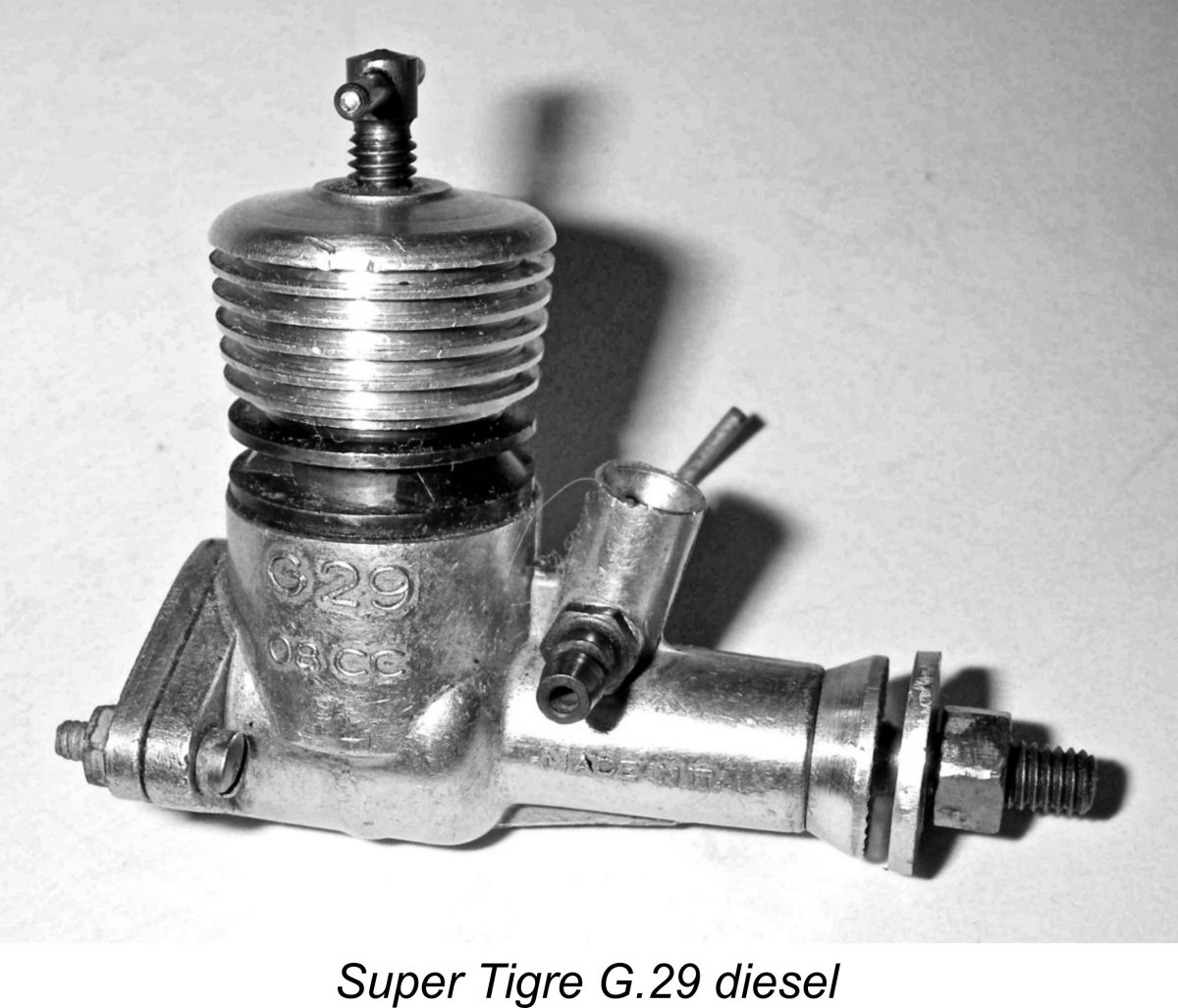 It appears that the switch to a separate screw-on aluminium alloy cooling jacket on these models was motivated in large part by the fact that it facilitated the development of glow-plug versions of these engines. The G.25, G.26, G.28 and G.29 all duly appeared in glow-plug form for 1955. They were all listed in Peter Chinn’s summary of glow-plug engines for 1954-55 which appeared in the May 1955 issue of “Model Aircraft”. The G.28 and G.29 glow-plug models utilized glow heads instead of conventional glow-plugs. These were secured in place by the screw-on cylinder jackets. An outboard motor version of the G.29 glow-plug model was also produced.
It appears that the switch to a separate screw-on aluminium alloy cooling jacket on these models was motivated in large part by the fact that it facilitated the development of glow-plug versions of these engines. The G.25, G.26, G.28 and G.29 all duly appeared in glow-plug form for 1955. They were all listed in Peter Chinn’s summary of glow-plug engines for 1954-55 which appeared in the May 1955 issue of “Model Aircraft”. The G.28 and G.29 glow-plug models utilized glow heads instead of conventional glow-plugs. These were secured in place by the screw-on cylinder jackets. An outboard motor version of the G.29 glow-plug model was also produced. 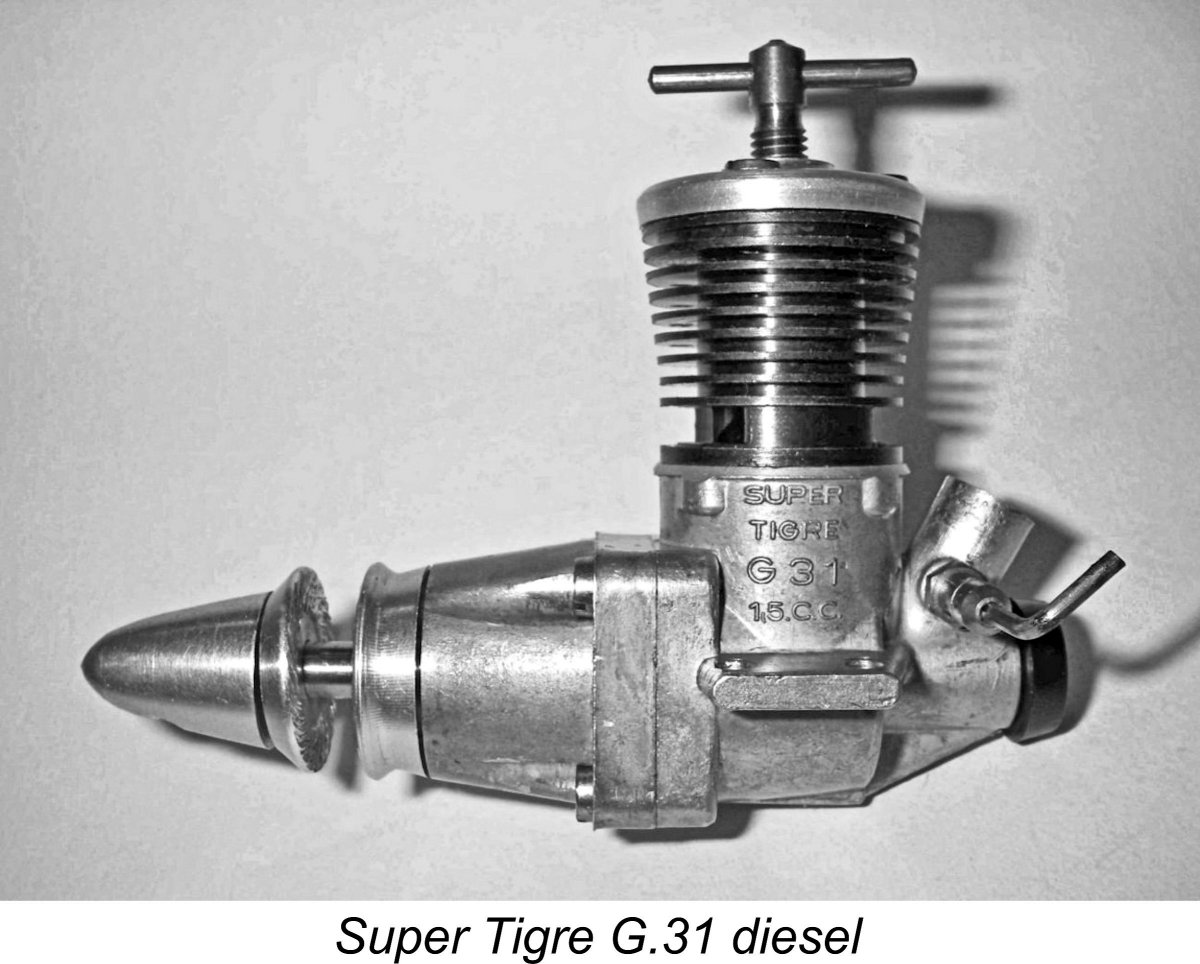 This engine was something of a hybrid, utilizing a variant of the cylinder porting system seen in the earlier G.23 and G.25 through G.29 models, but also featuring a rear drum valve induction system similar to that which had appeared much earlier on the 10 cc G.24 racing engine of 1953. The G.31 was also the first officially-released Super Tigre diesel since the original G.19 to feature a twin ball-race crankshaft.
This engine was something of a hybrid, utilizing a variant of the cylinder porting system seen in the earlier G.23 and G.25 through G.29 models, but also featuring a rear drum valve induction system similar to that which had appeared much earlier on the 10 cc G.24 racing engine of 1953. The G.31 was also the first officially-released Super Tigre diesel since the original G.19 to feature a twin ball-race crankshaft.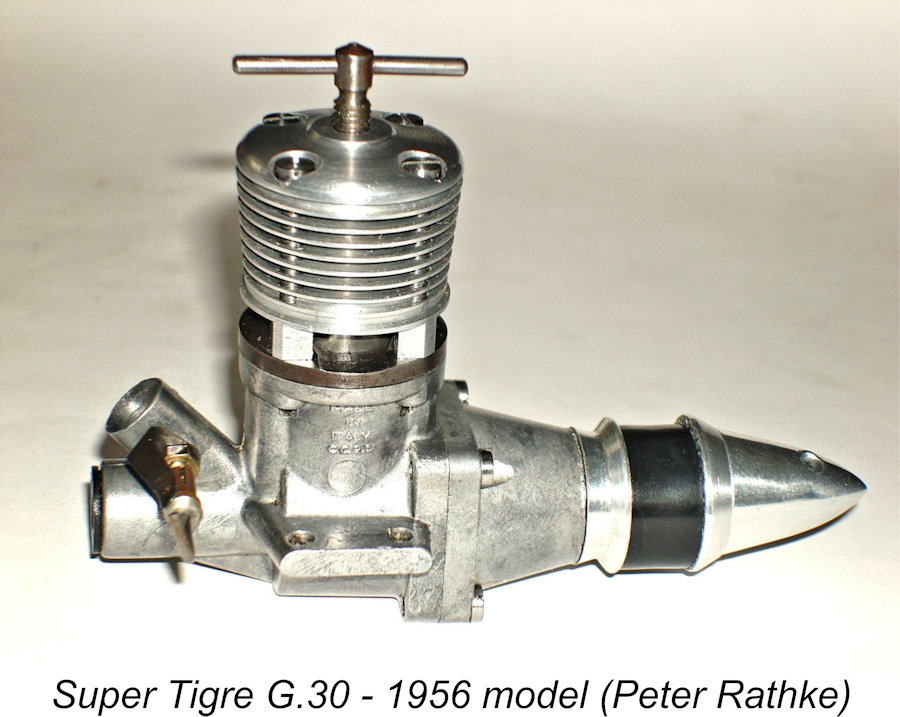

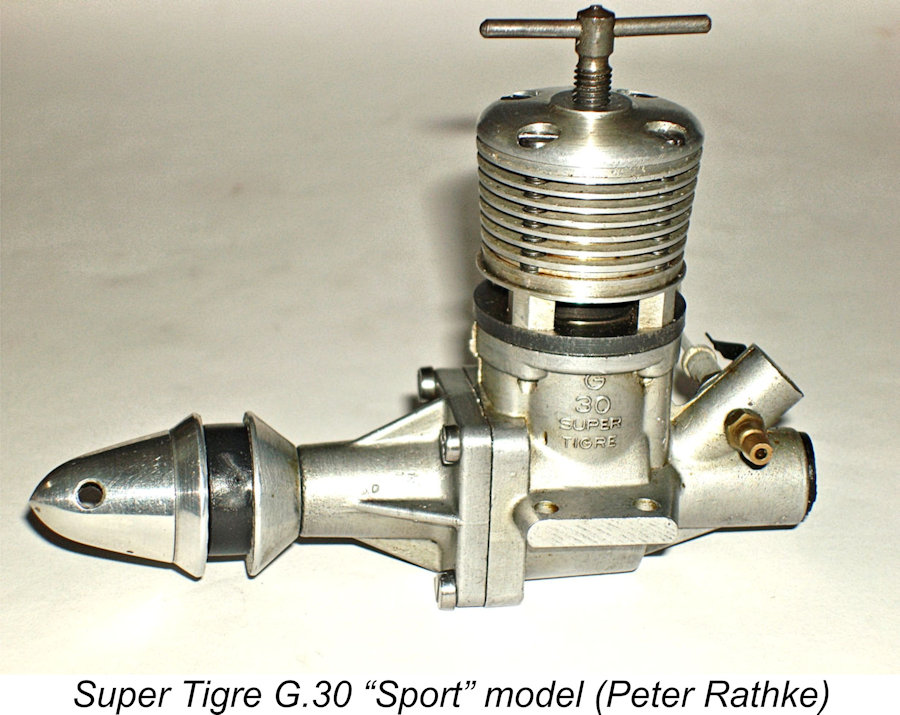 In early 1958 a simplified "Sport" version of the G.30 appeared. This featured a revised front housing incorporating a plain bearing in place of the twin ball-races of the original G.30. It was otherwise identical to the original design. Intended for general purpose use, it does not appear to have attracted much sales interest, hence being made in relatively small numbers. It is quite a rare engine today, especially outside Italy. I have heard unsubstantiated reports that a similar plain-bearing version of the G.31 was also produced, but I have been unable to confirm this.
In early 1958 a simplified "Sport" version of the G.30 appeared. This featured a revised front housing incorporating a plain bearing in place of the twin ball-races of the original G.30. It was otherwise identical to the original design. Intended for general purpose use, it does not appear to have attracted much sales interest, hence being made in relatively small numbers. It is quite a rare engine today, especially outside Italy. I have heard unsubstantiated reports that a similar plain-bearing version of the G.31 was also produced, but I have been unable to confirm this.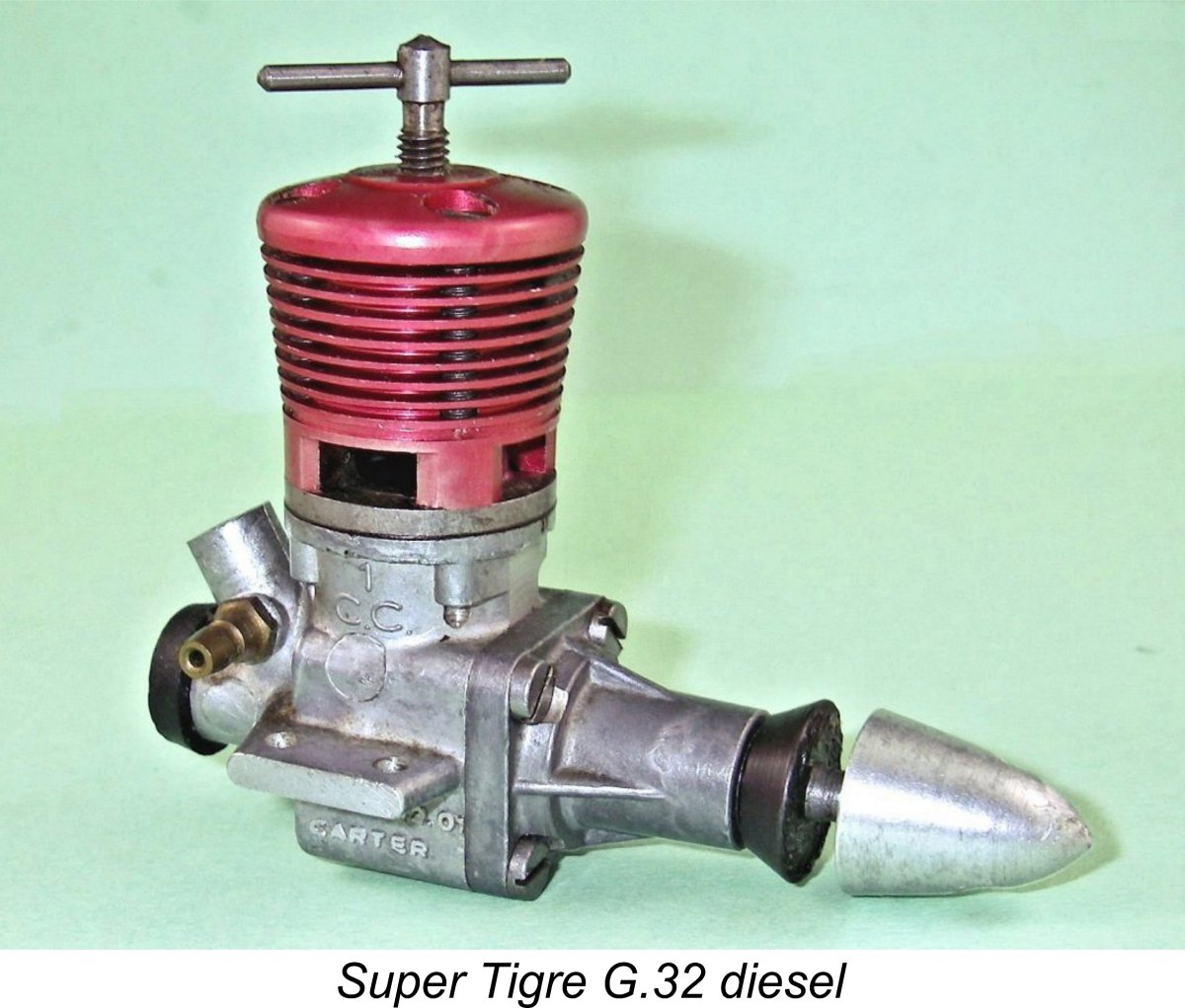 First out of the starting gate was Ron Warring, whose
First out of the starting gate was Ron Warring, whose 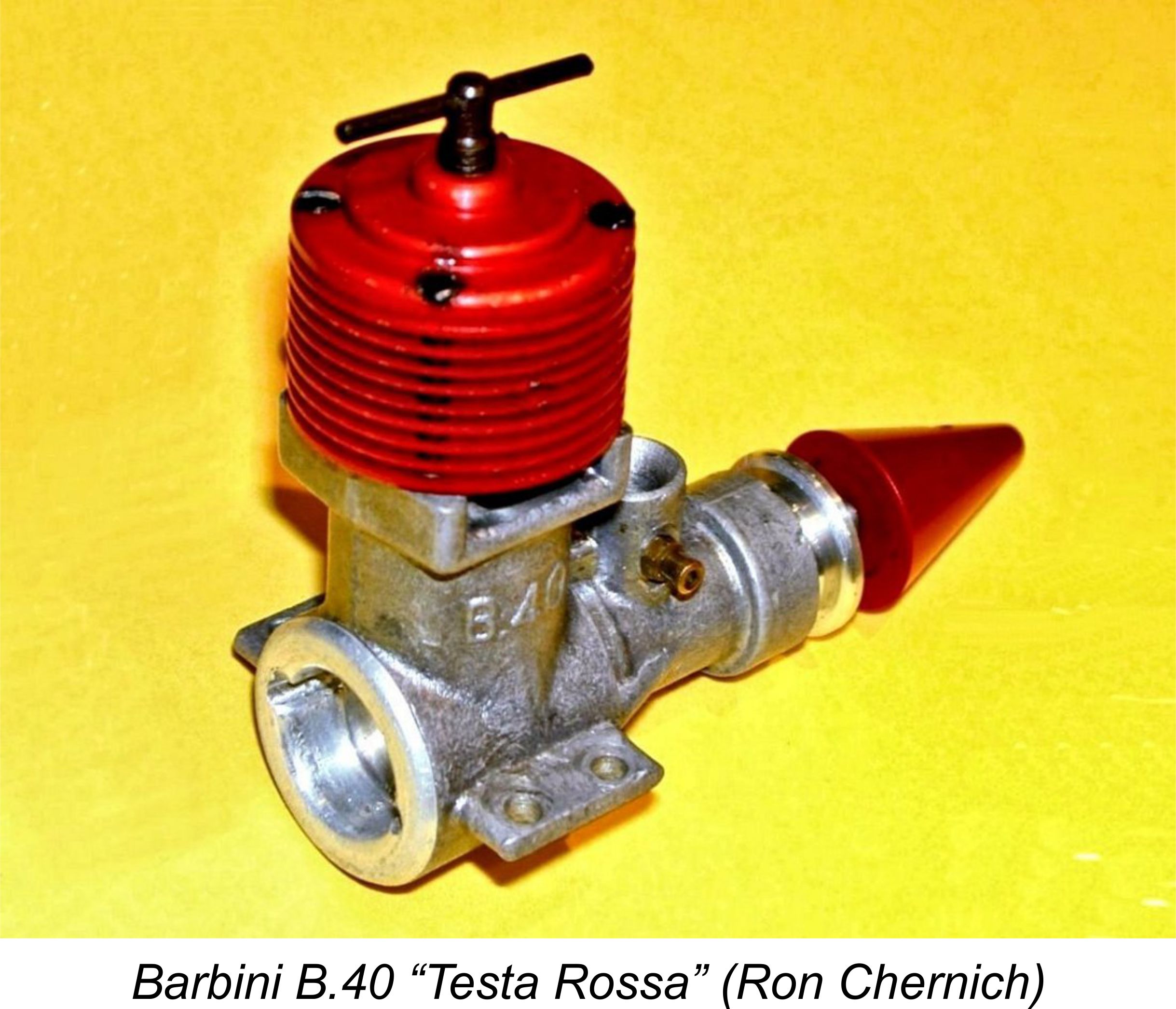
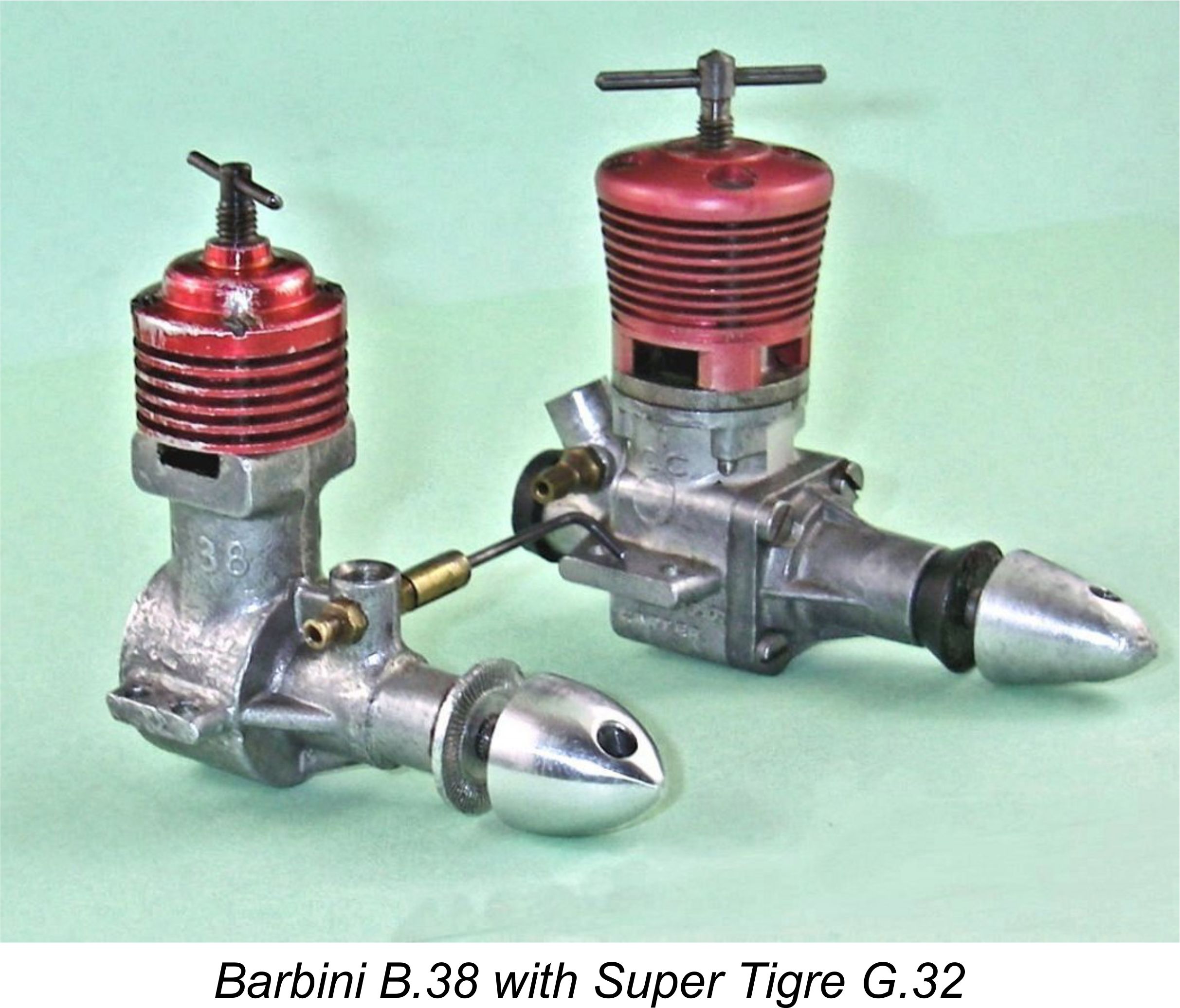
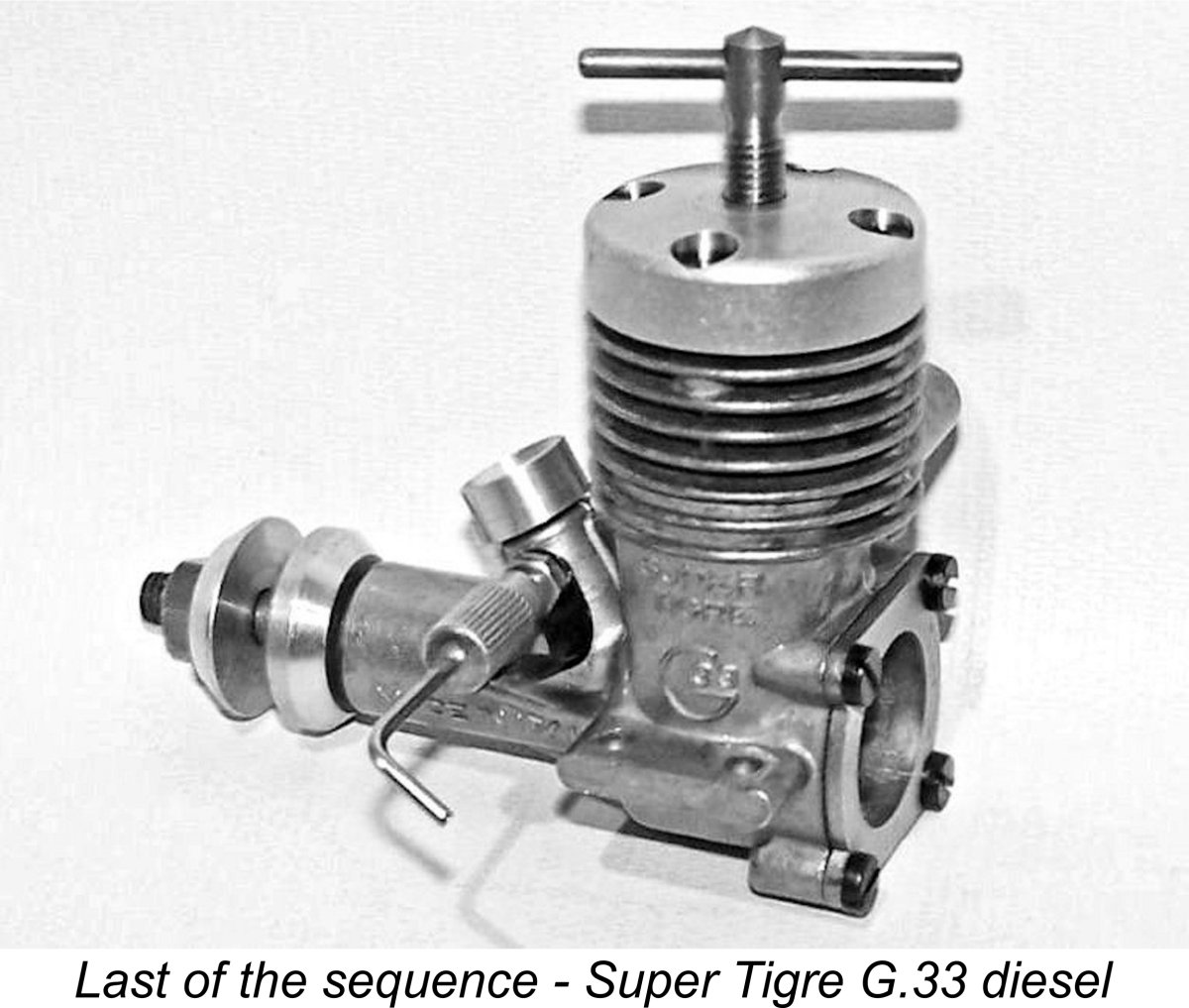 Well ........ almost!! There was actually one more Super Tigre design which followed the original model identification protocol. This was the Super Tigre G.33, another sports engine which appeared out of the blue in 1964 in both diesel and glow-plug configurations. The displacements of the two variants differed, the diesel having a displacement of 1.46 cc while the glow-plug version sported a figure of 1.70 cc.
Well ........ almost!! There was actually one more Super Tigre design which followed the original model identification protocol. This was the Super Tigre G.33, another sports engine which appeared out of the blue in 1964 in both diesel and glow-plug configurations. The displacements of the two variants differed, the diesel having a displacement of 1.46 cc while the glow-plug version sported a figure of 1.70 cc.